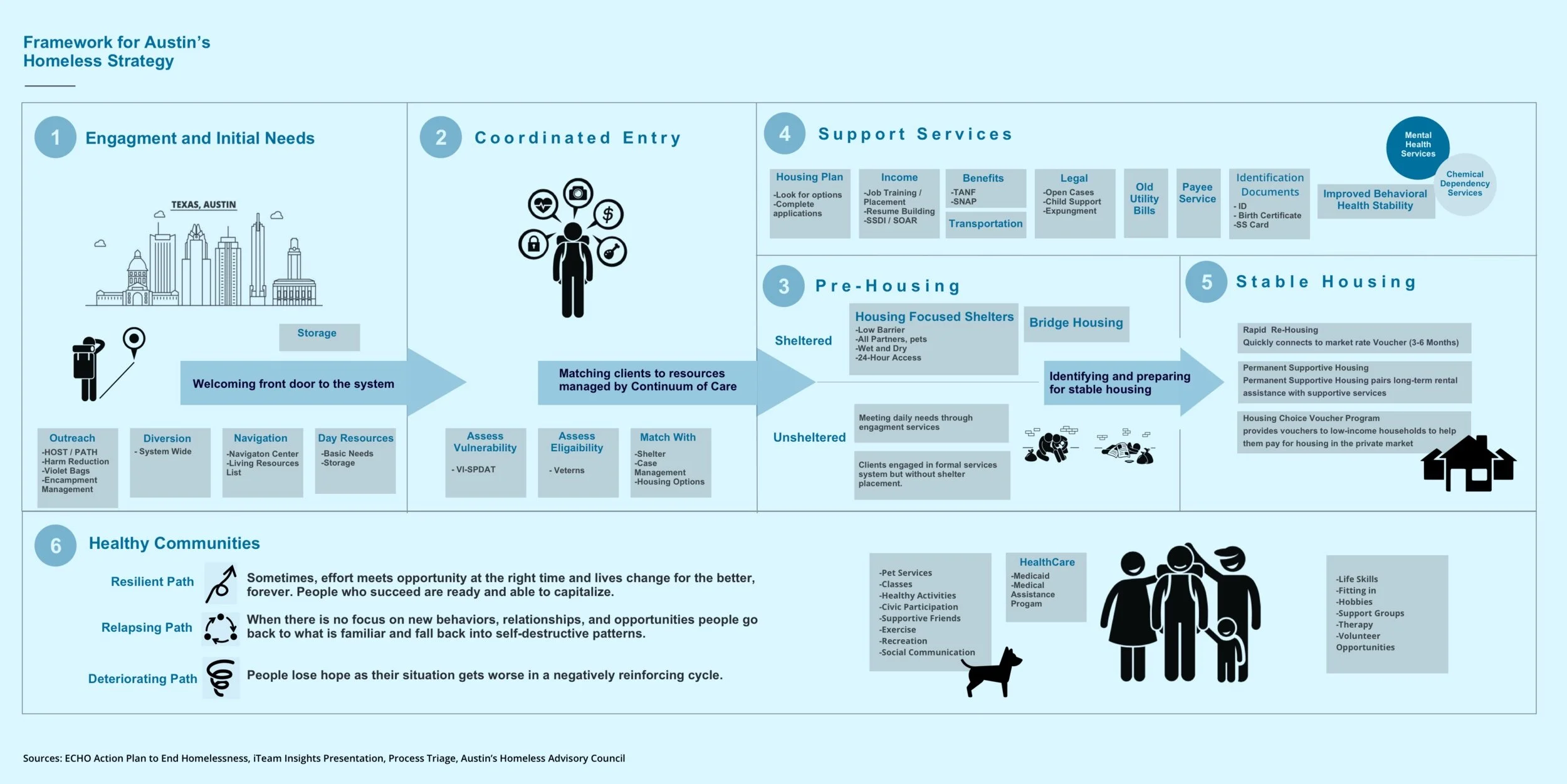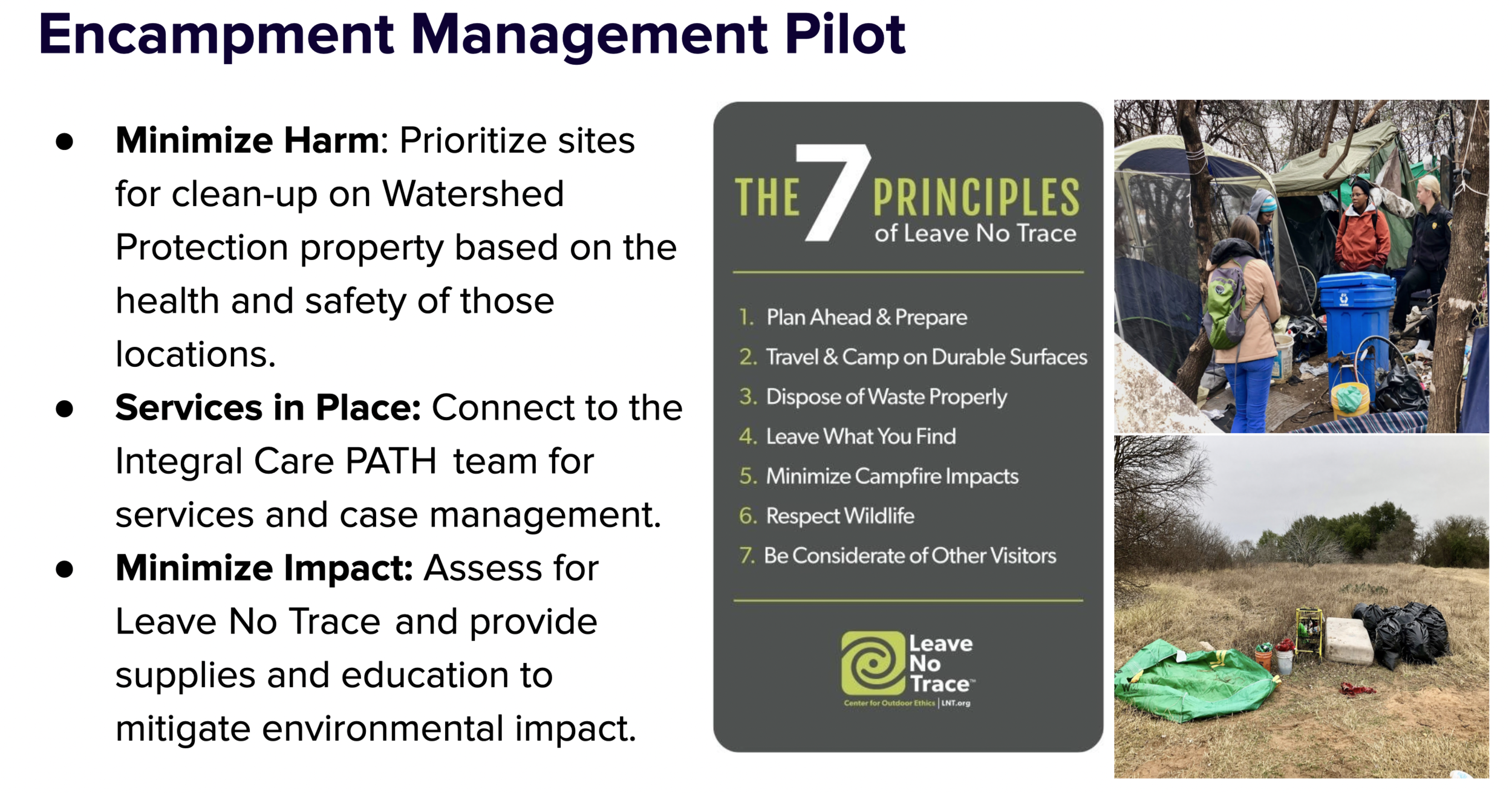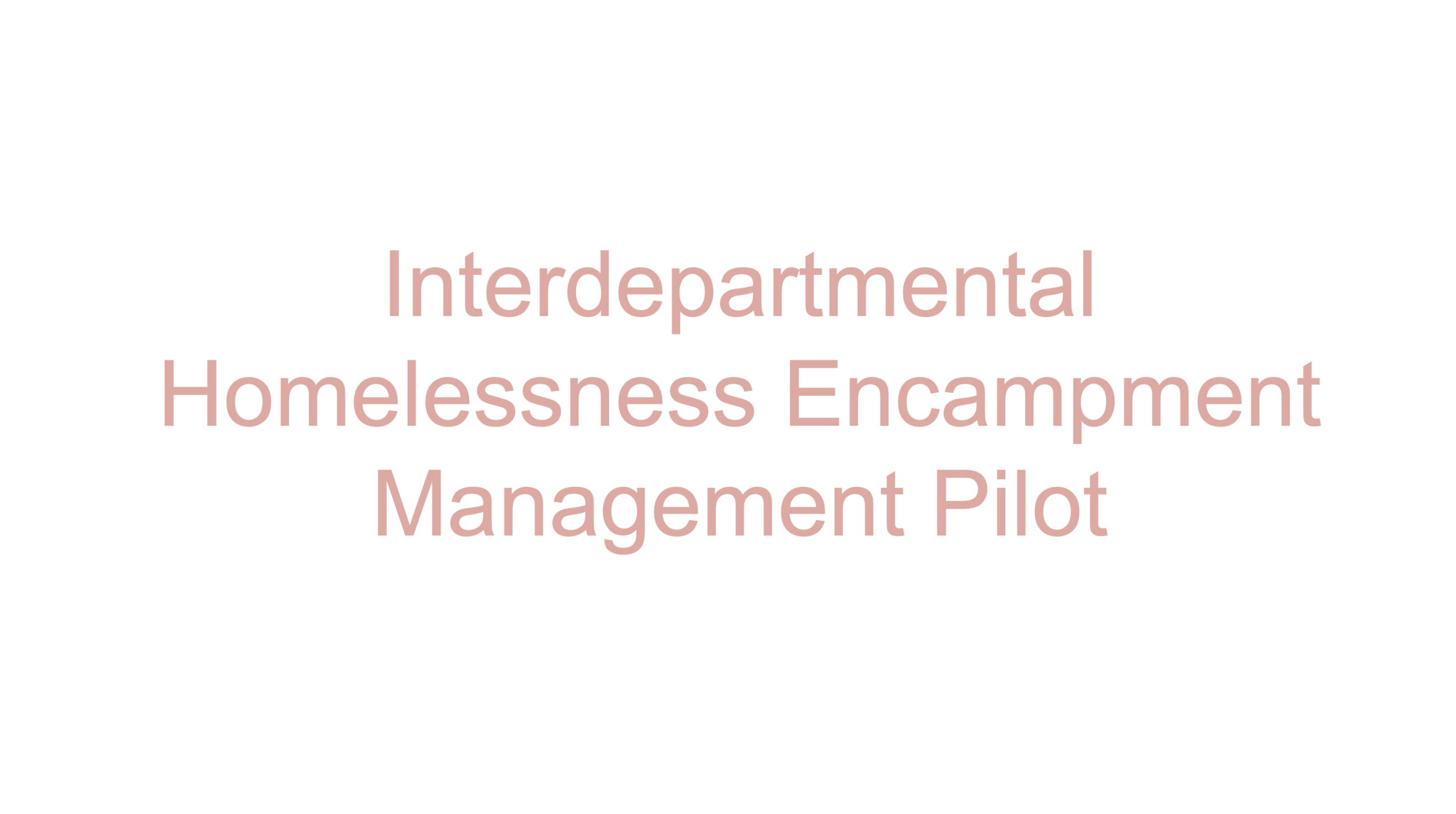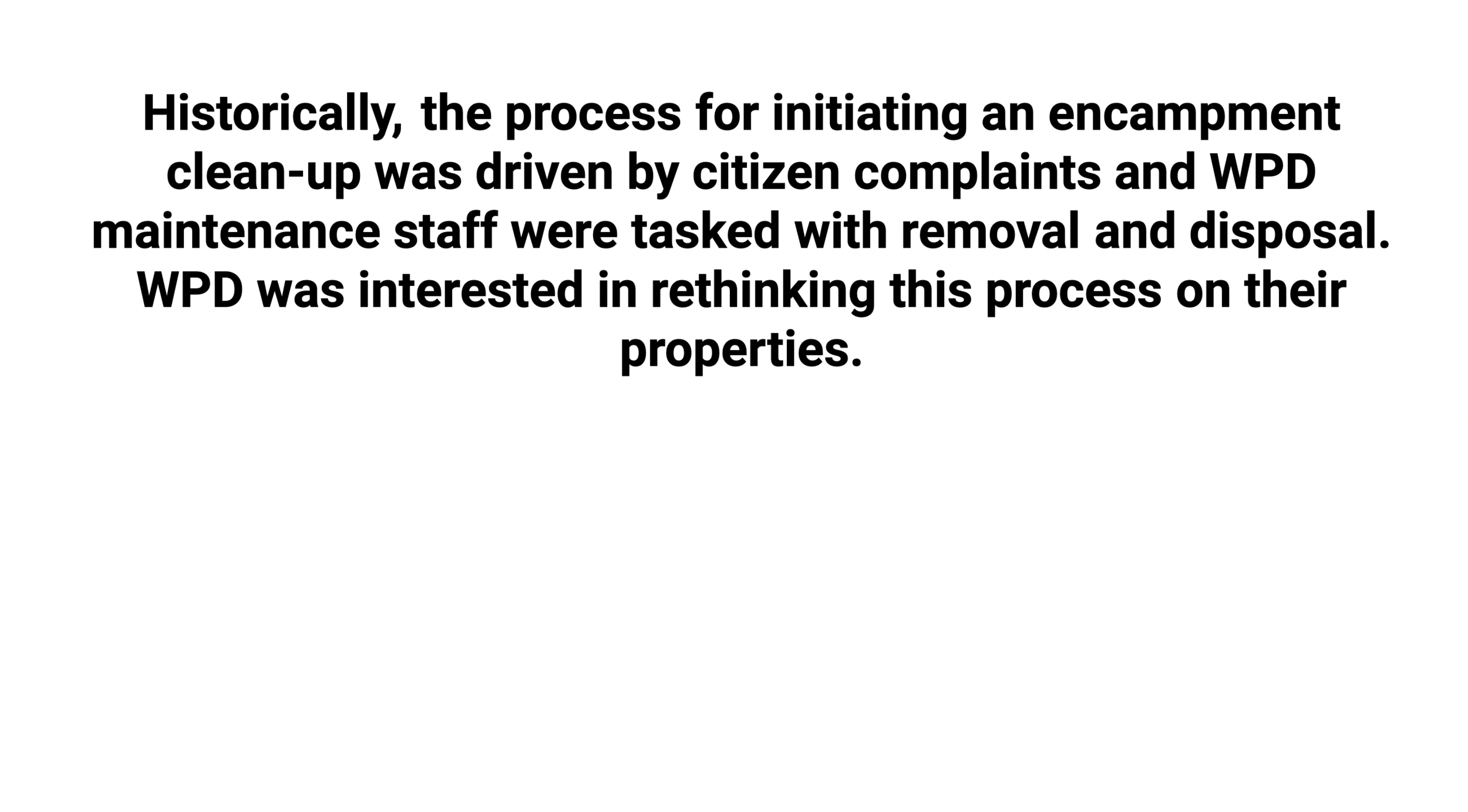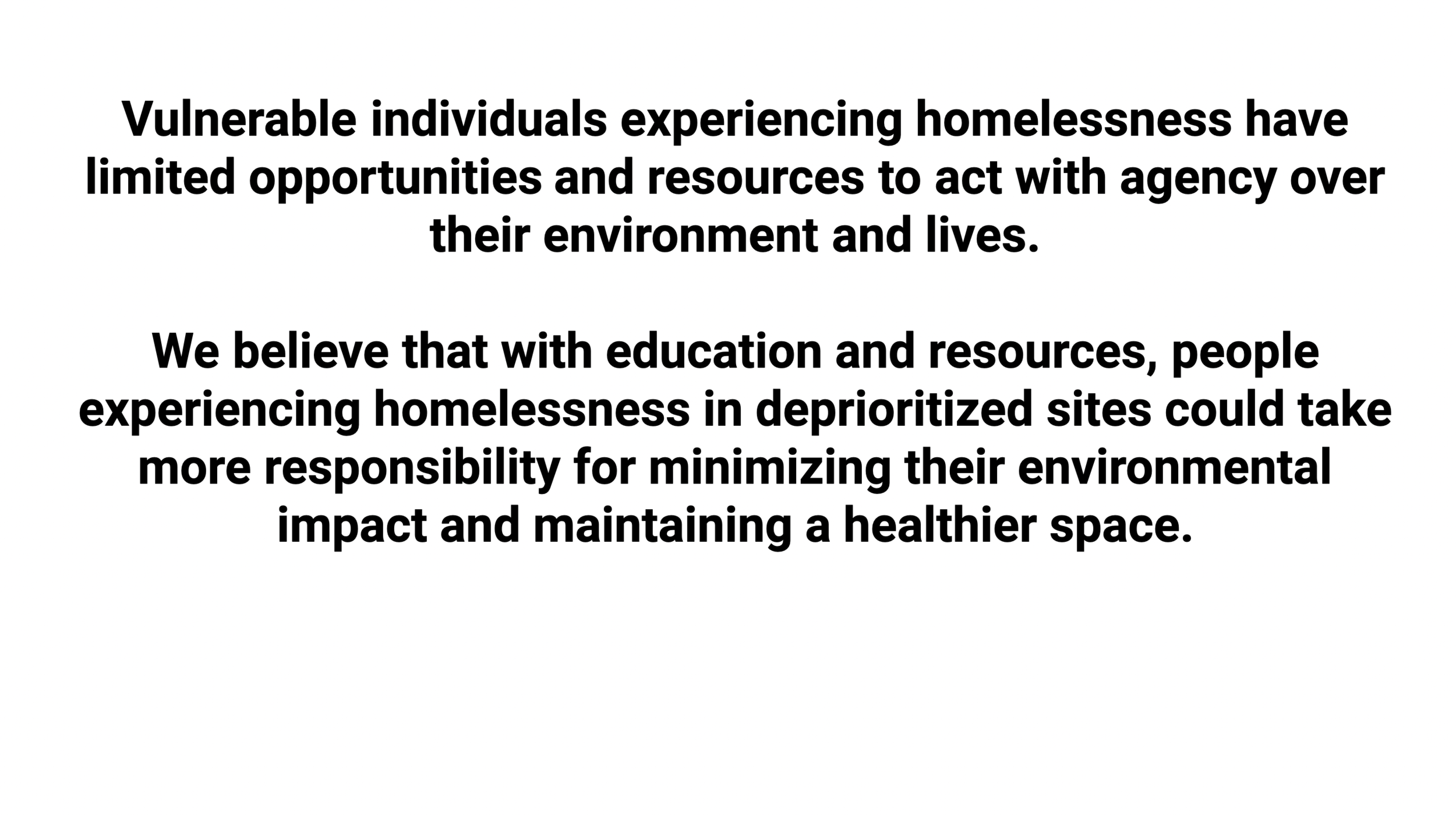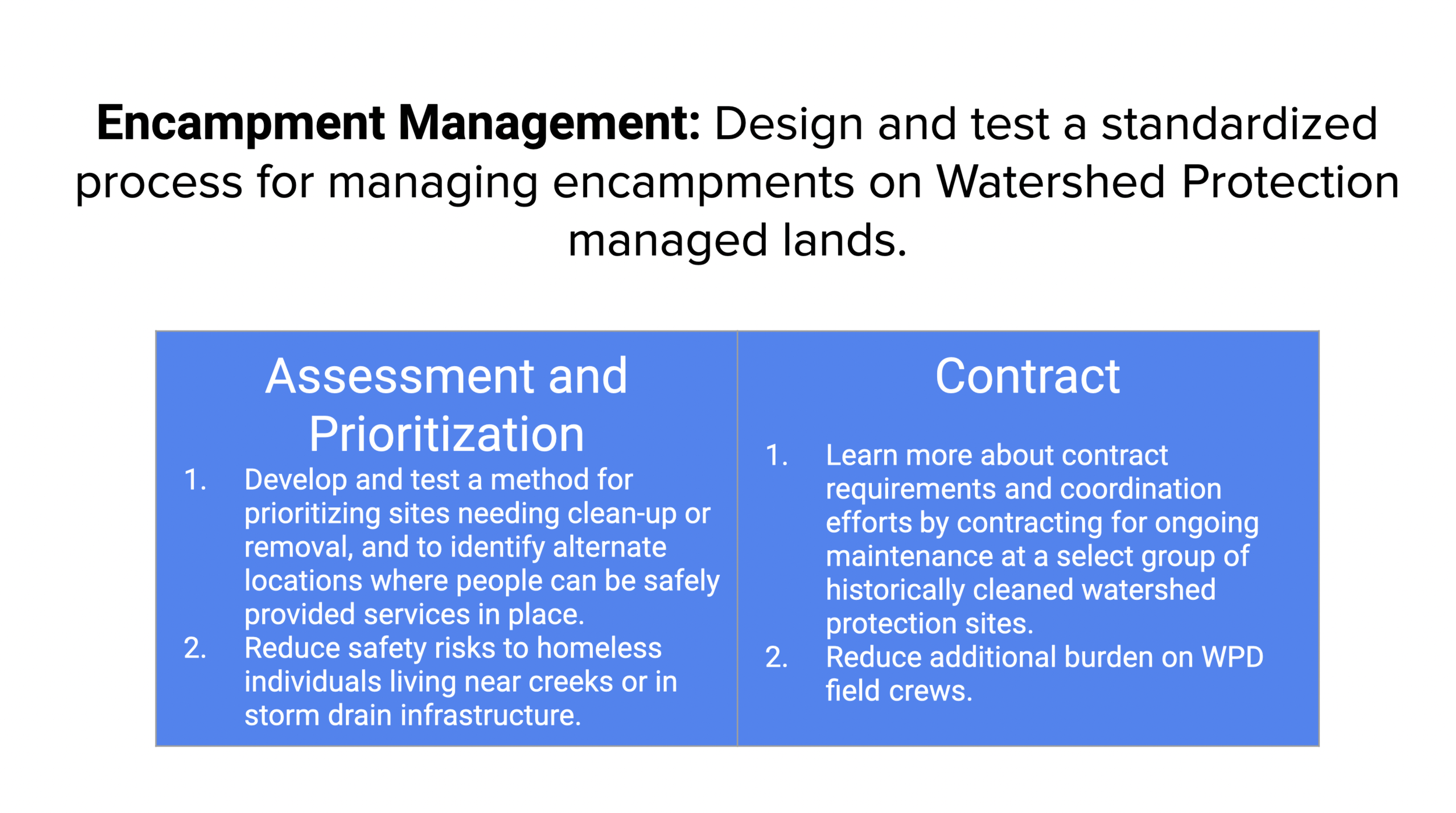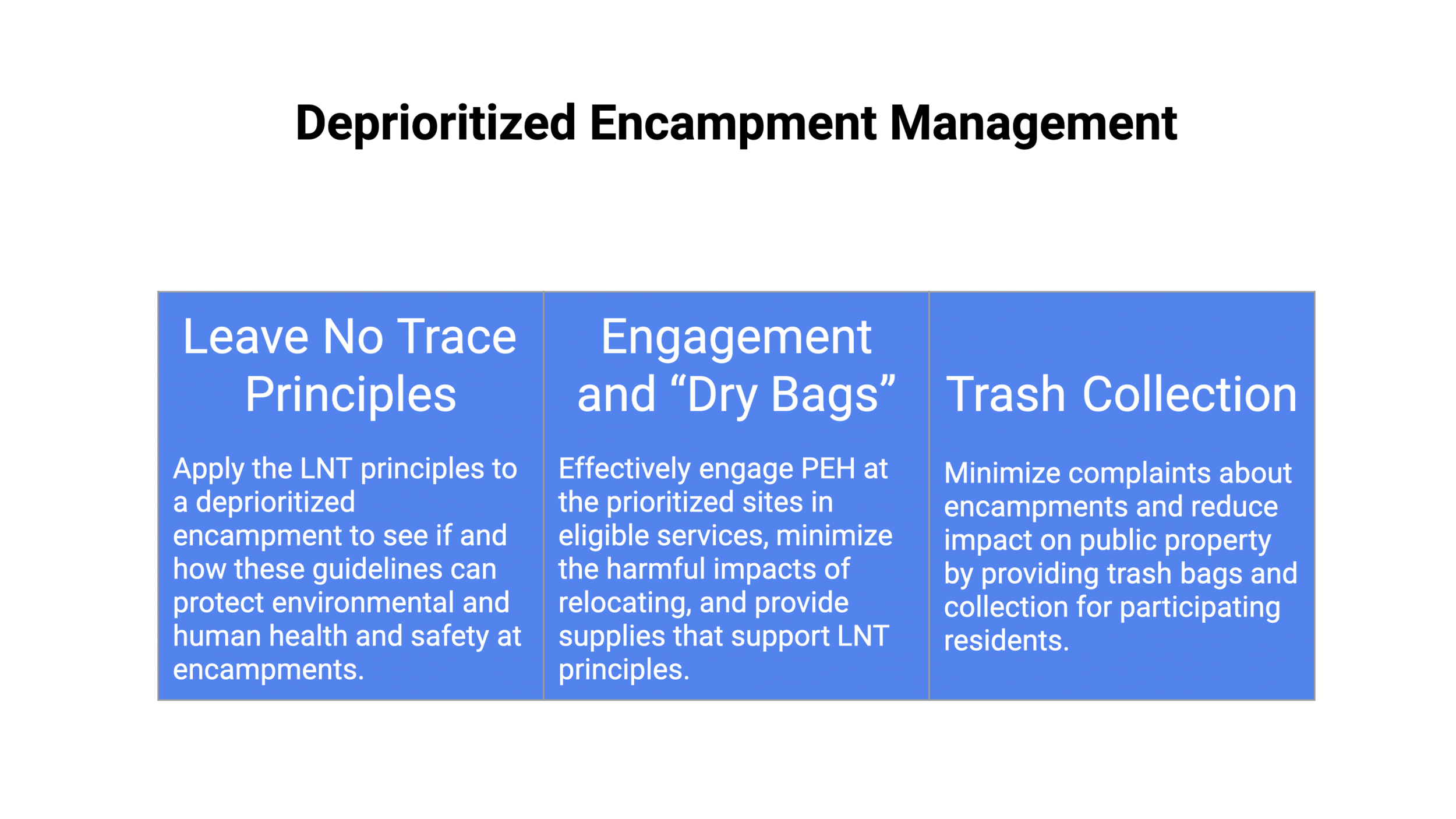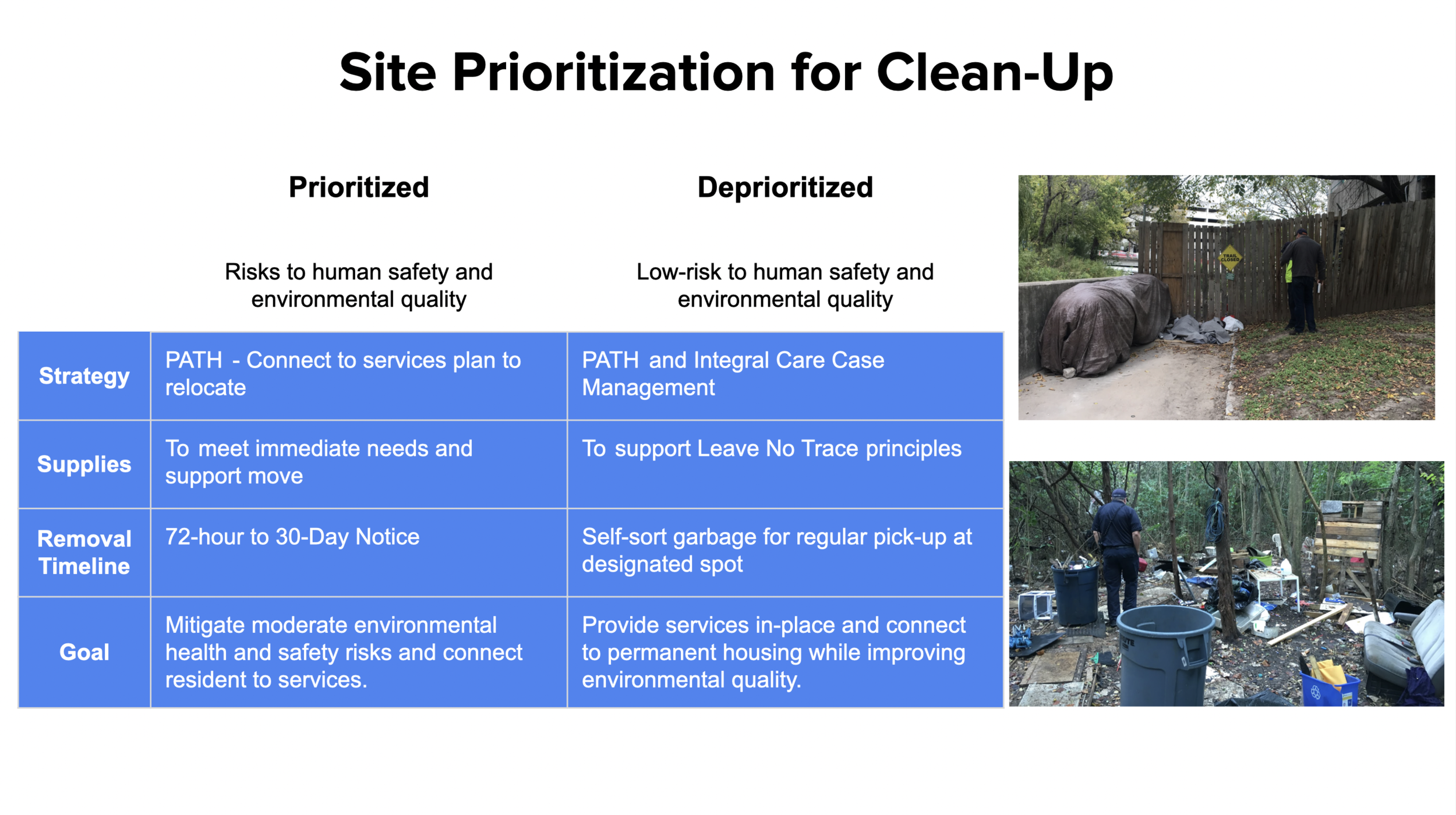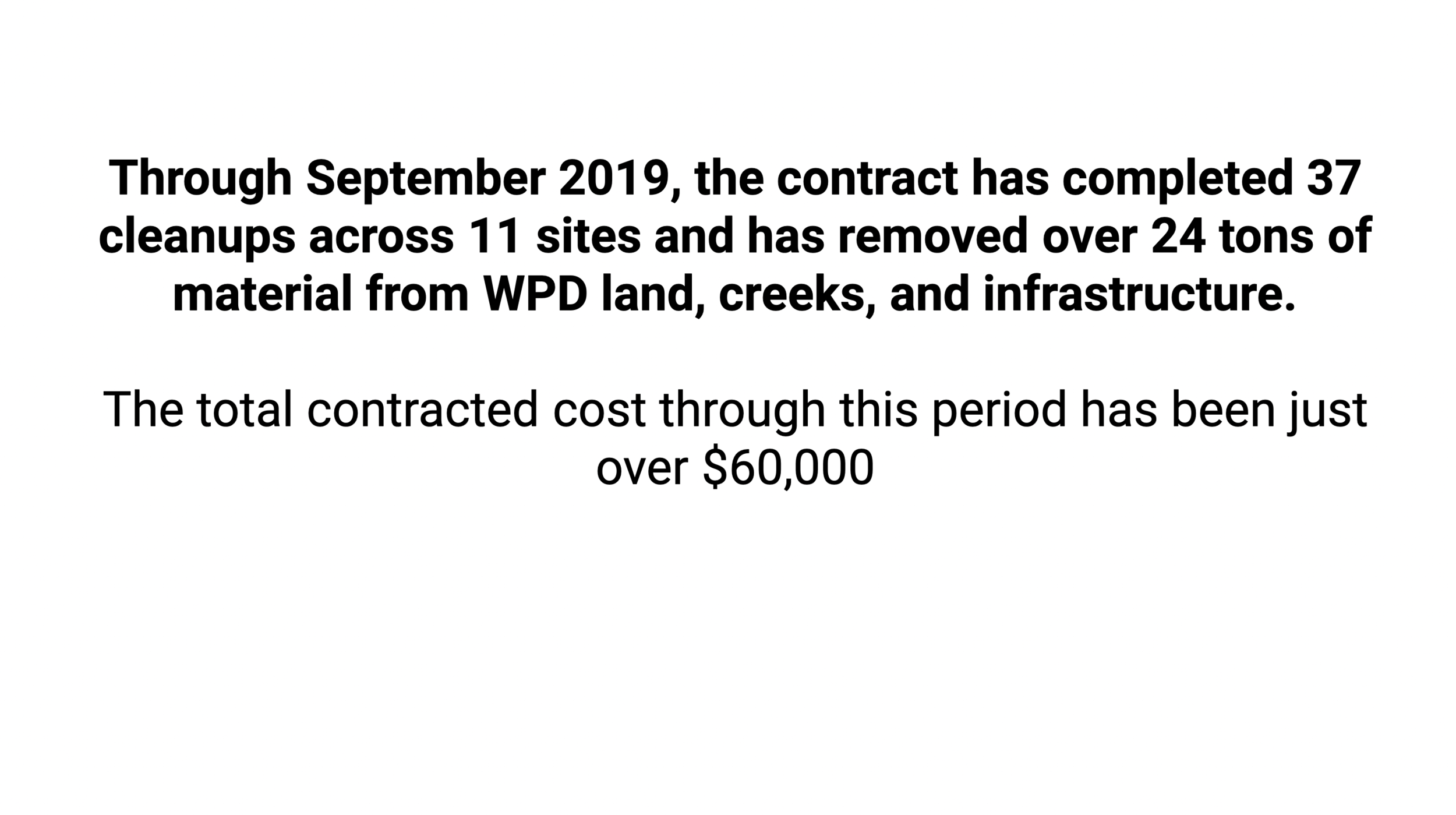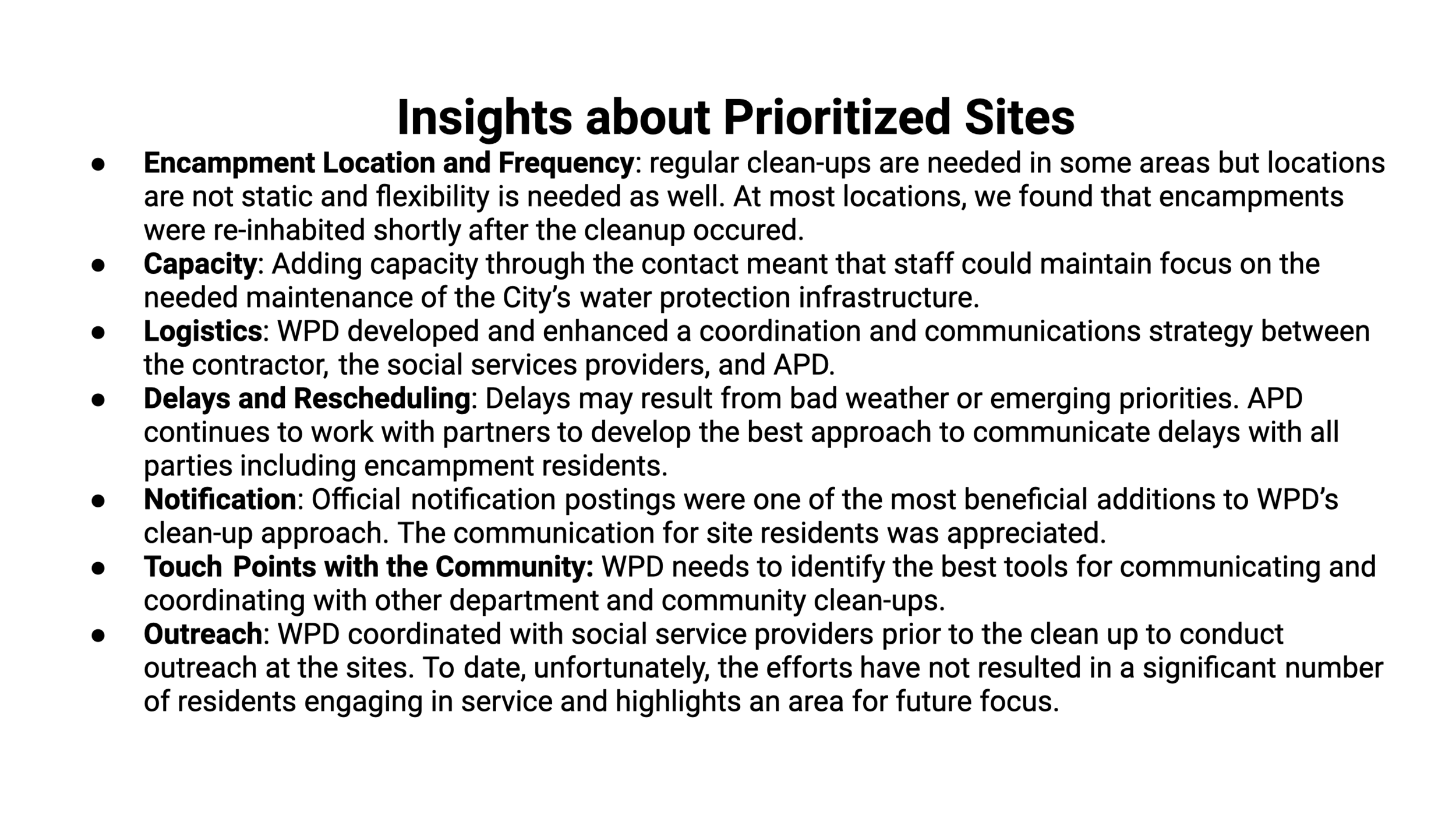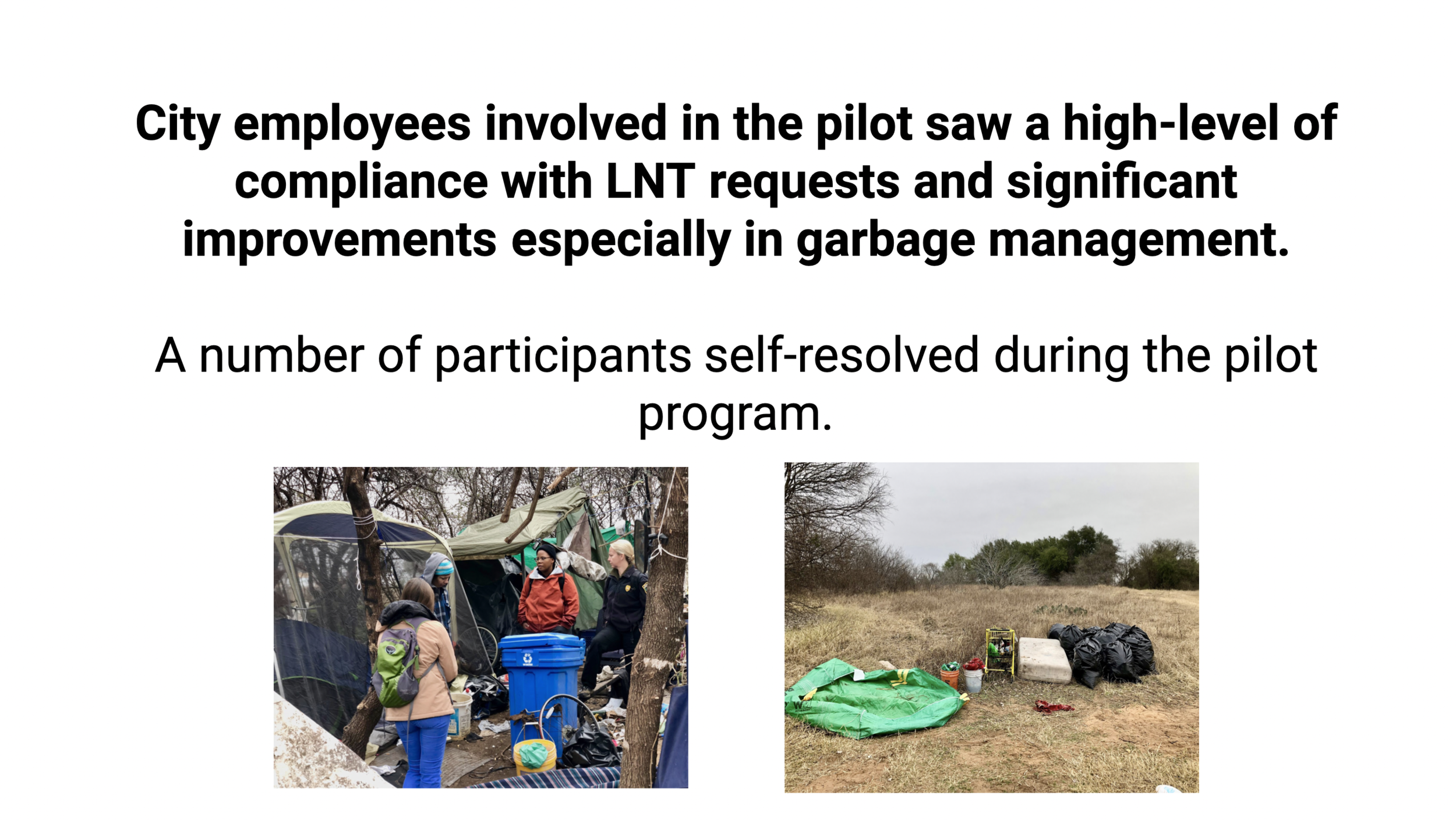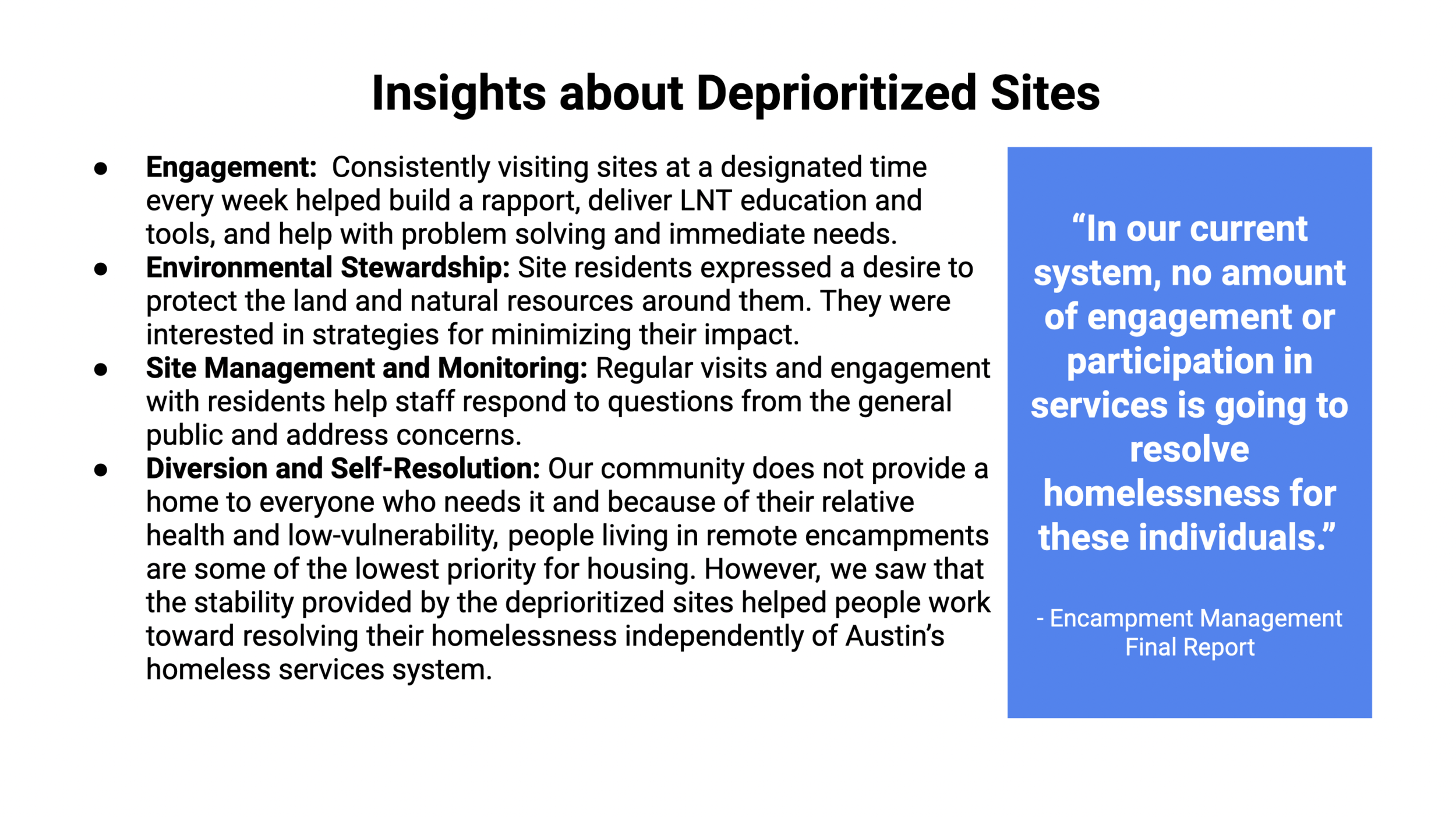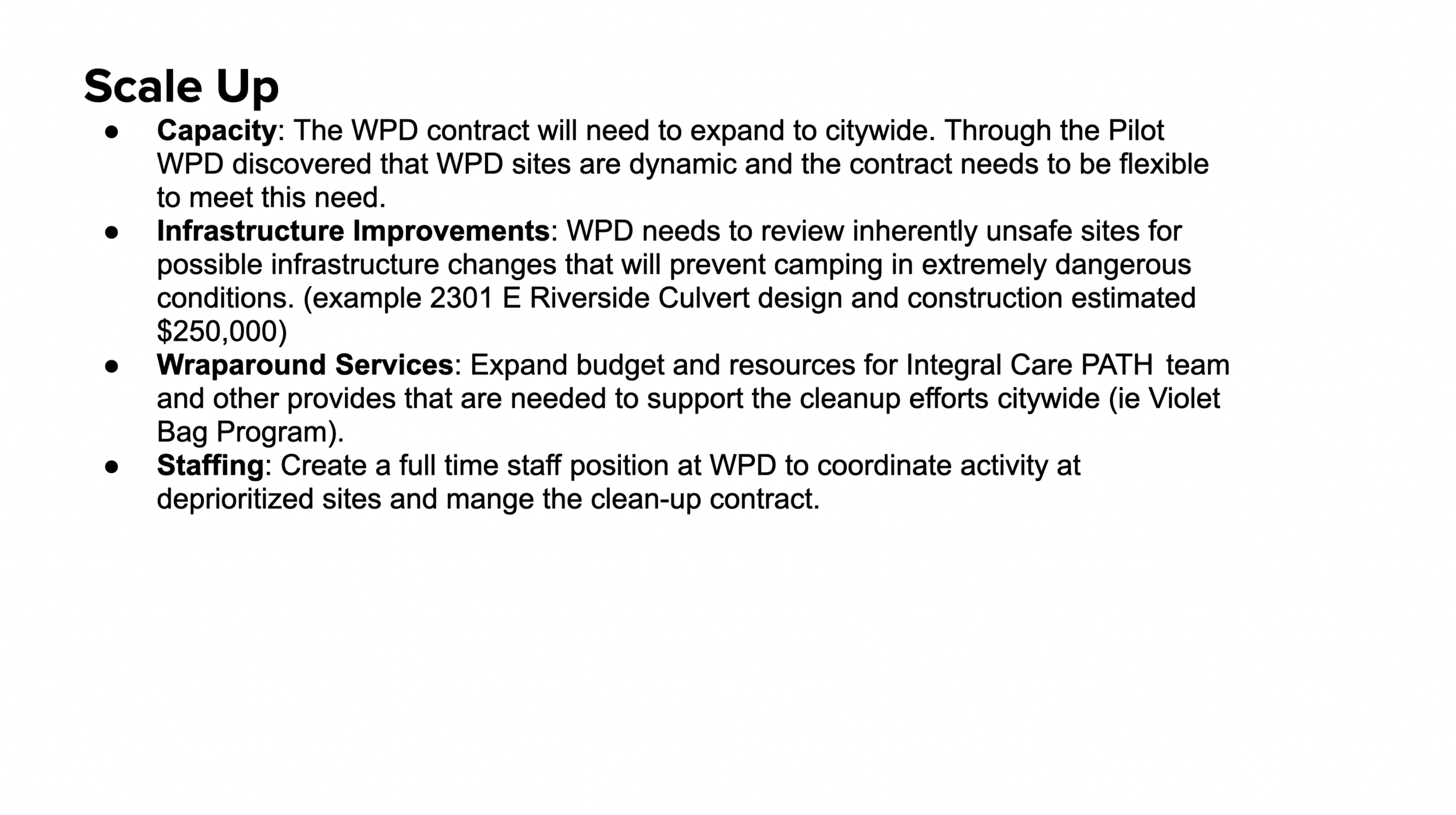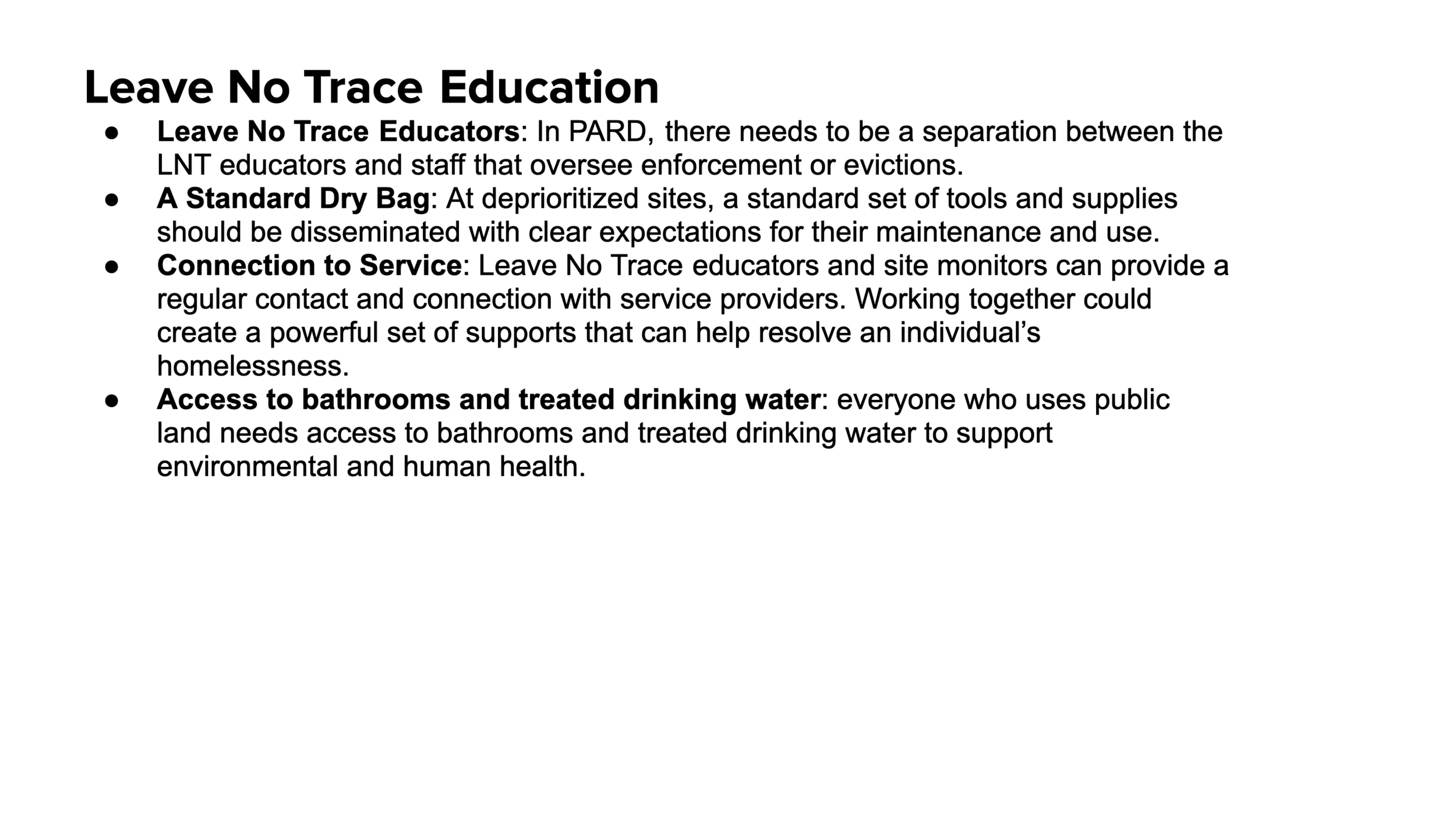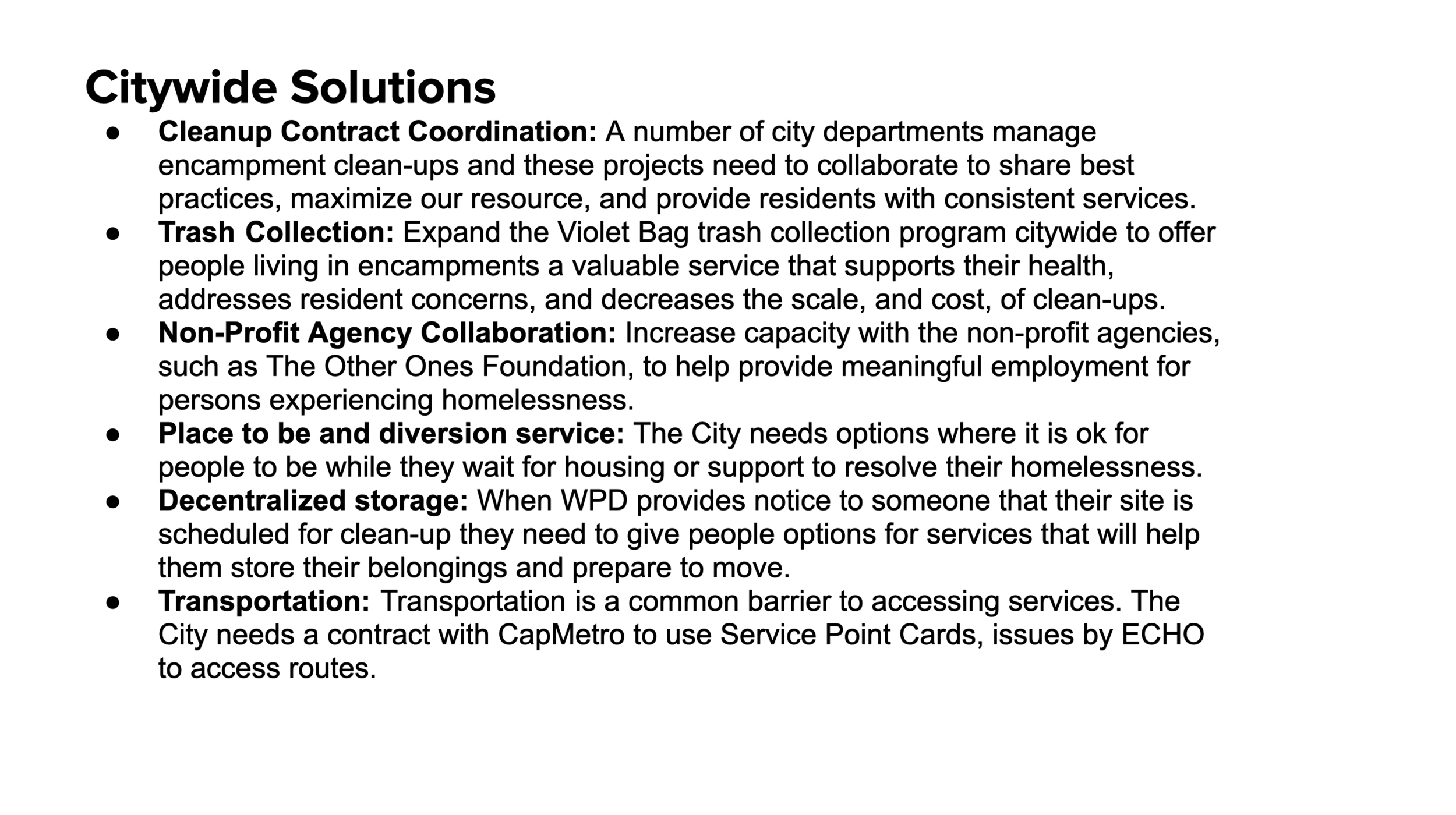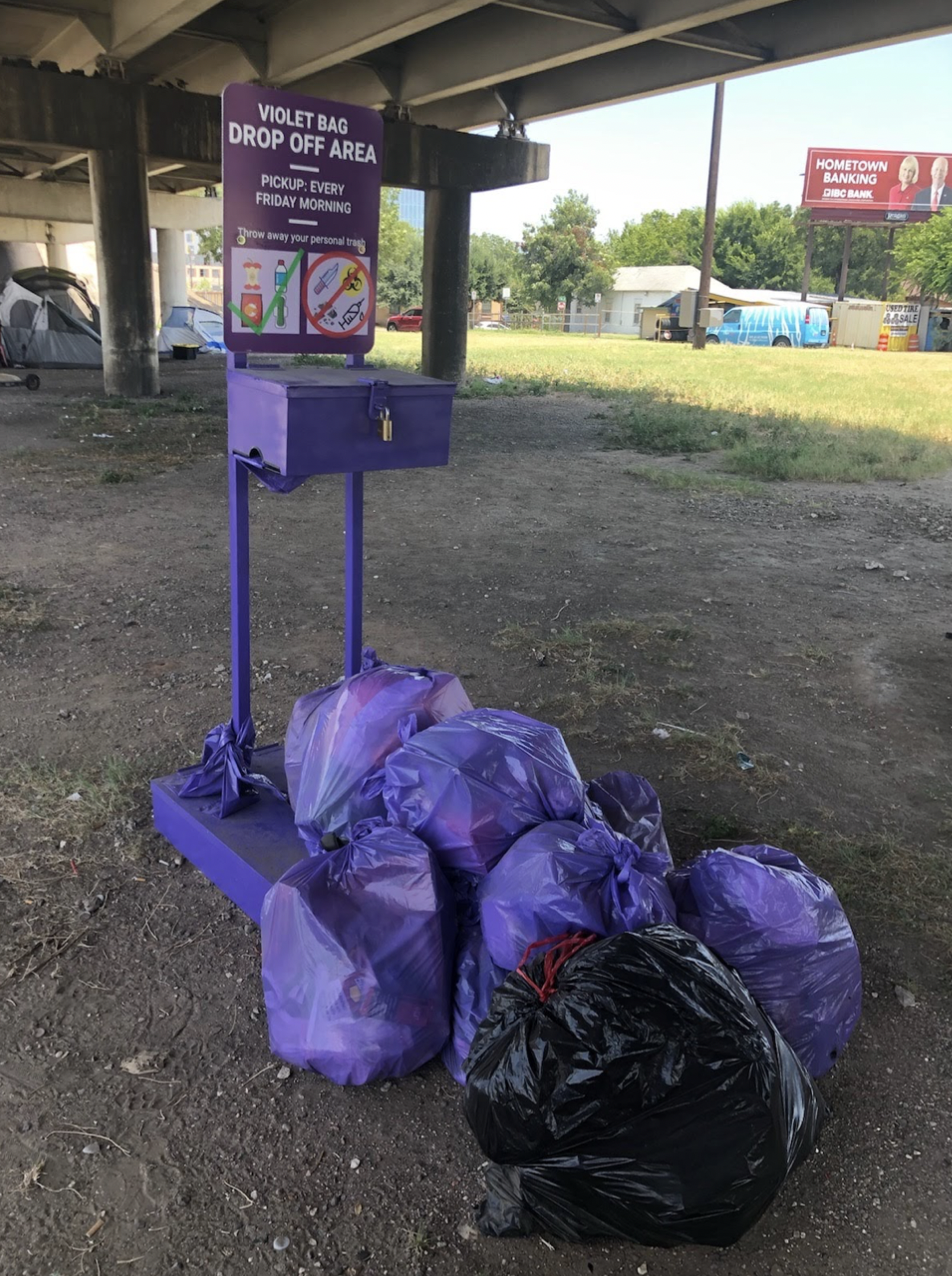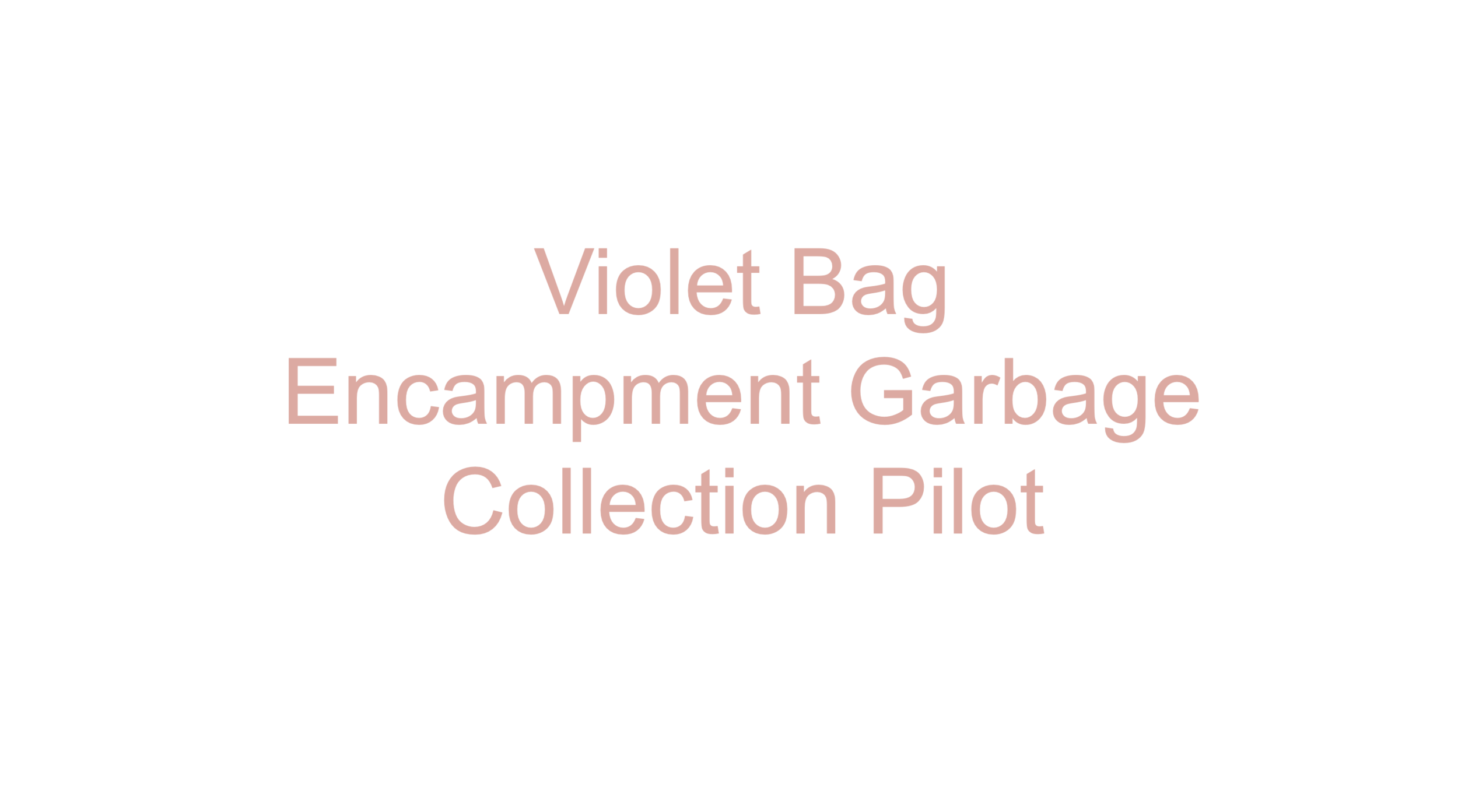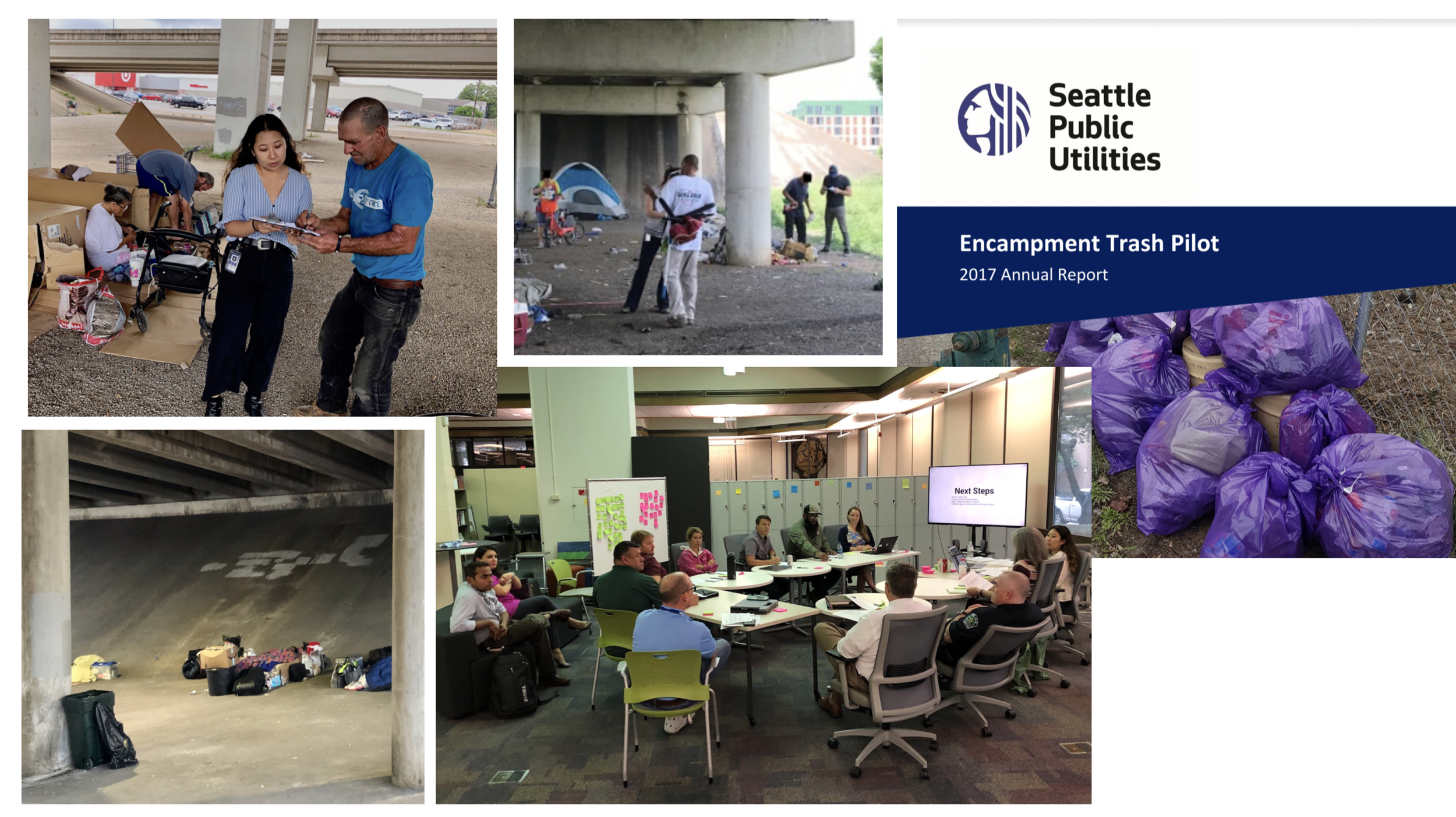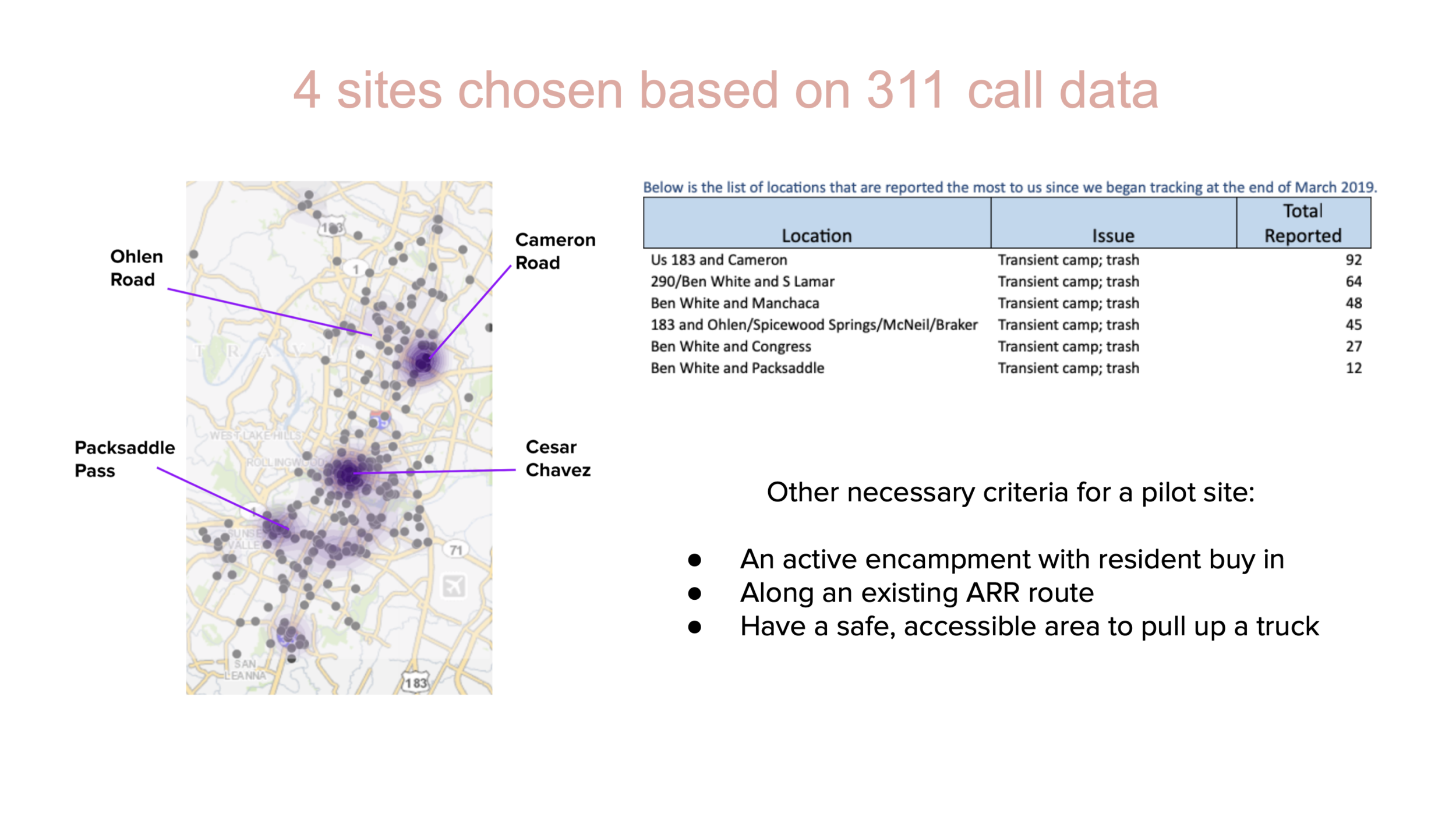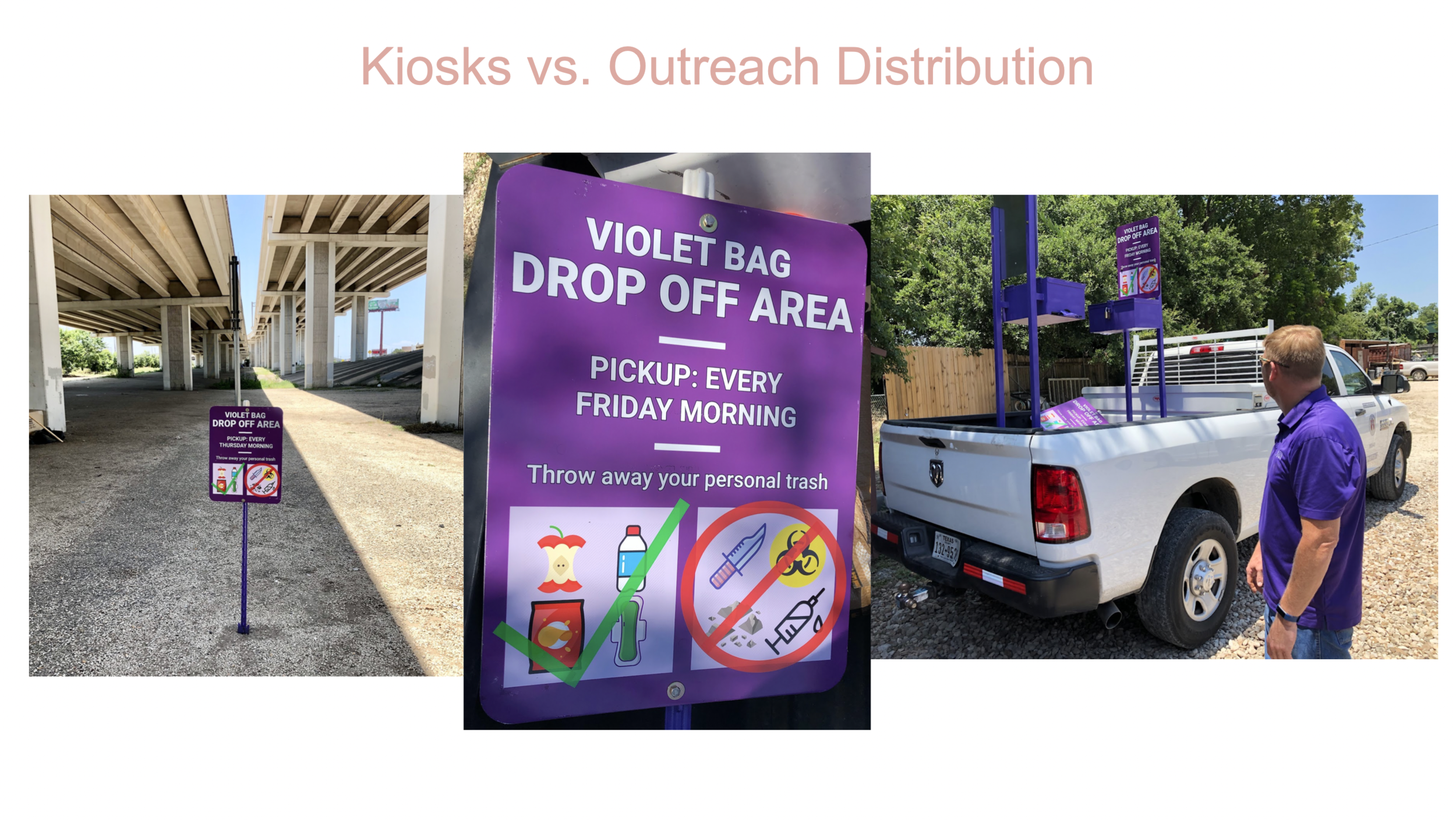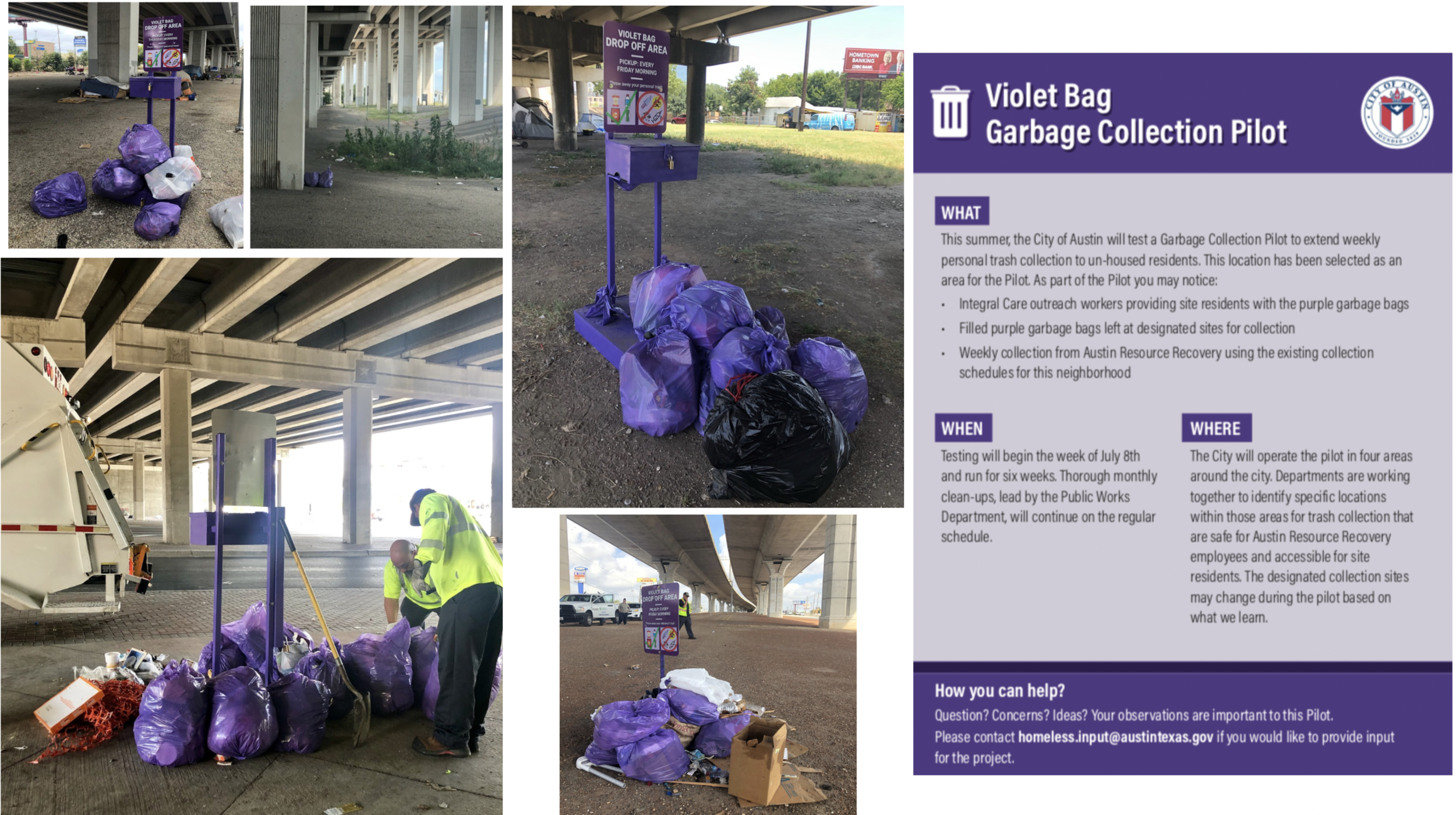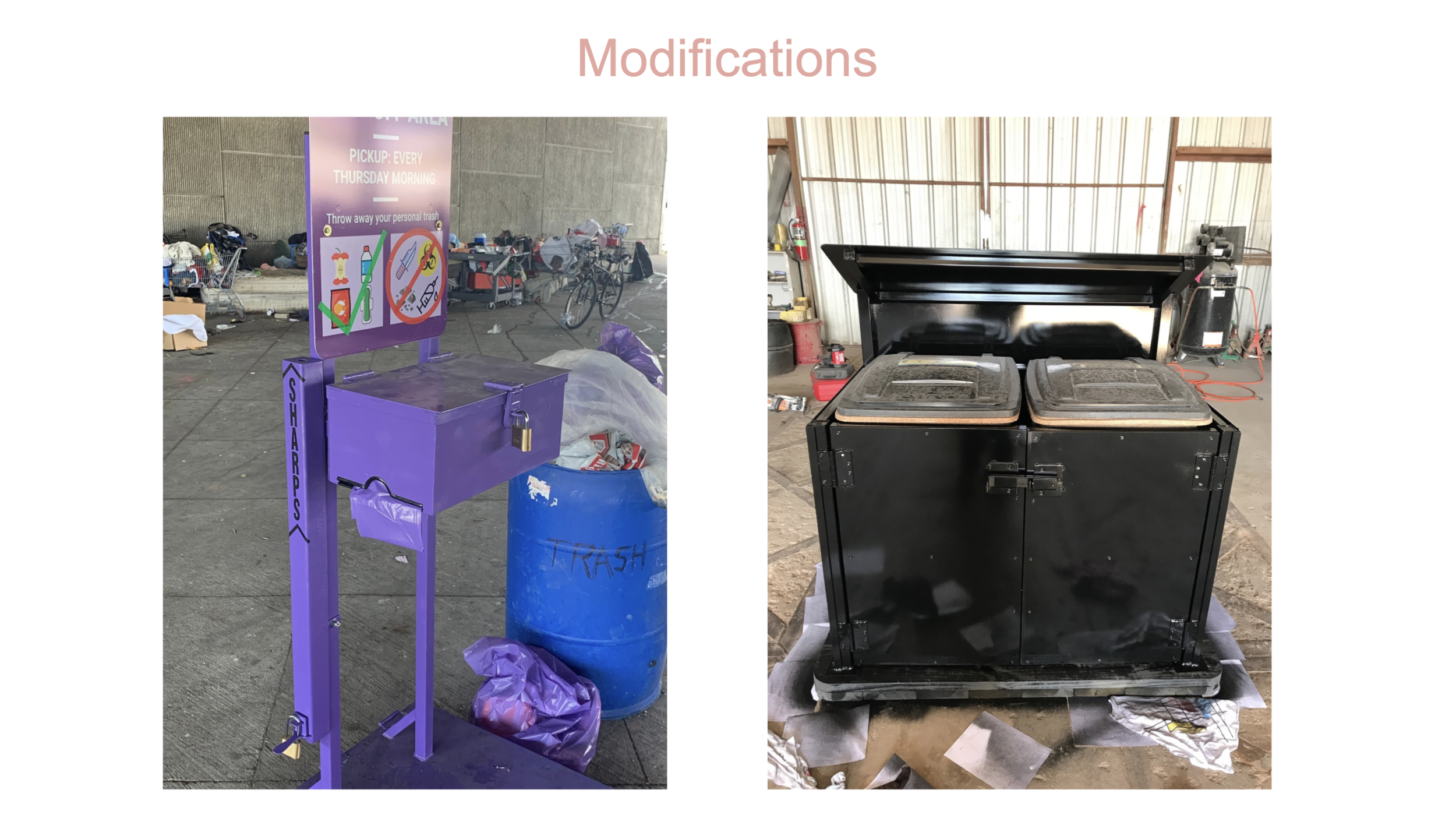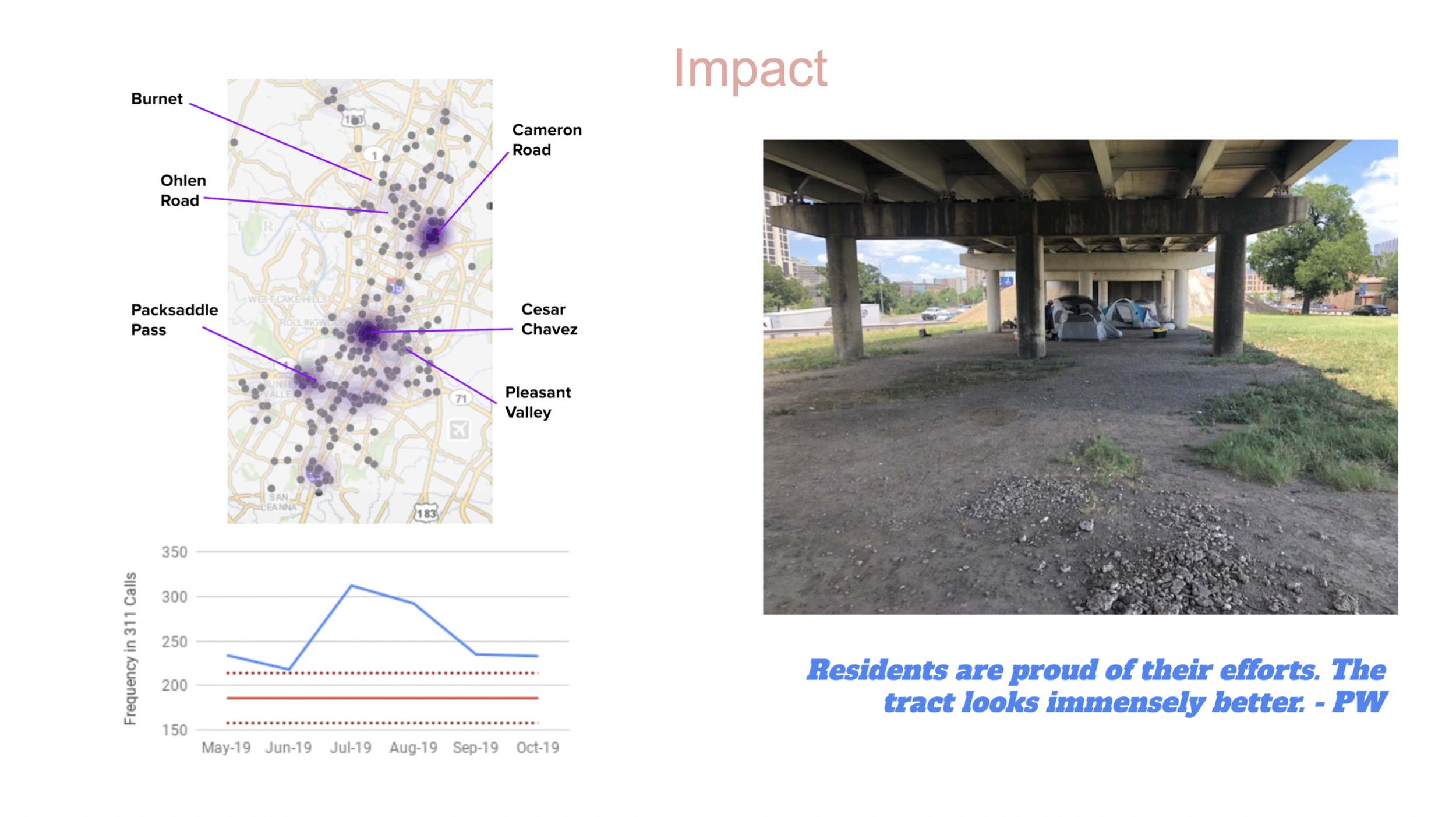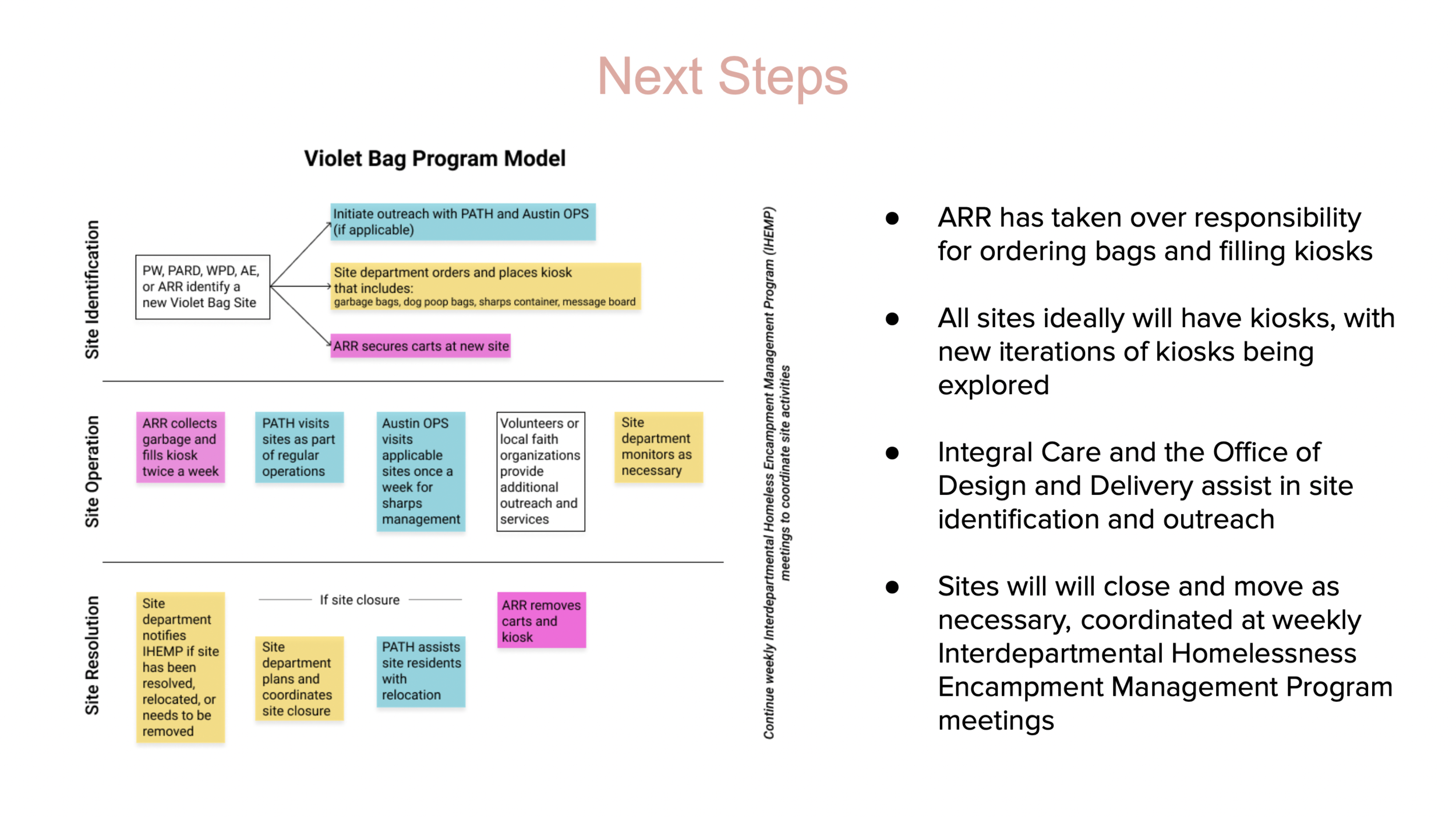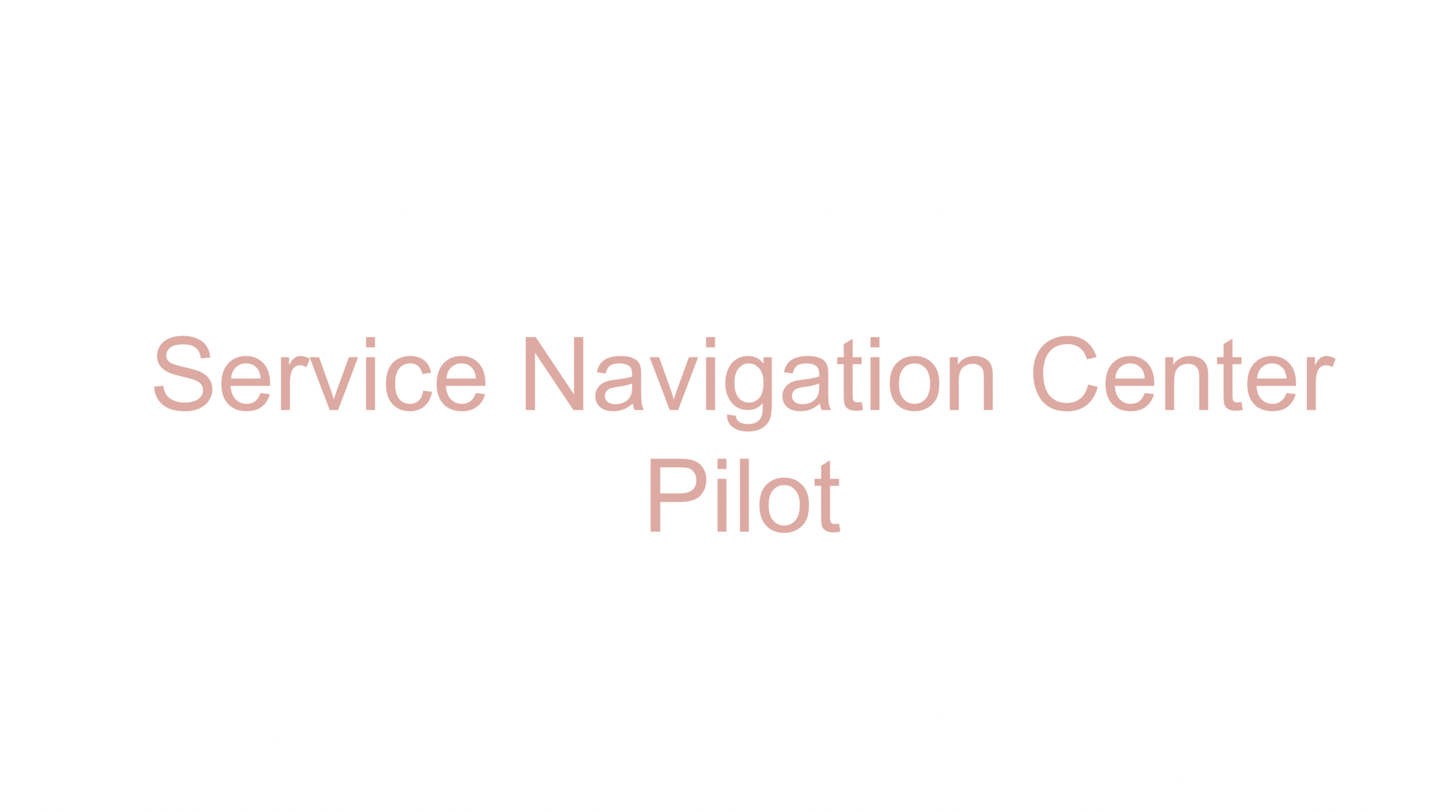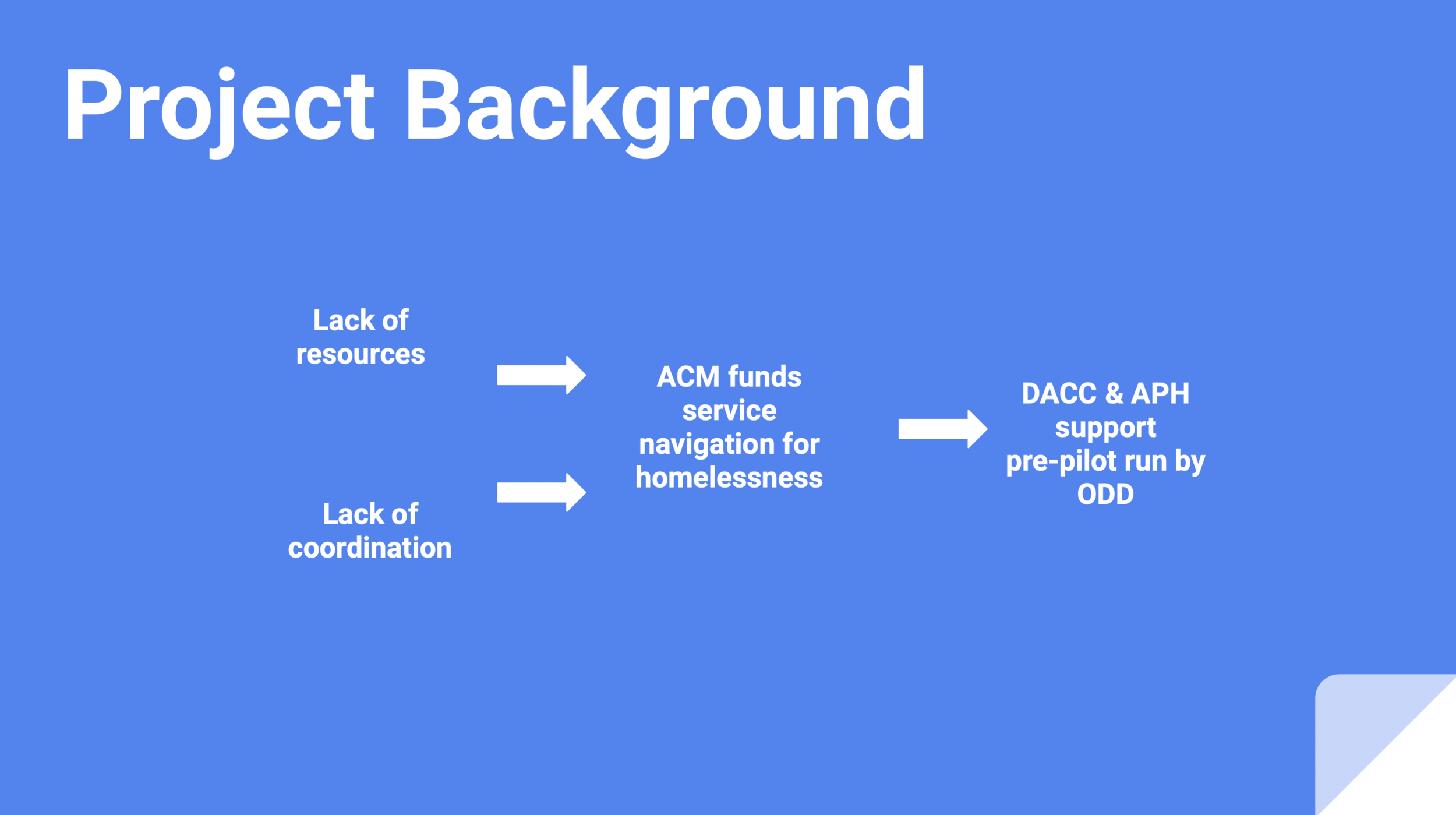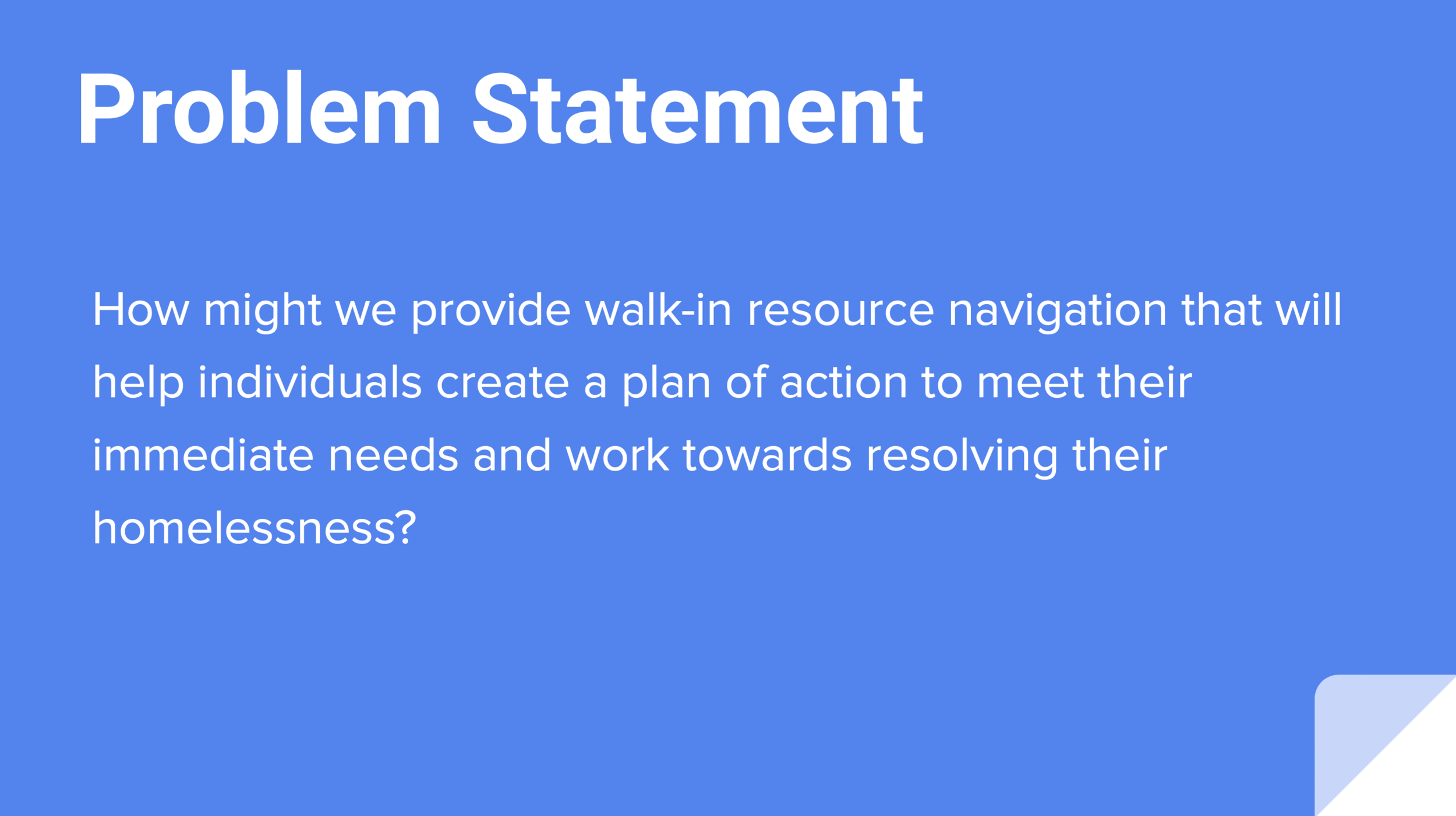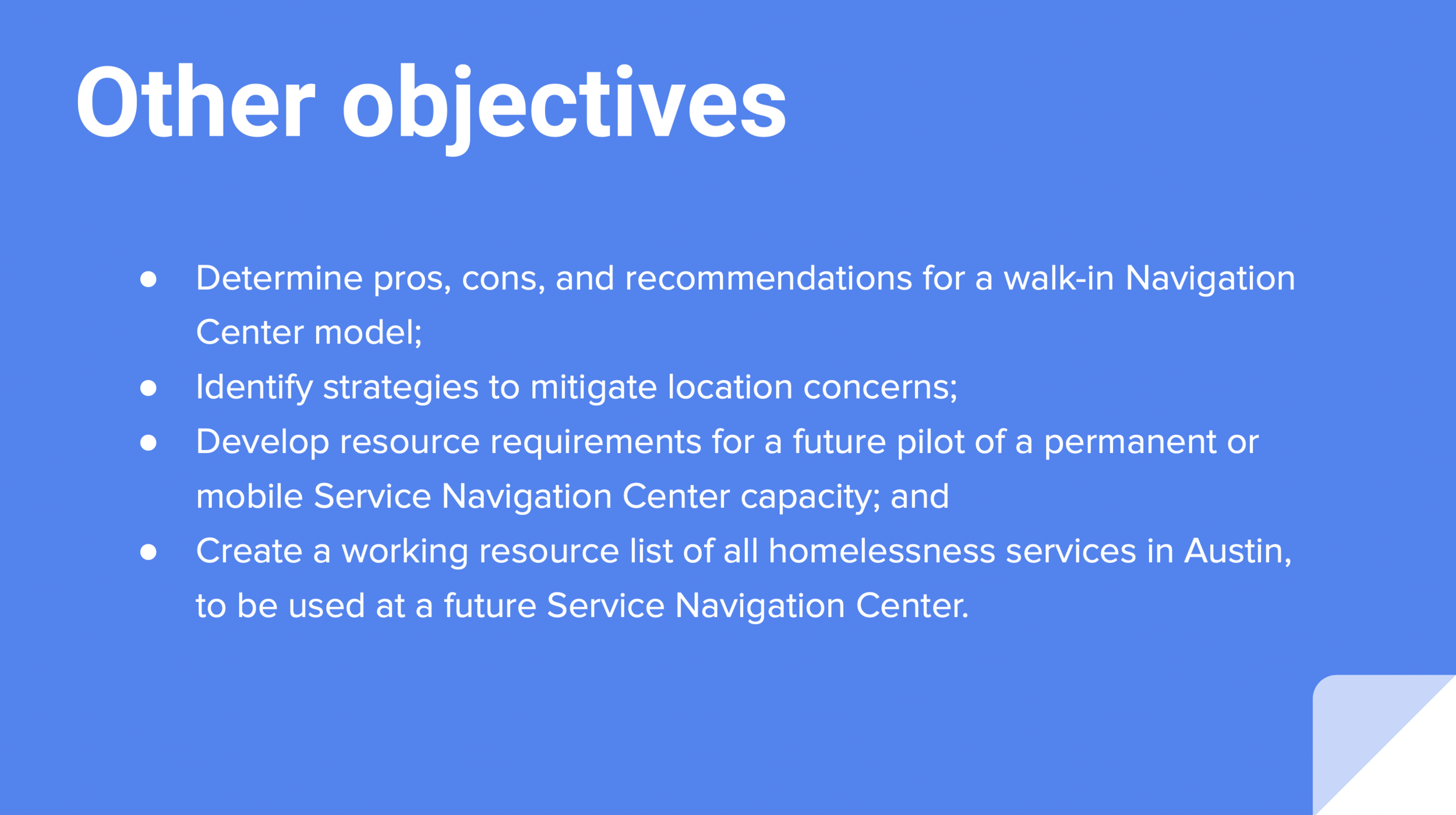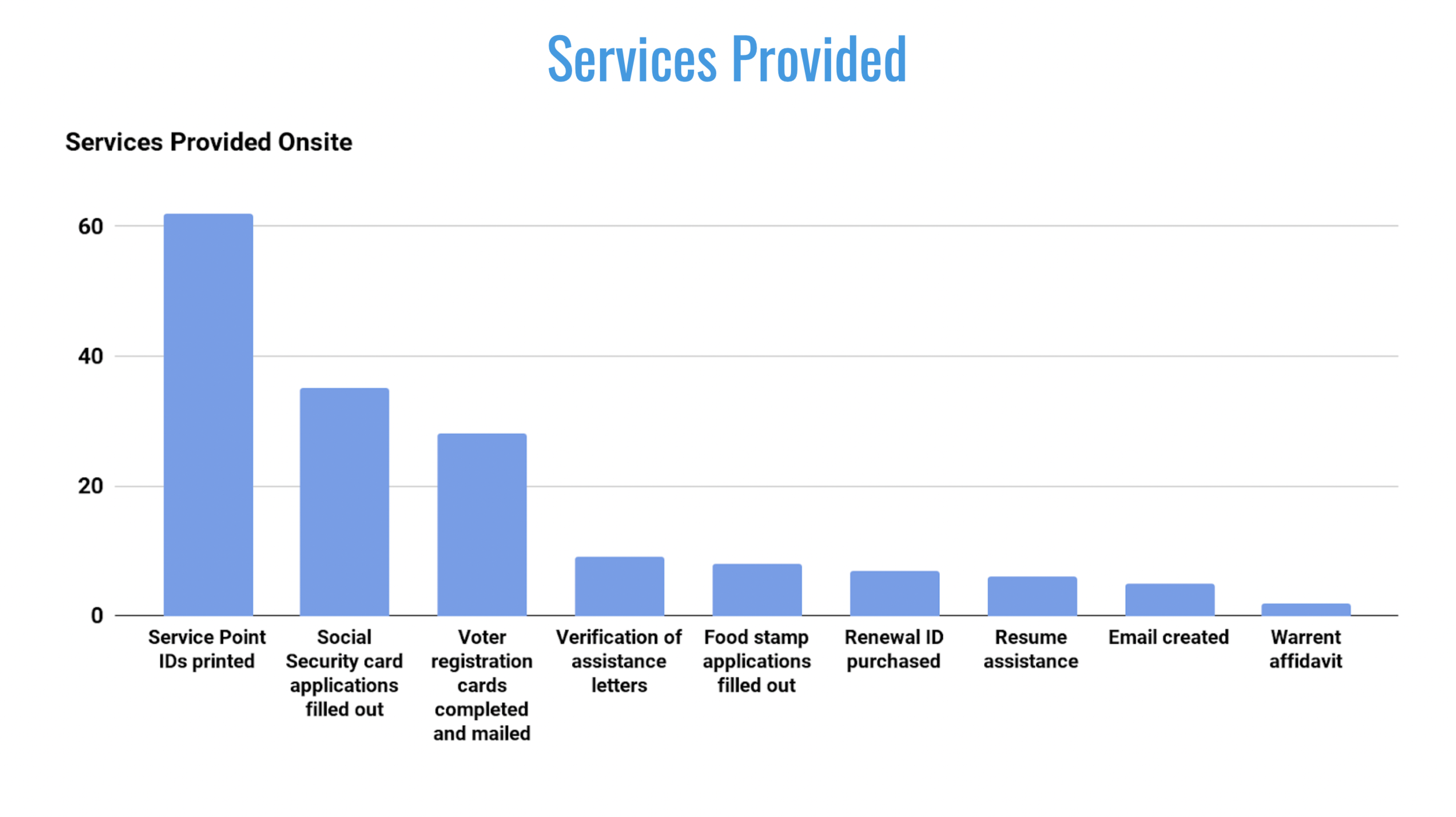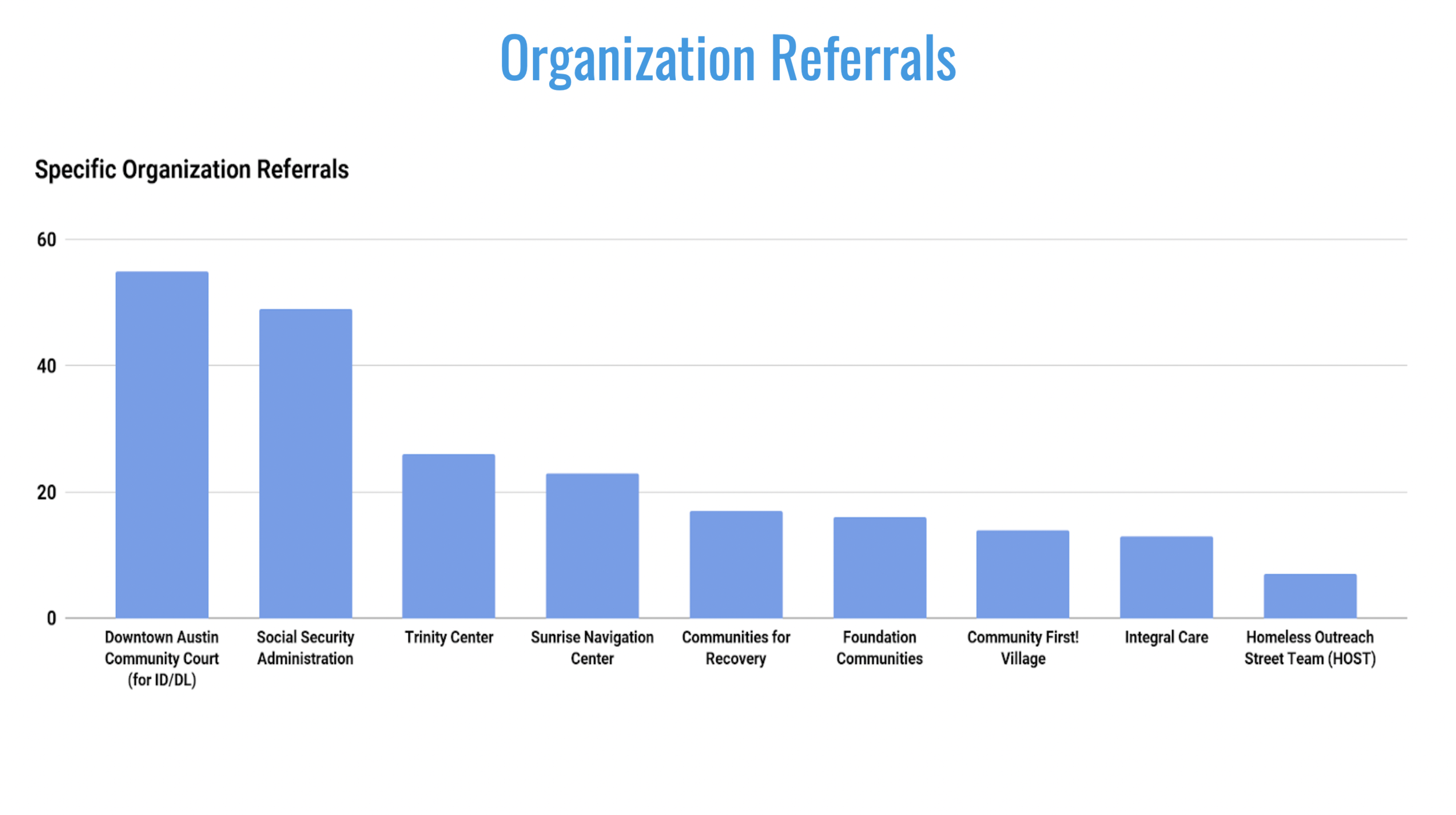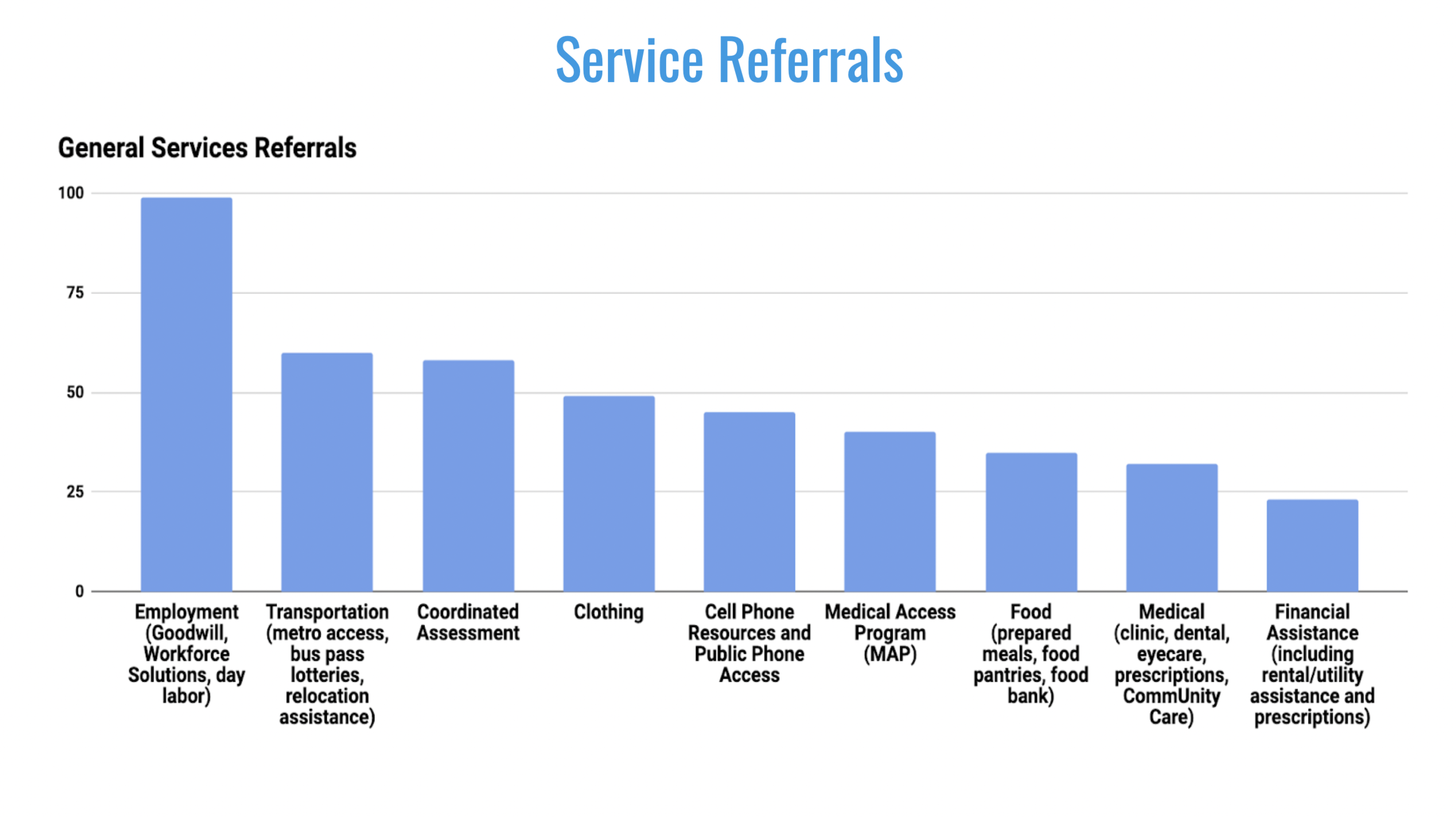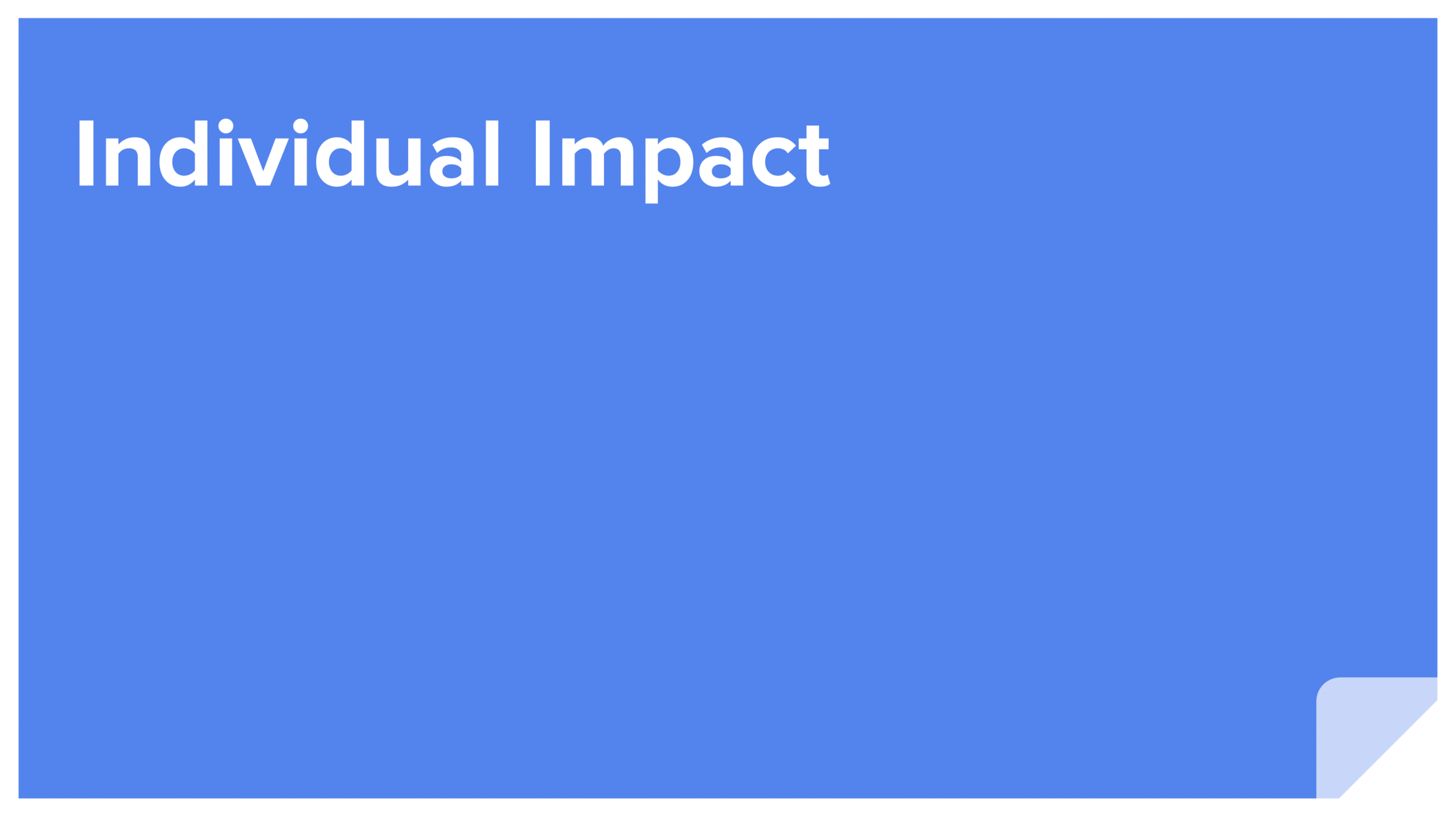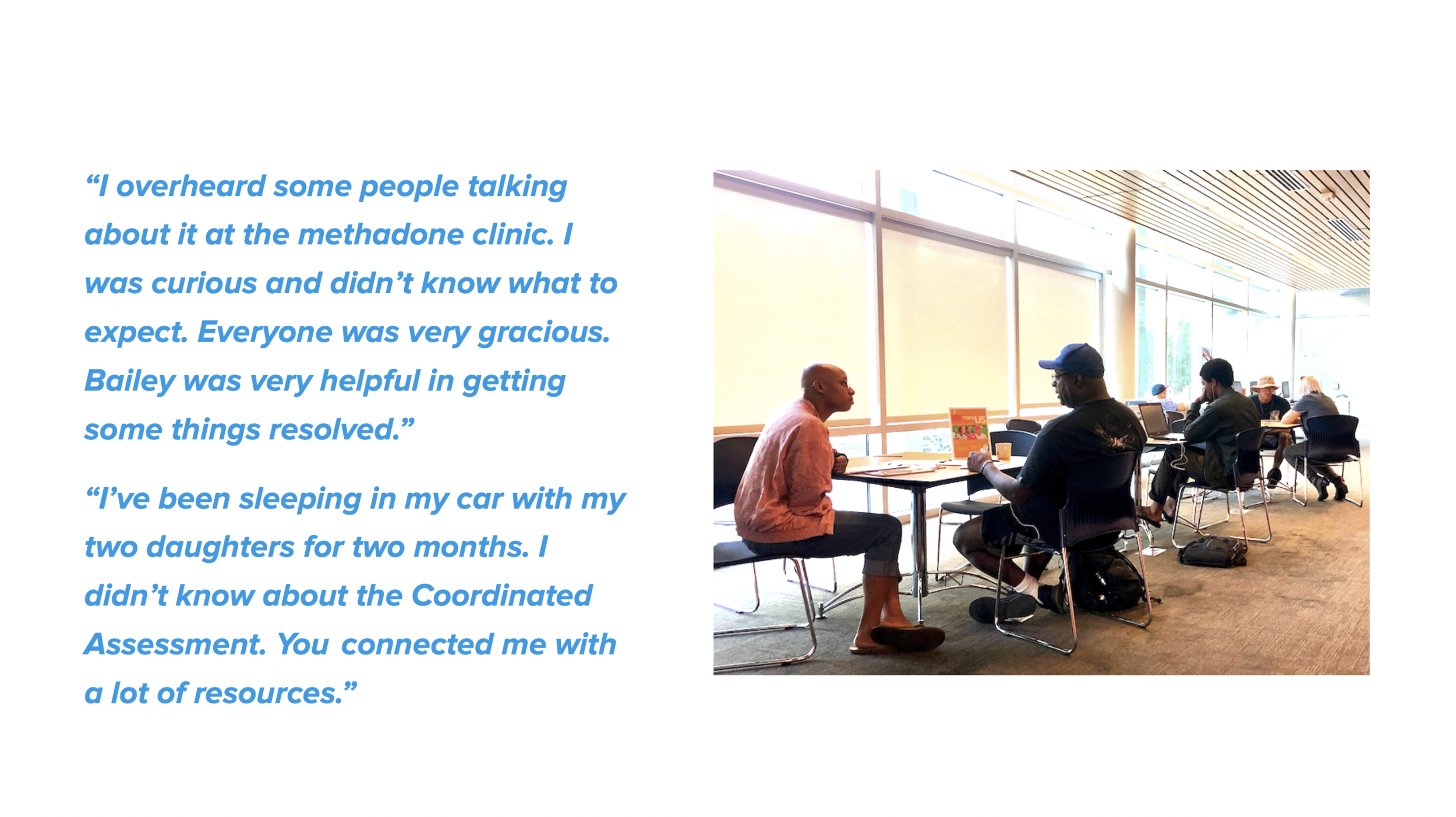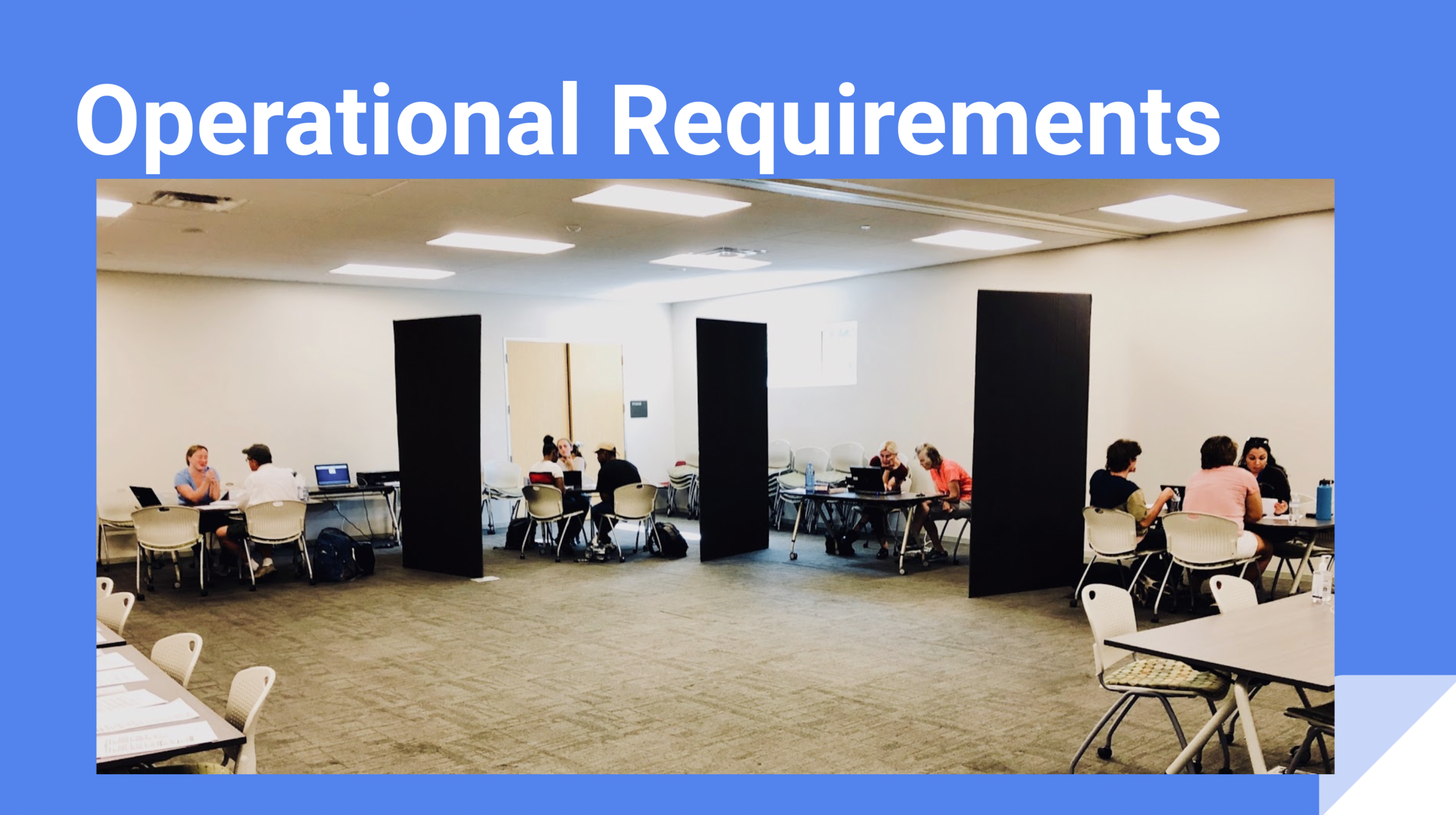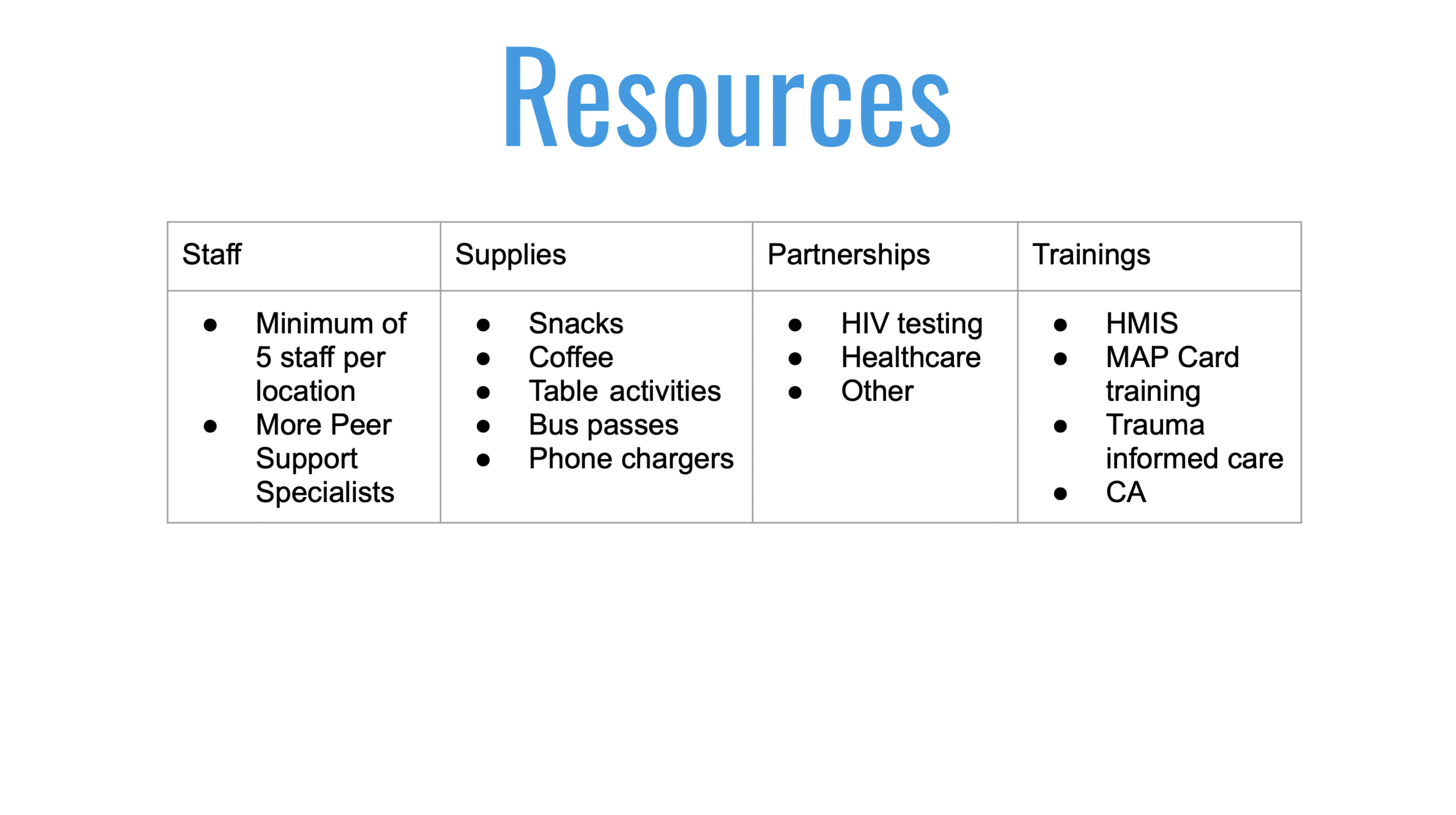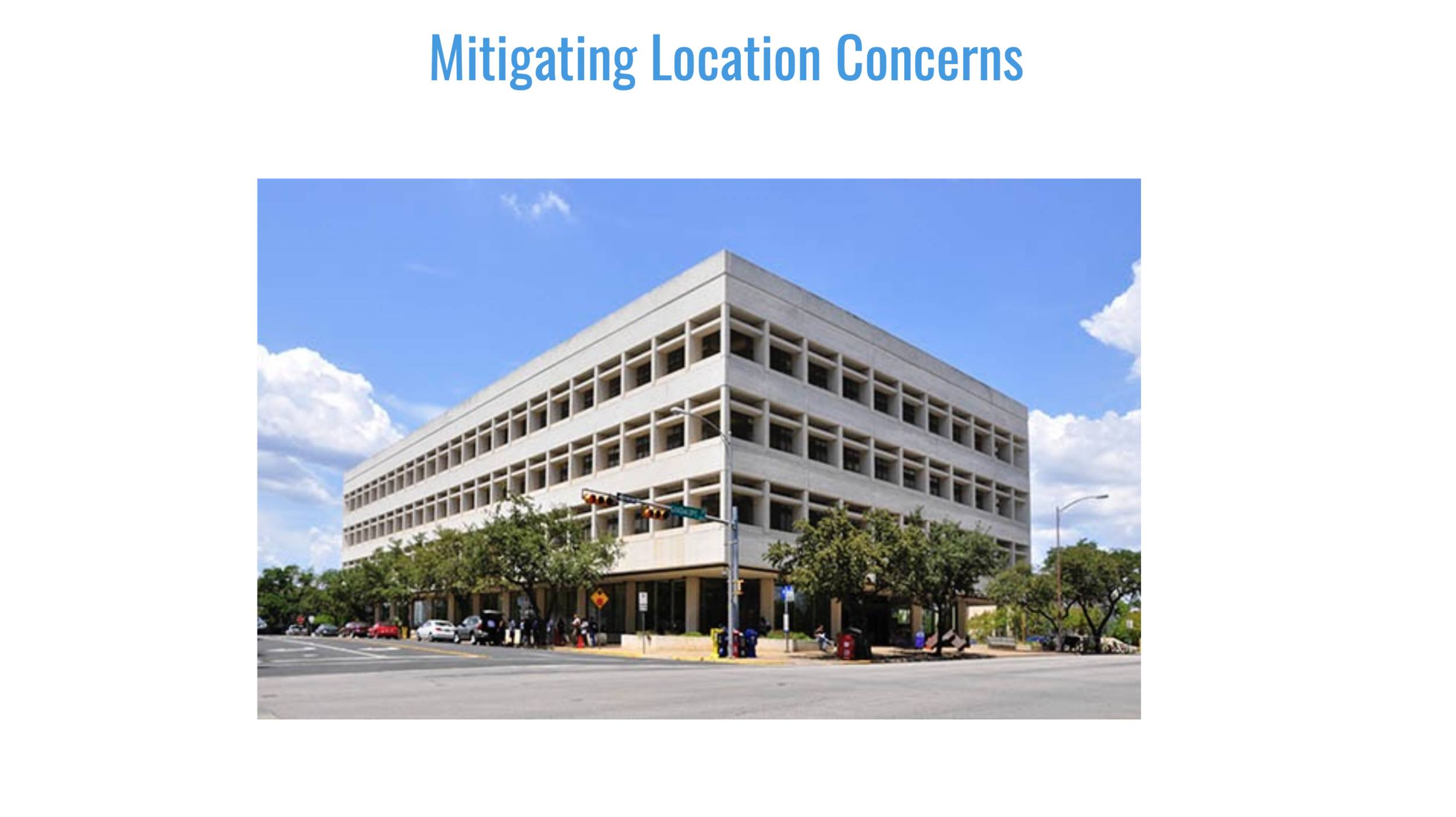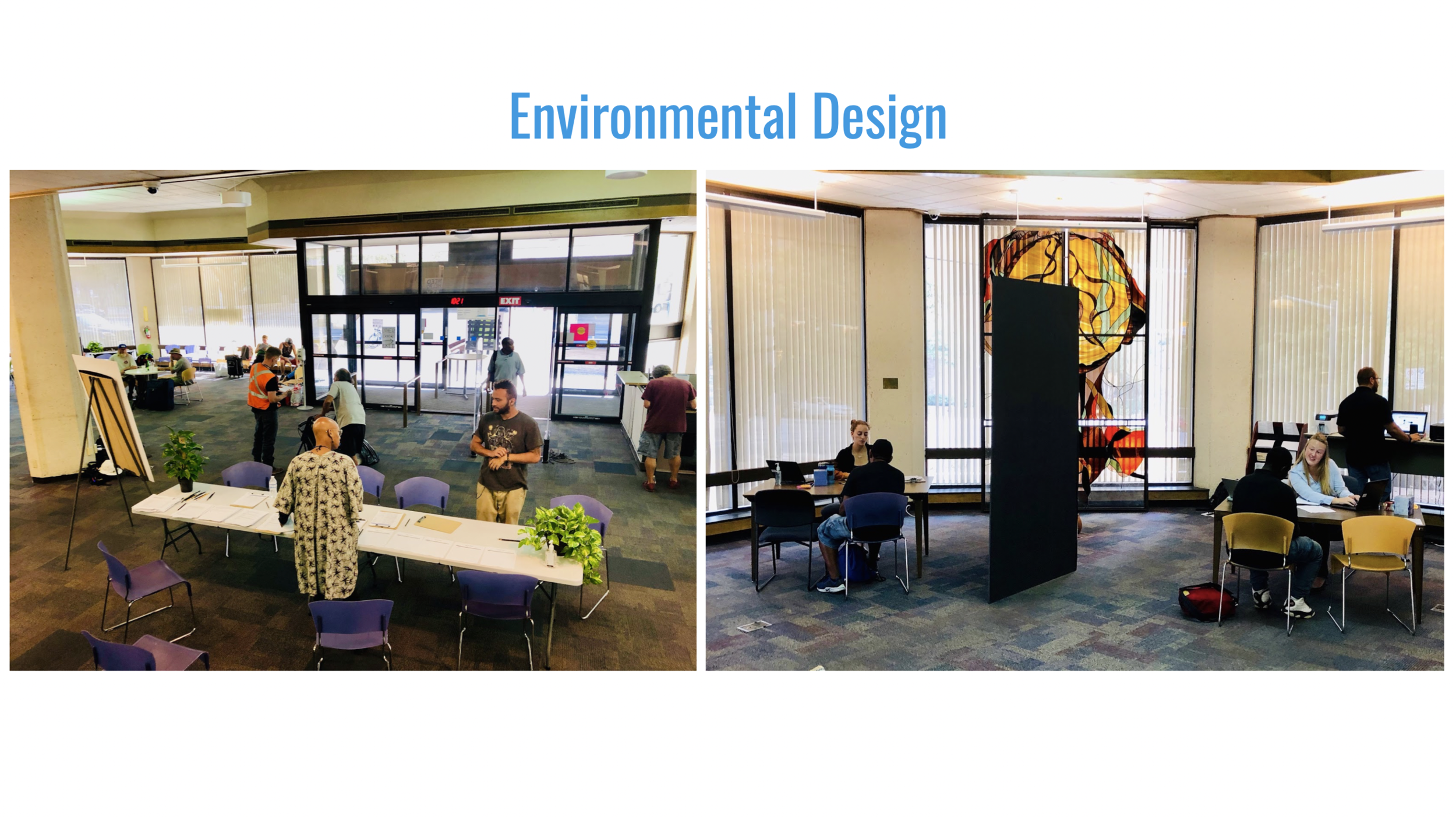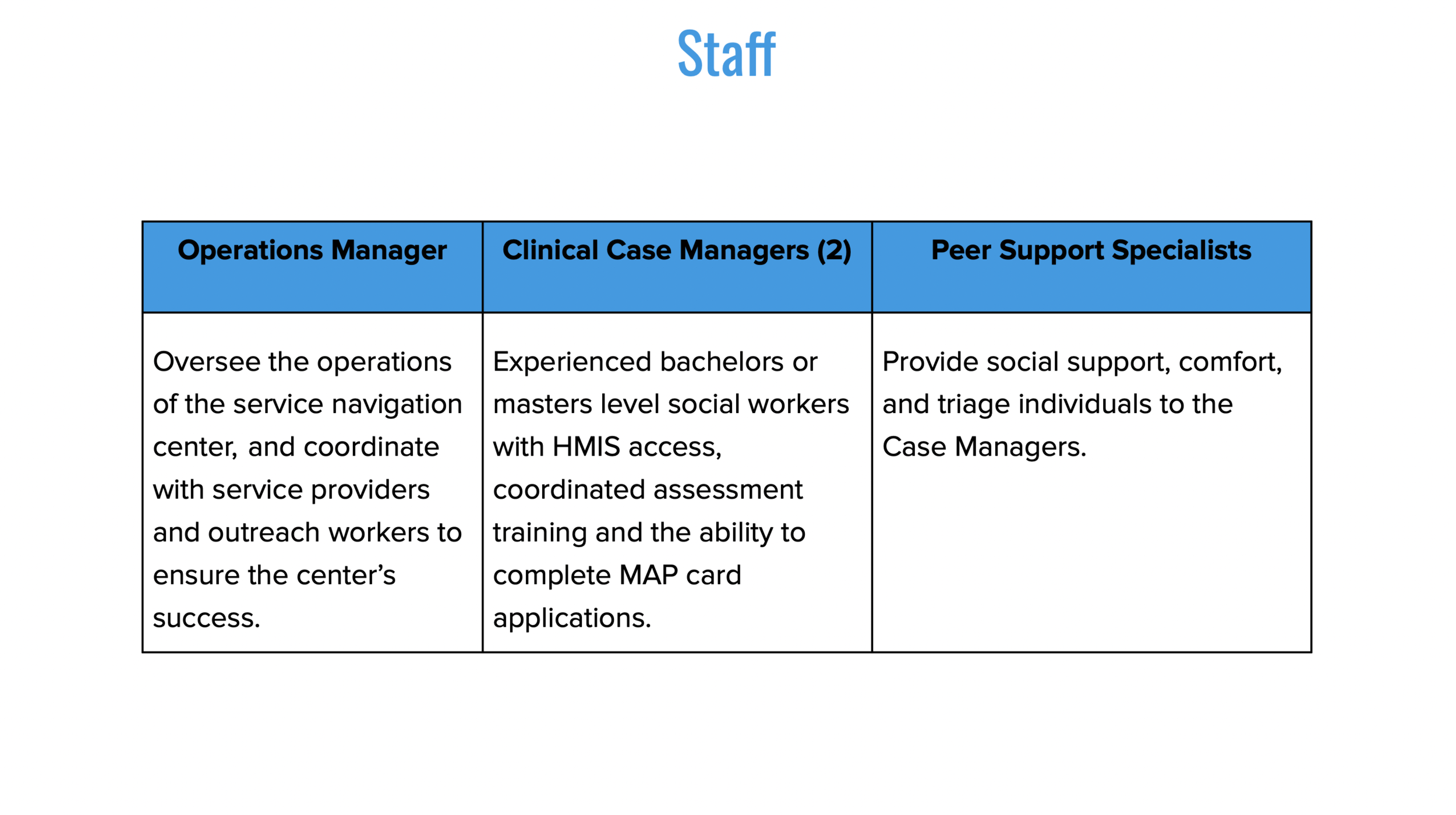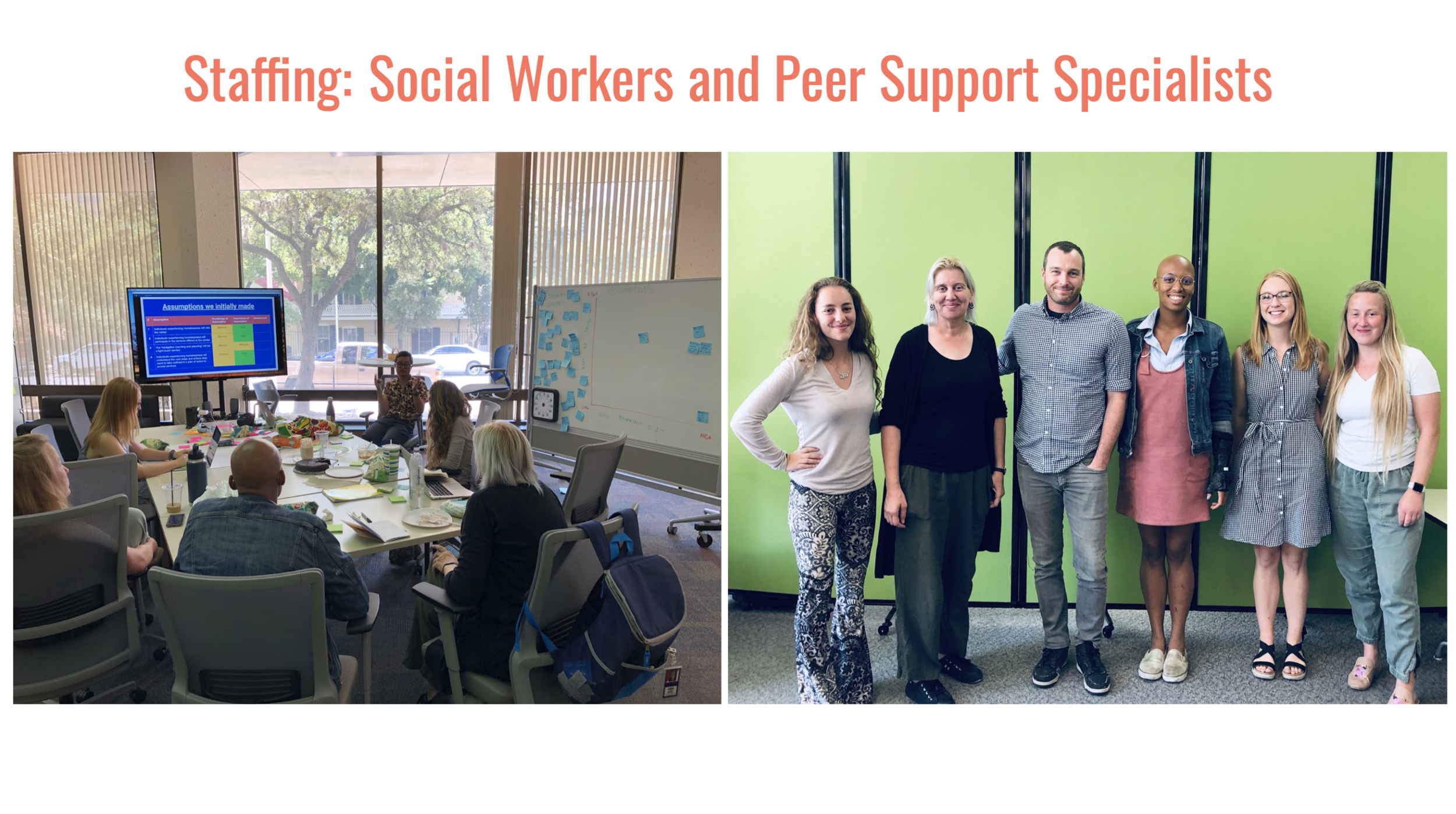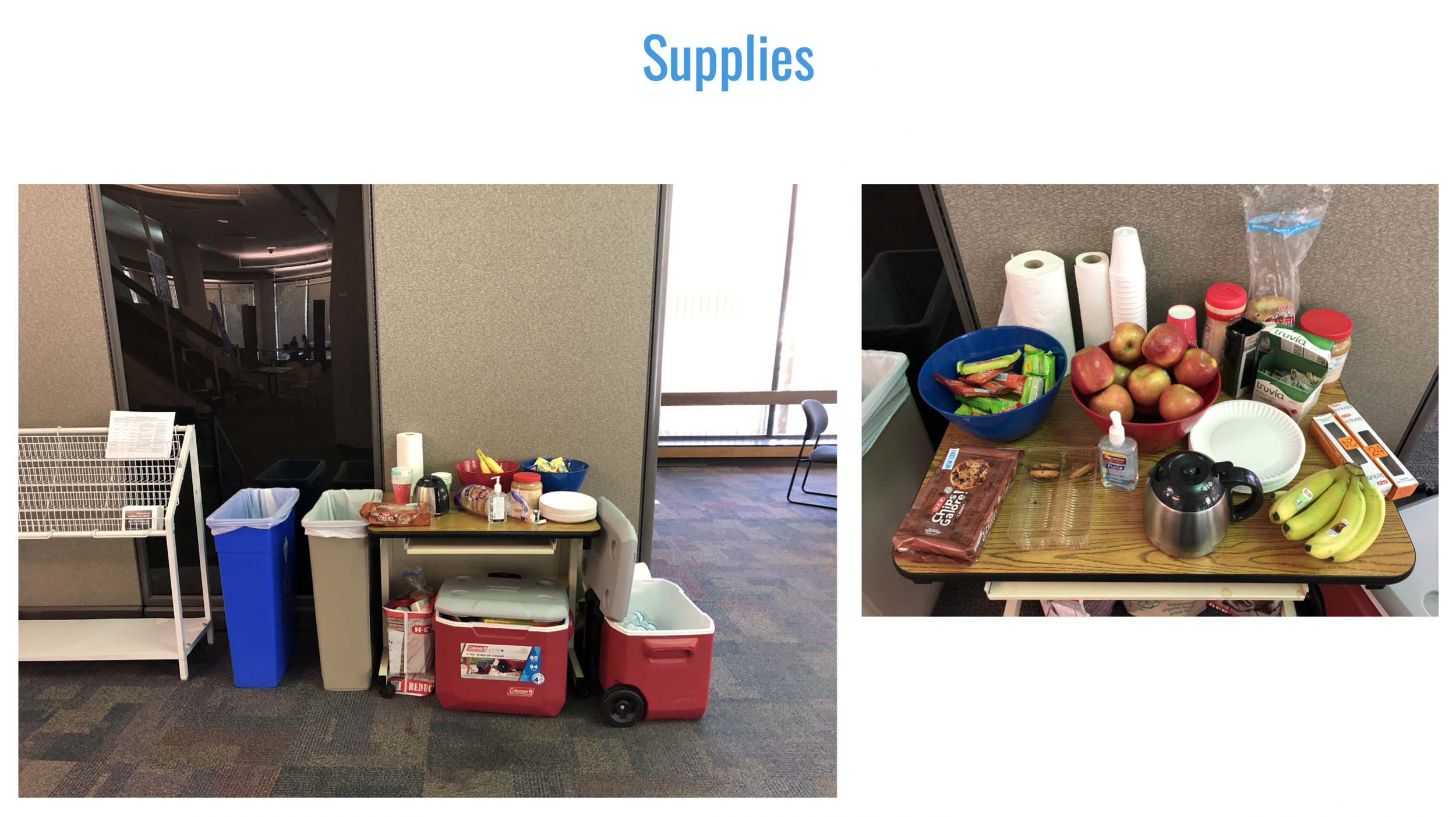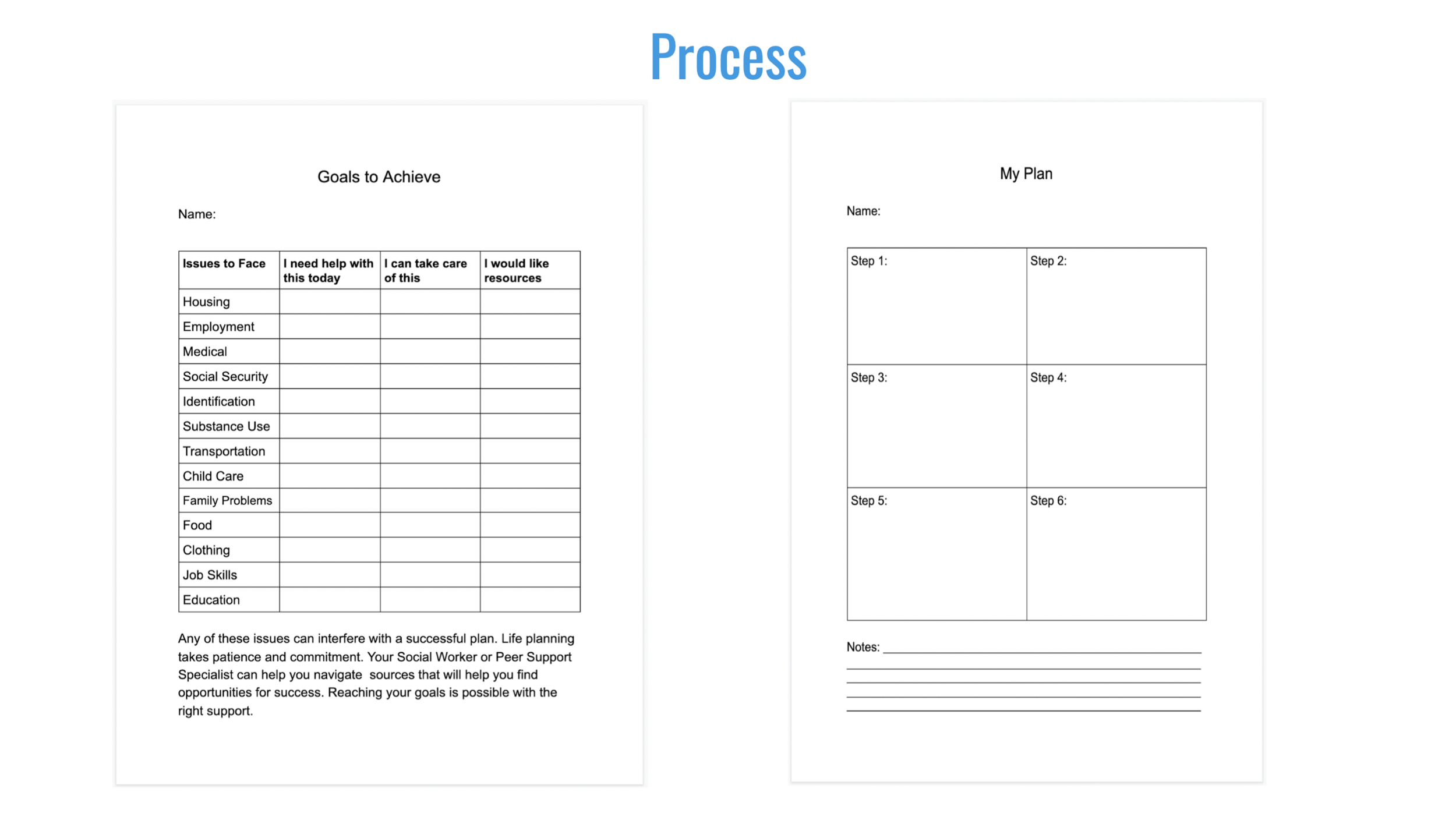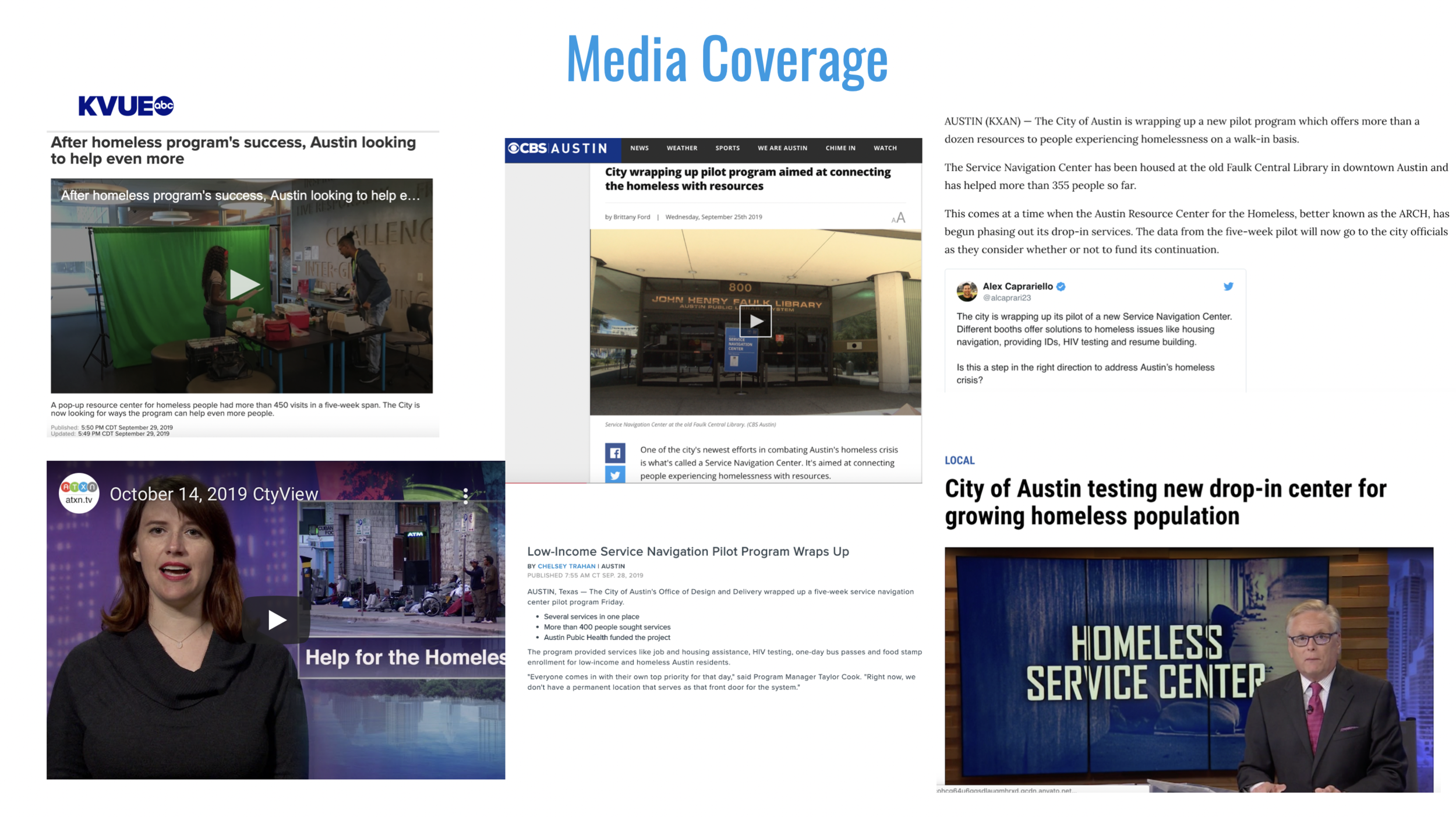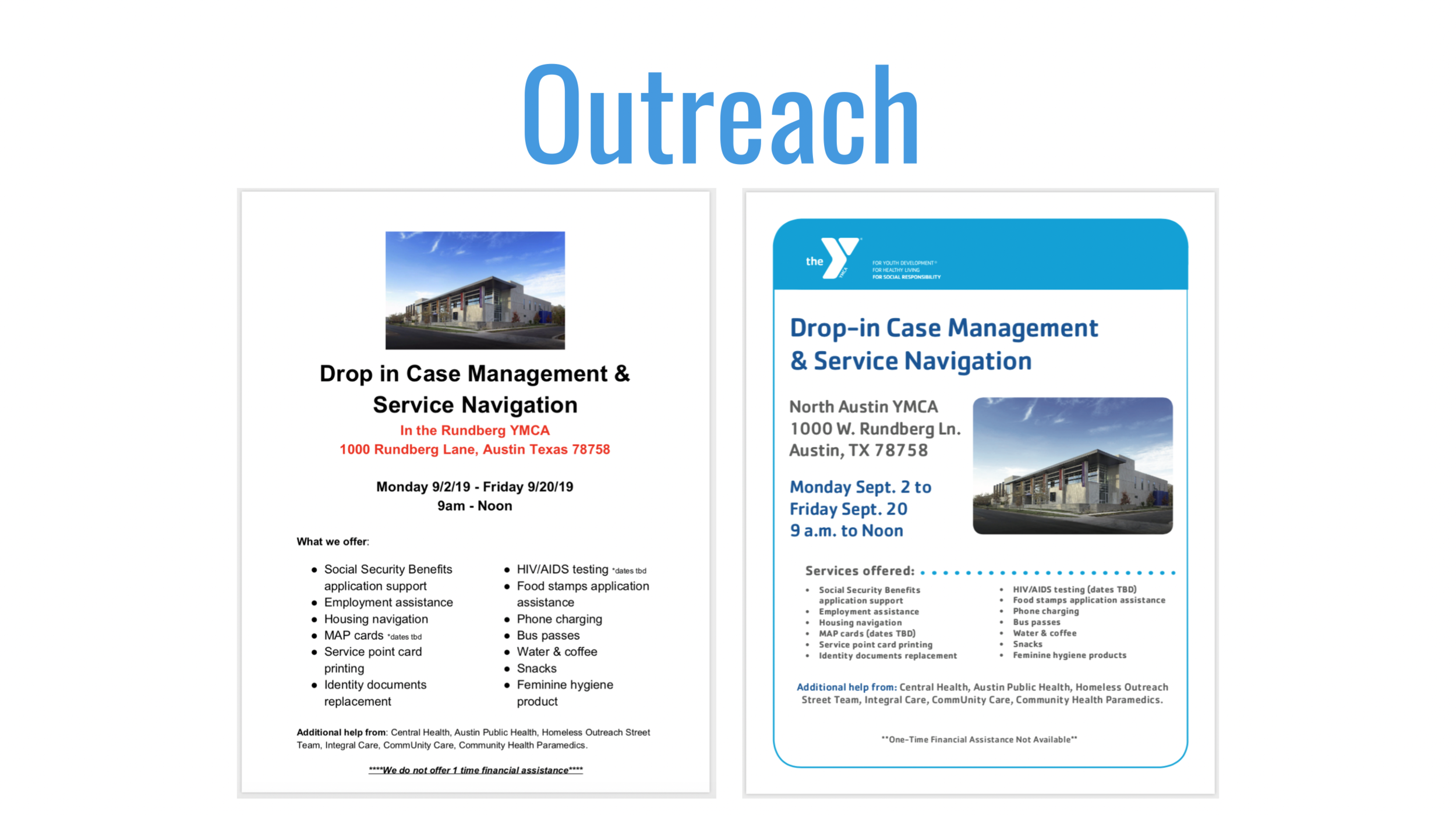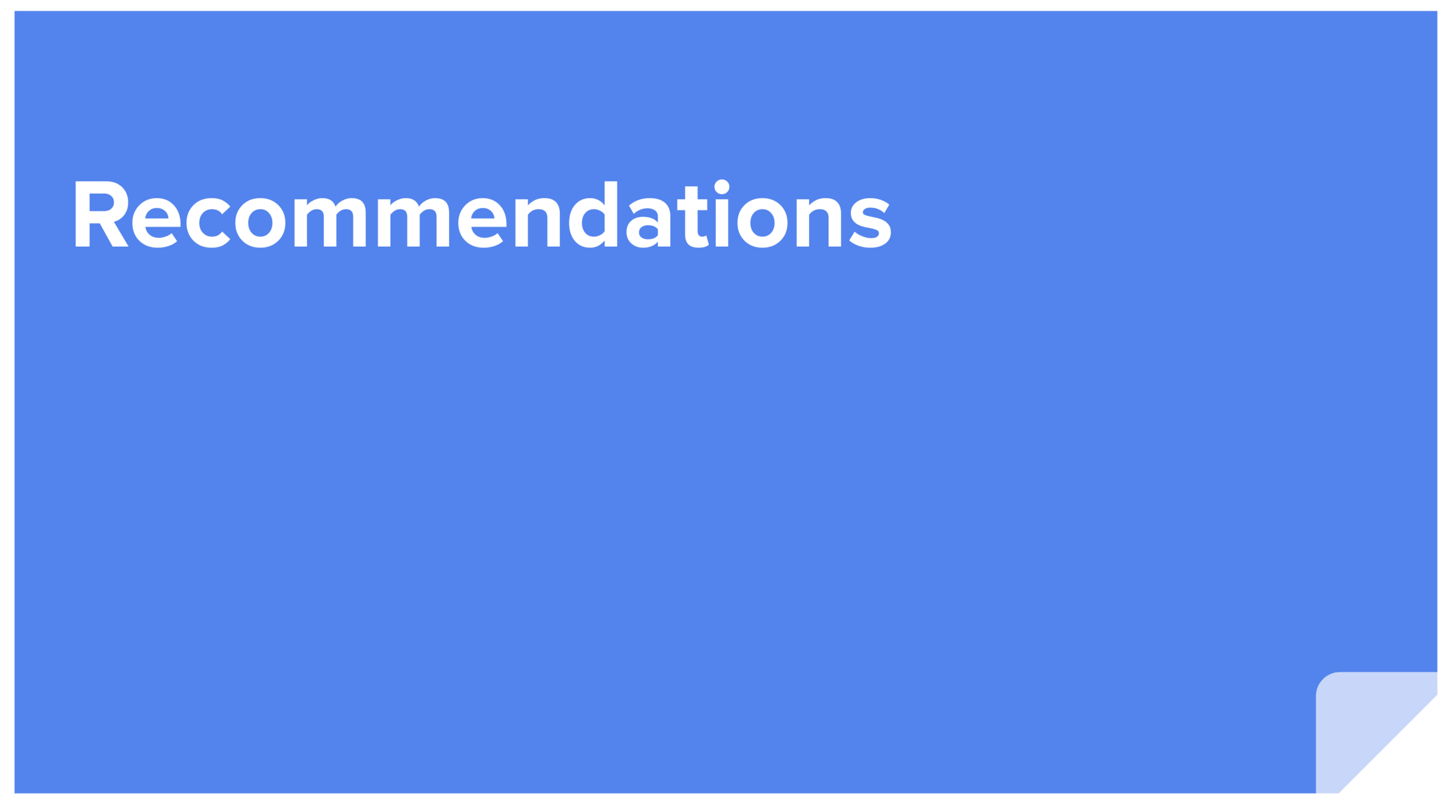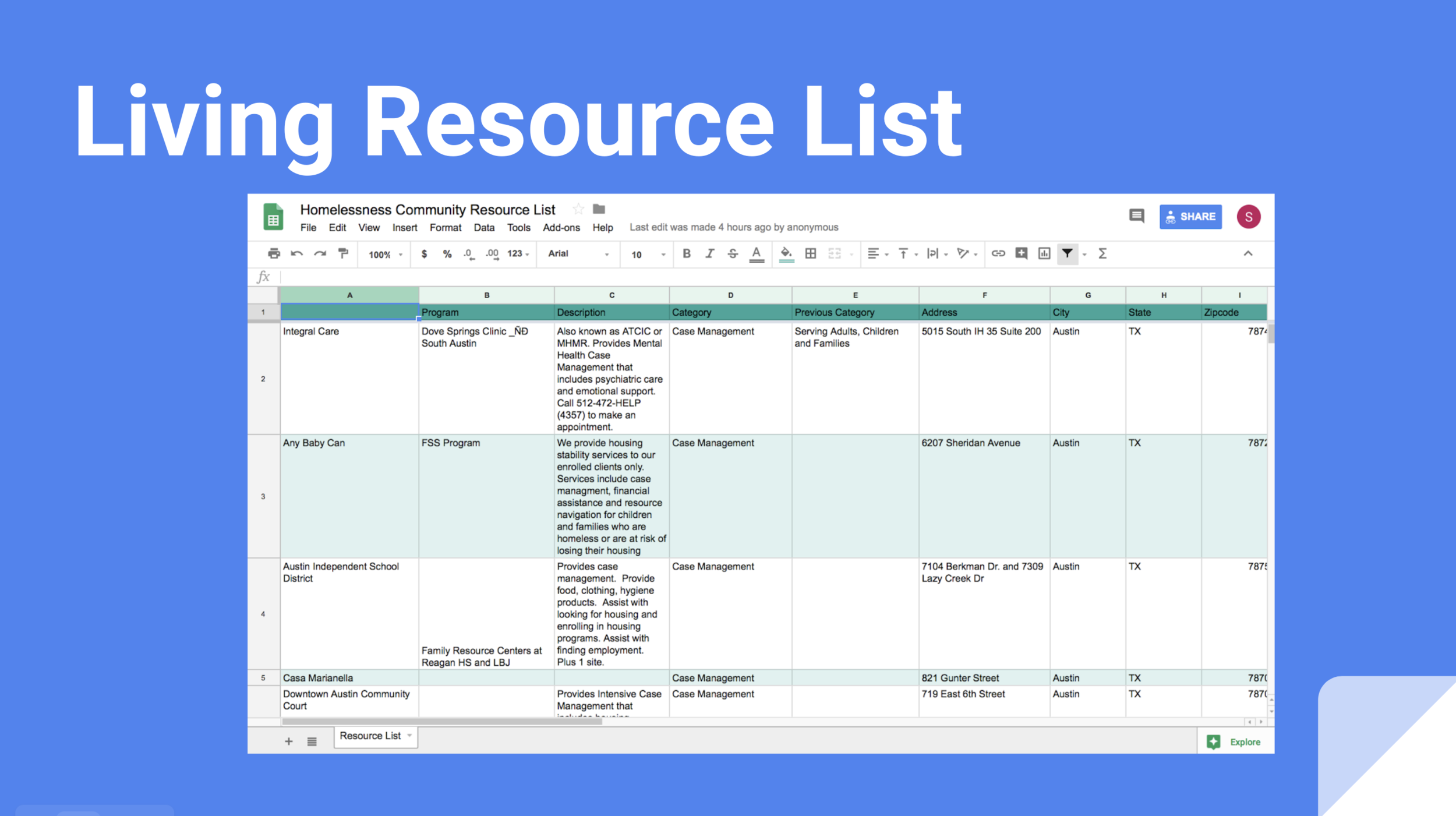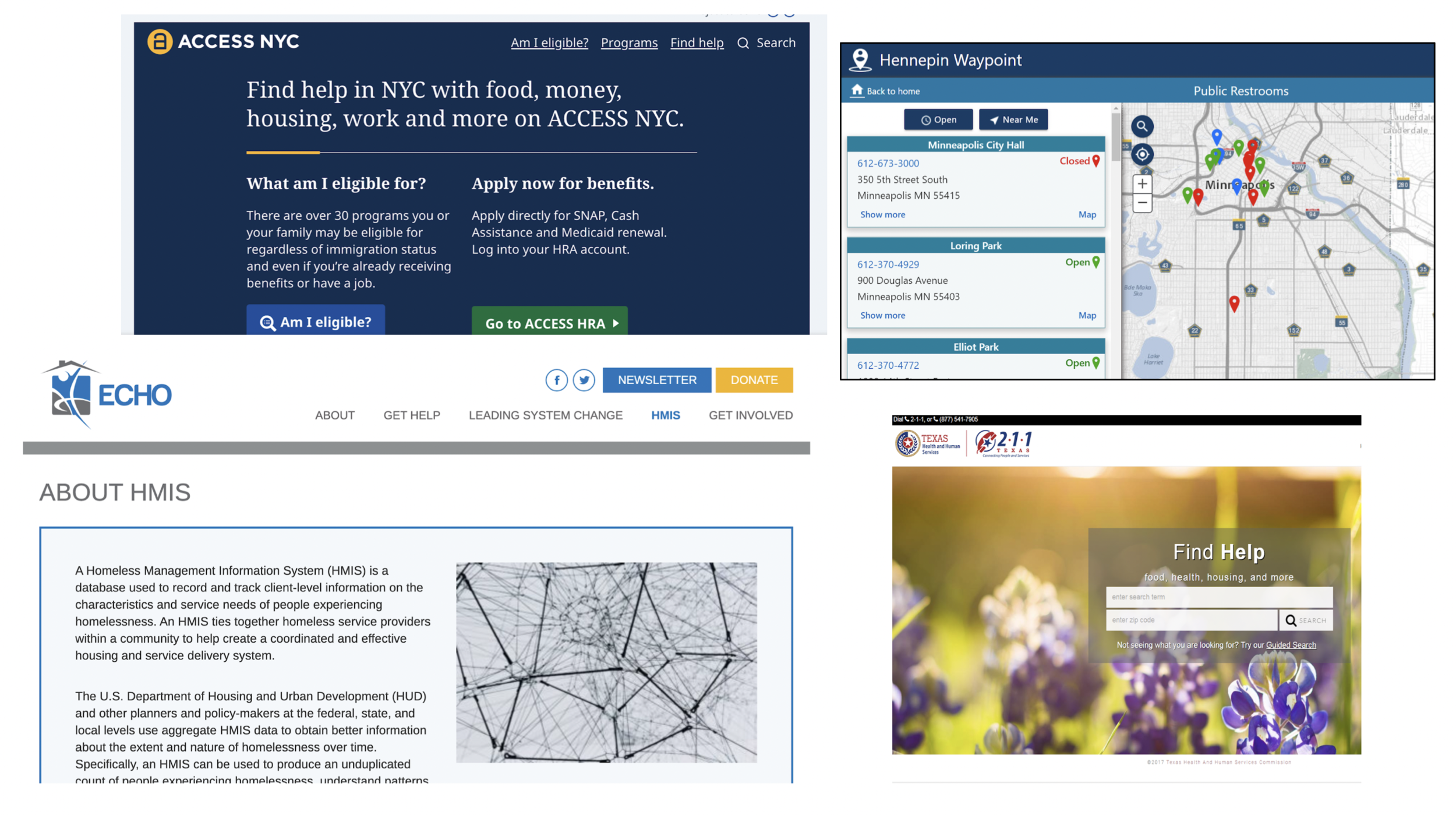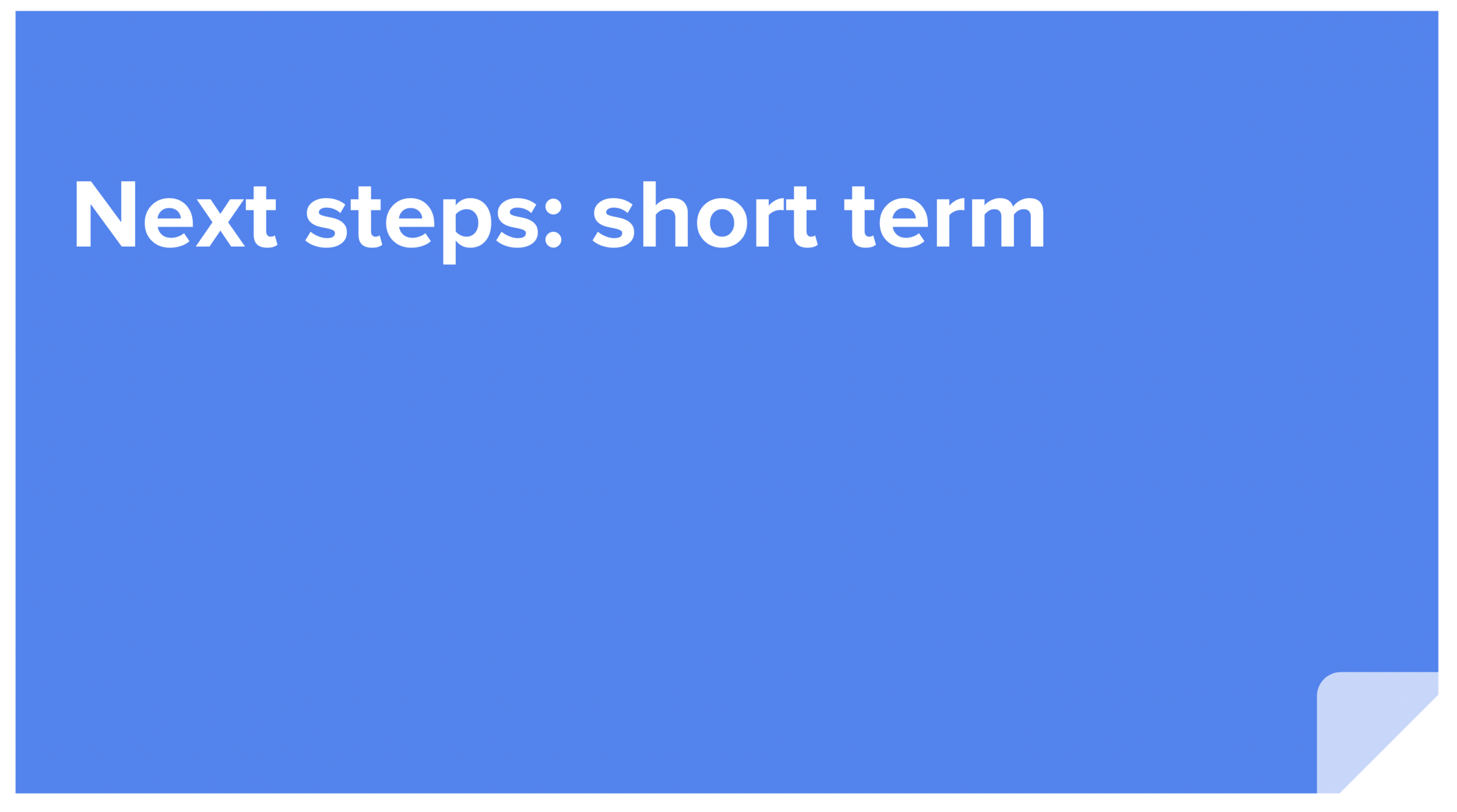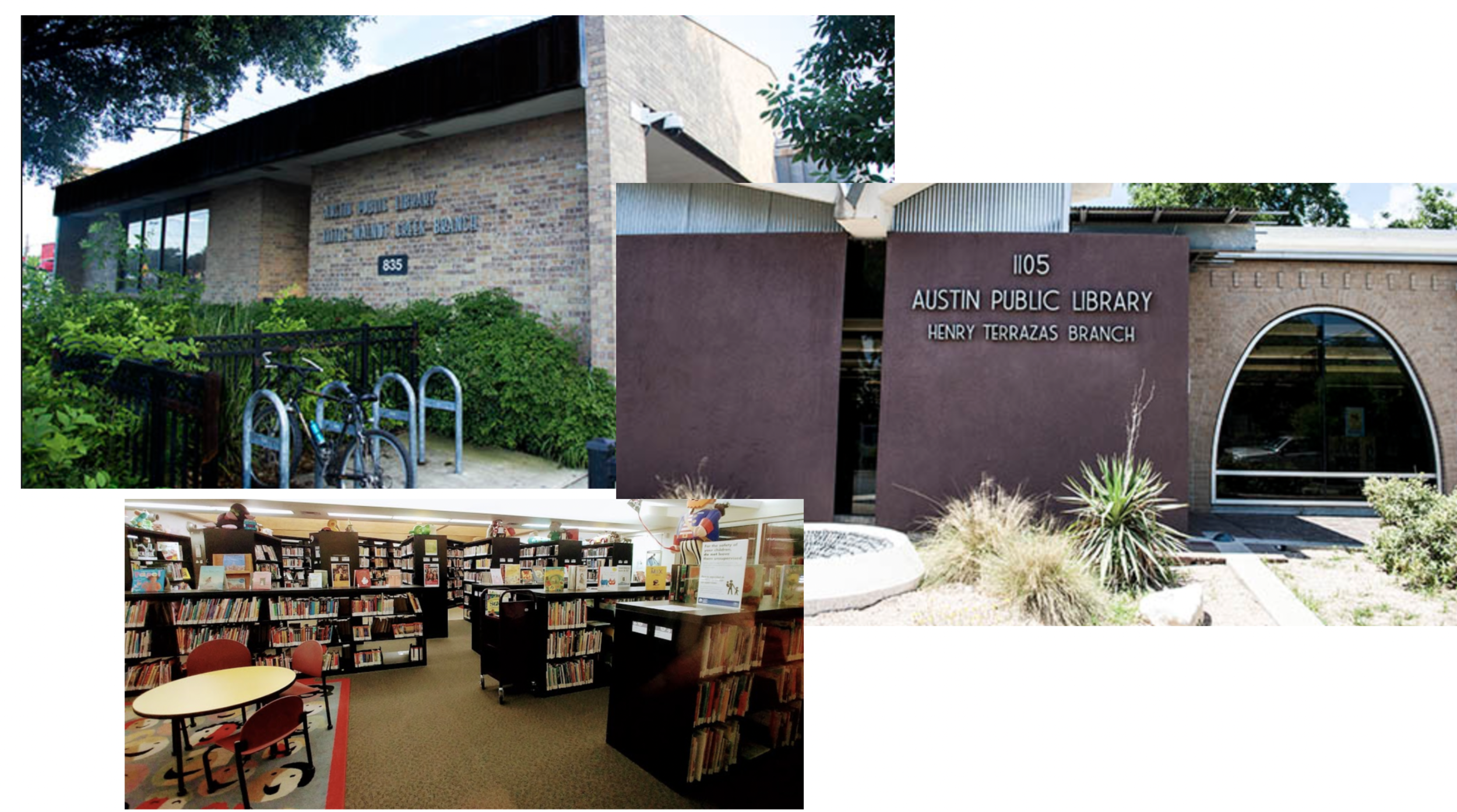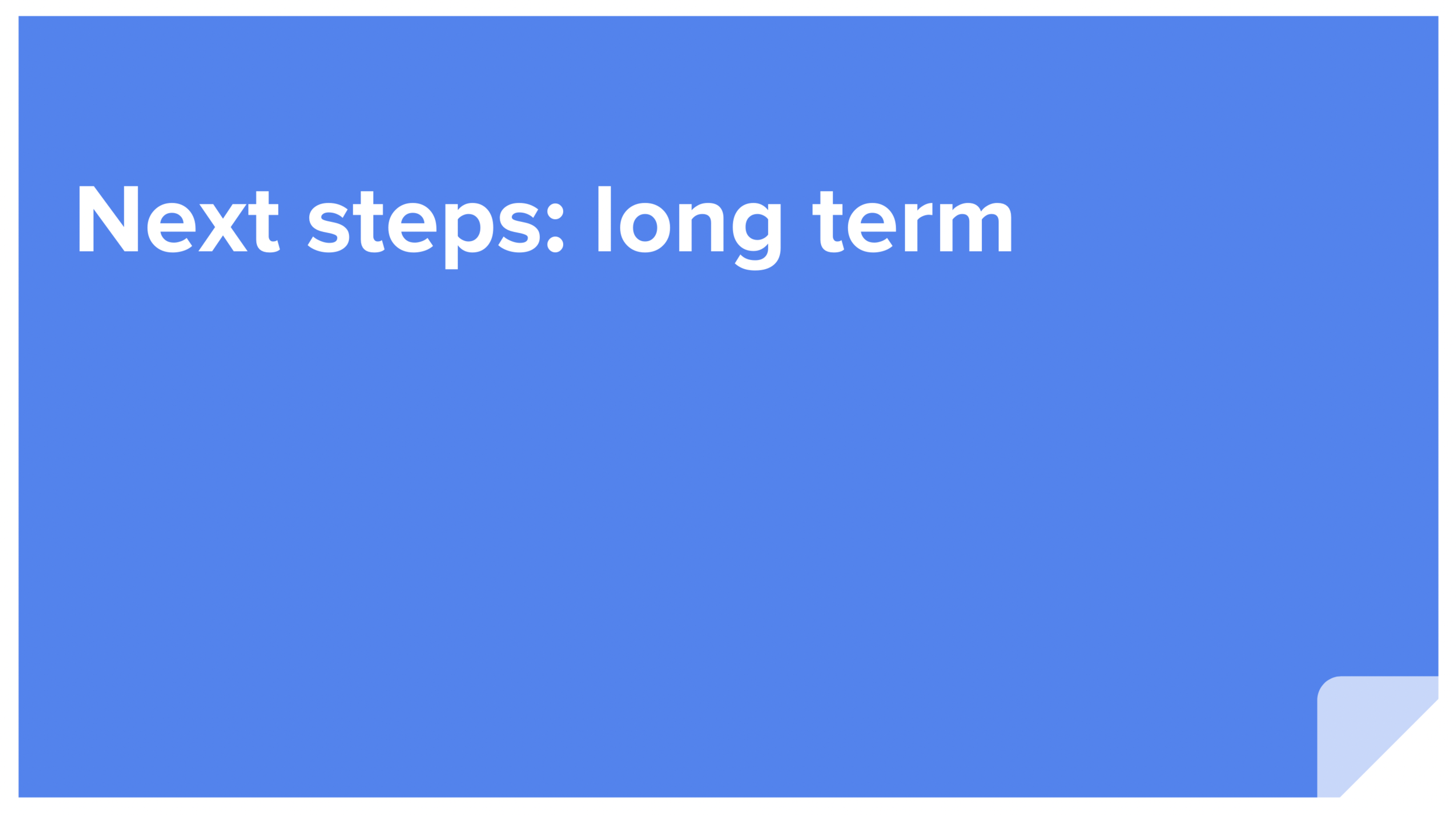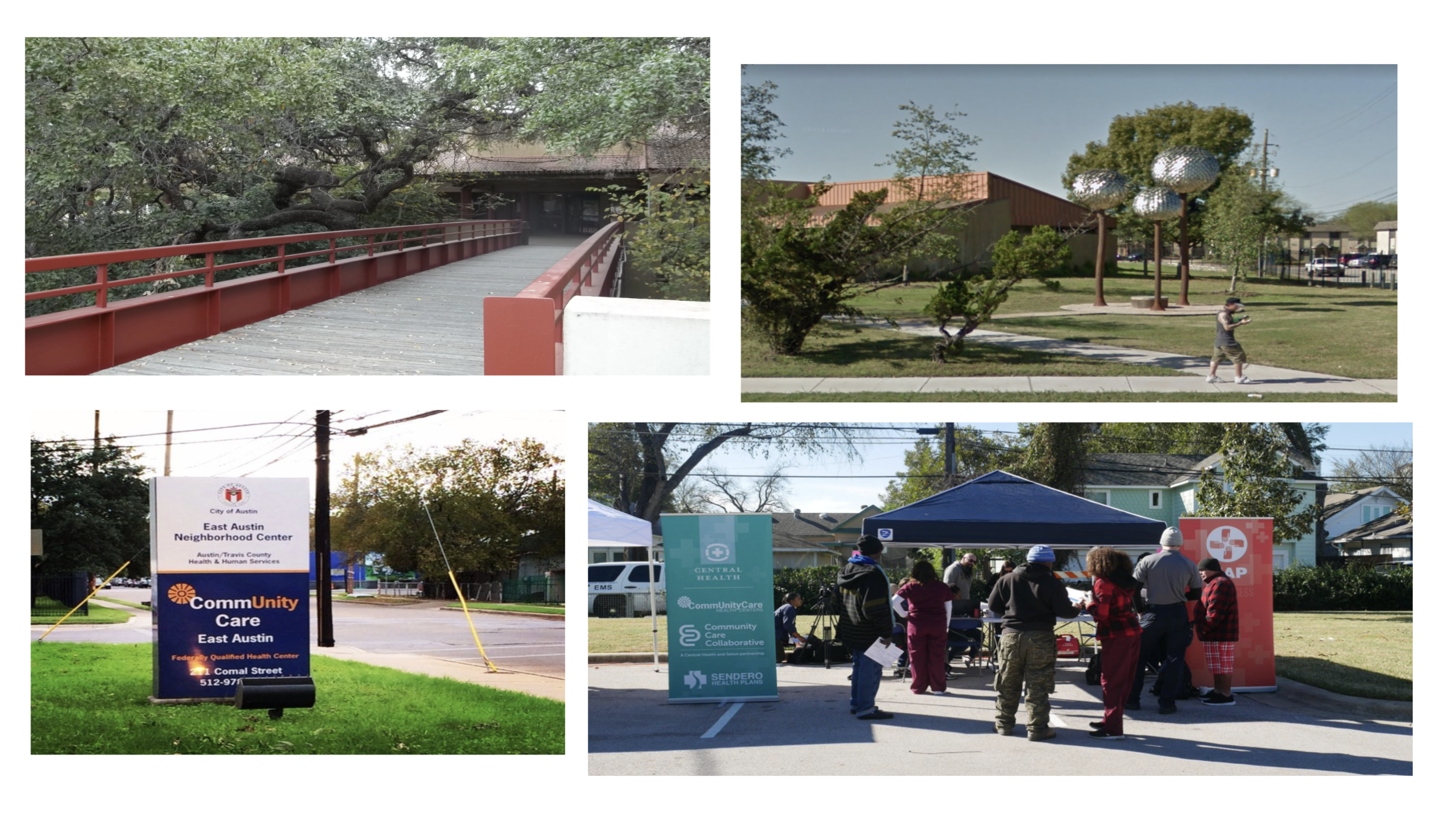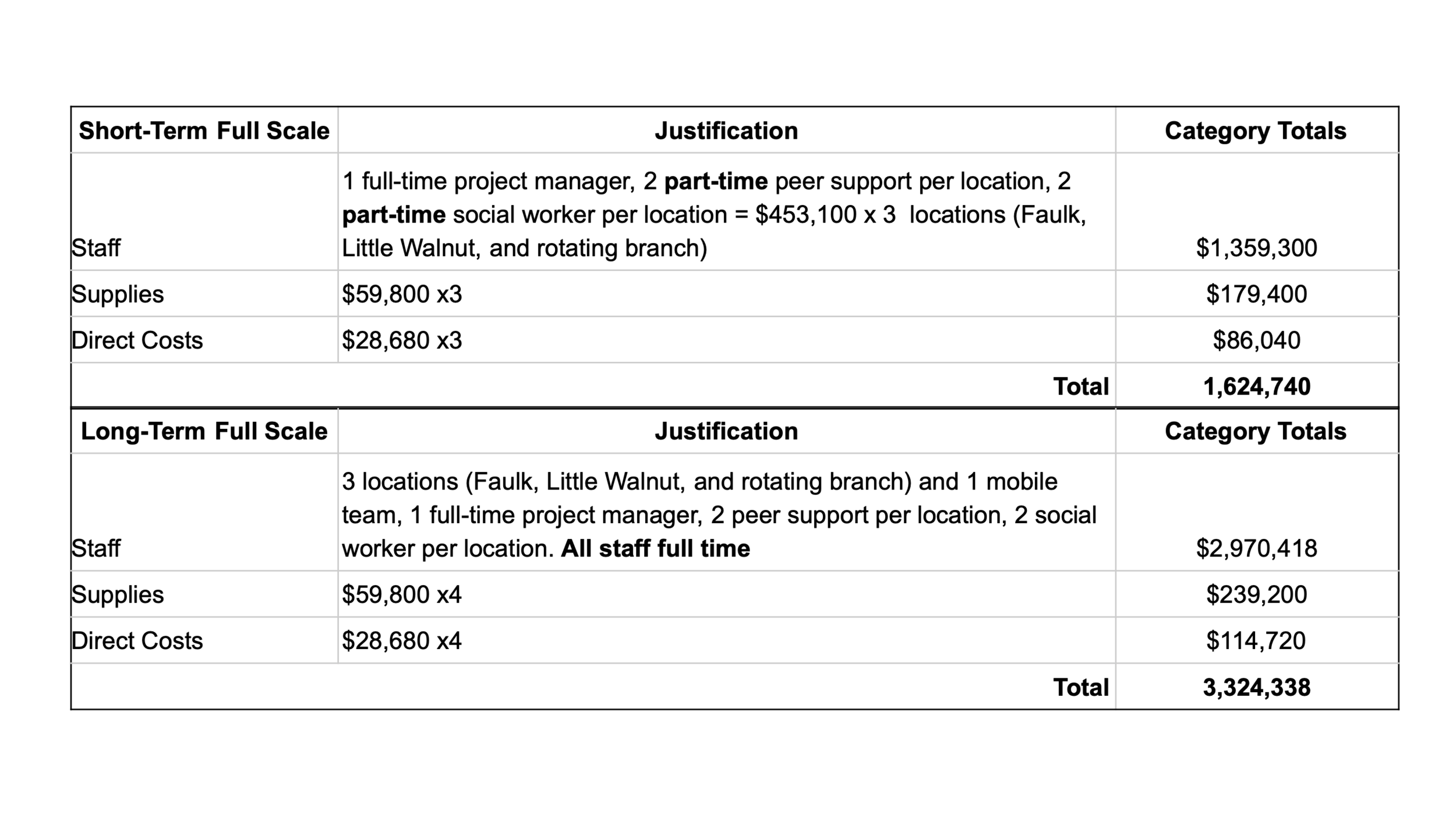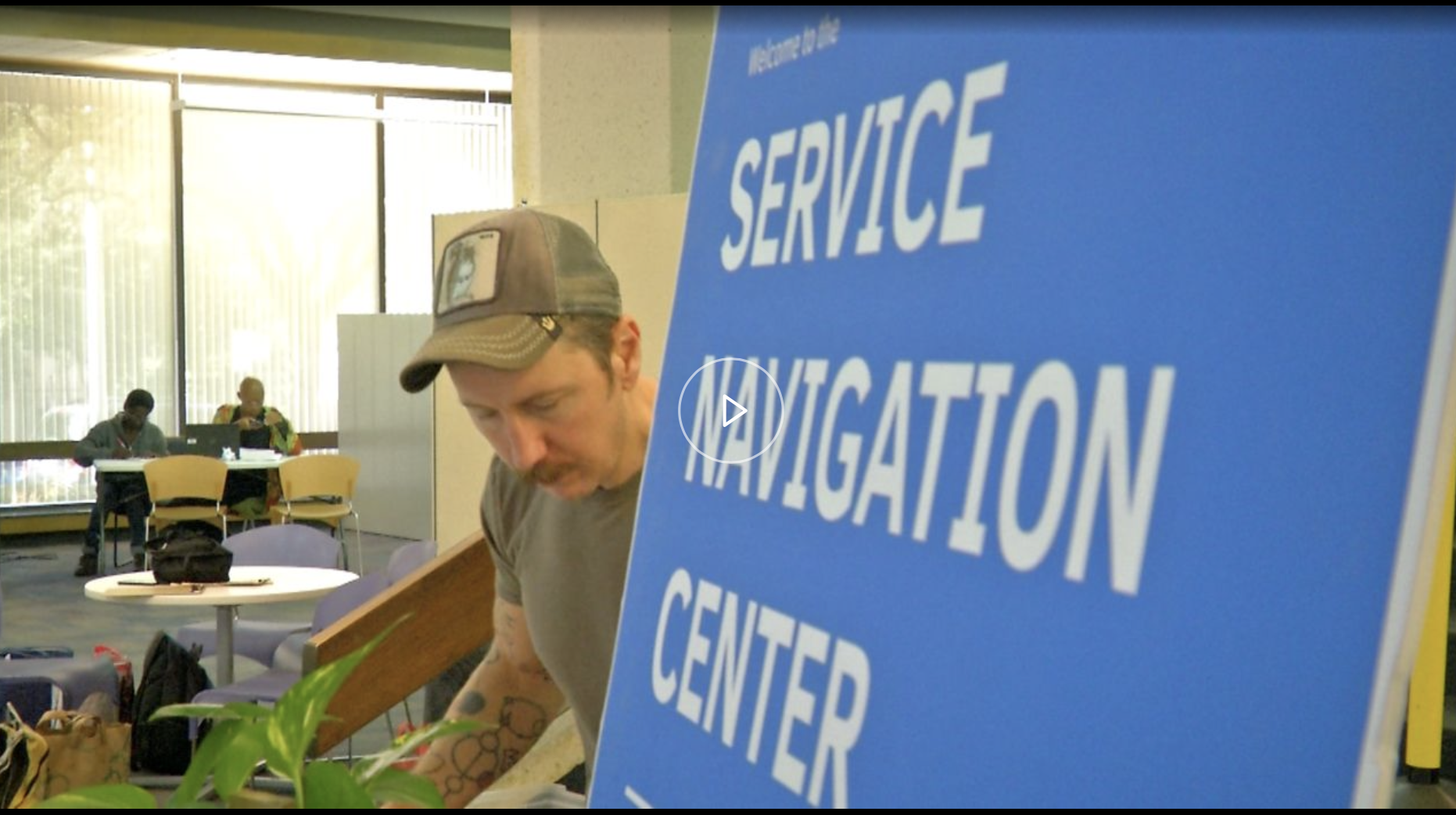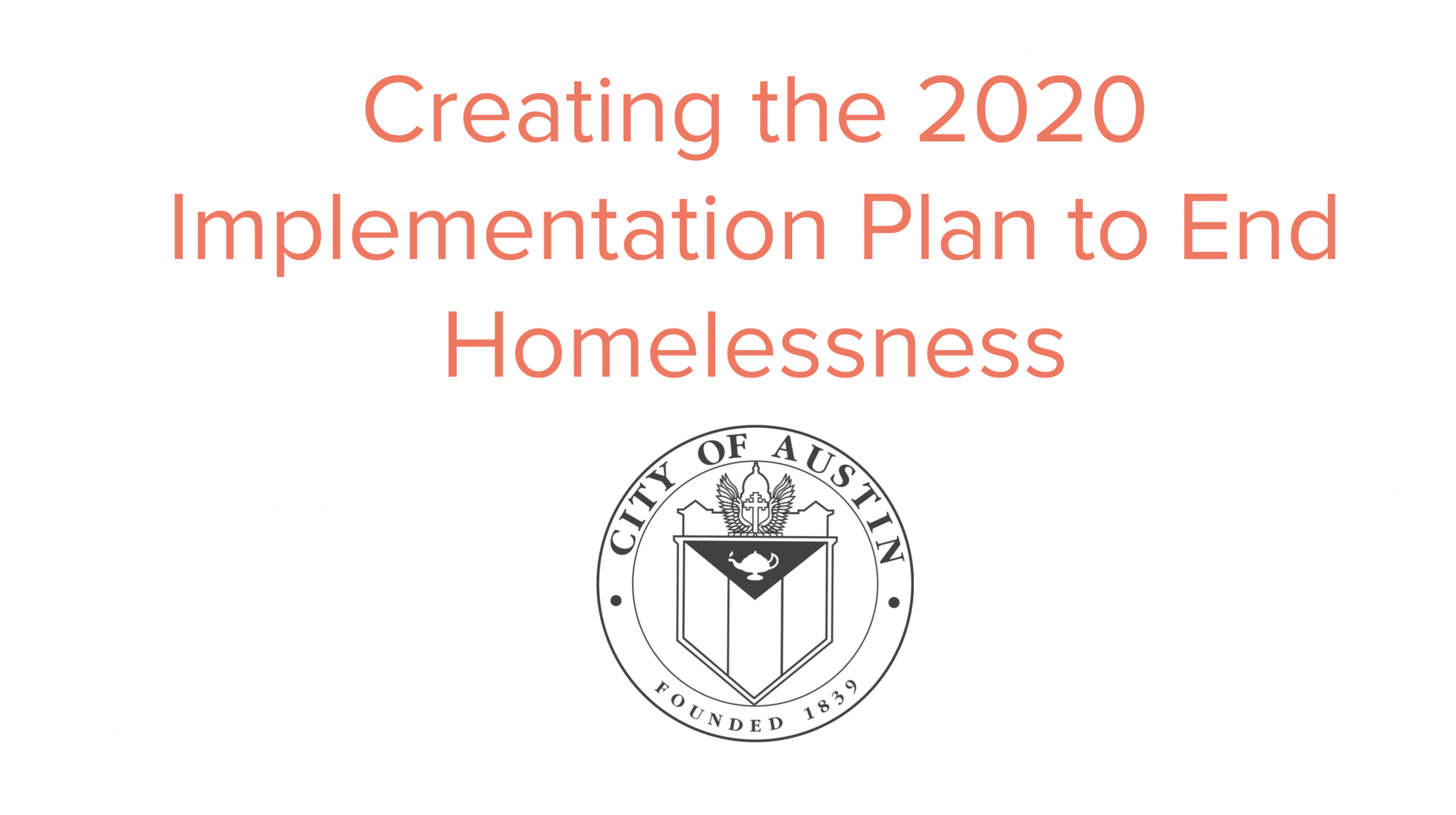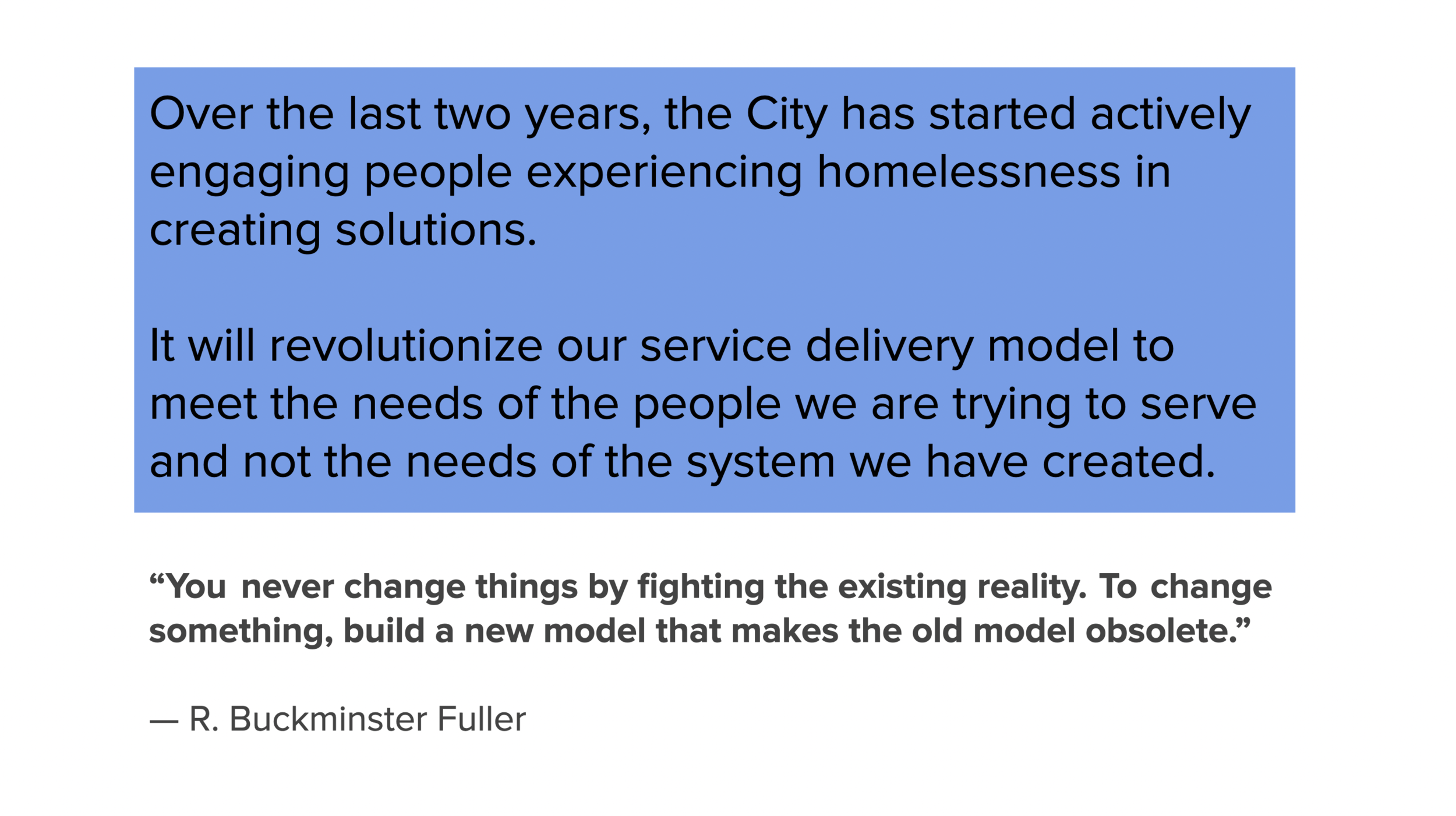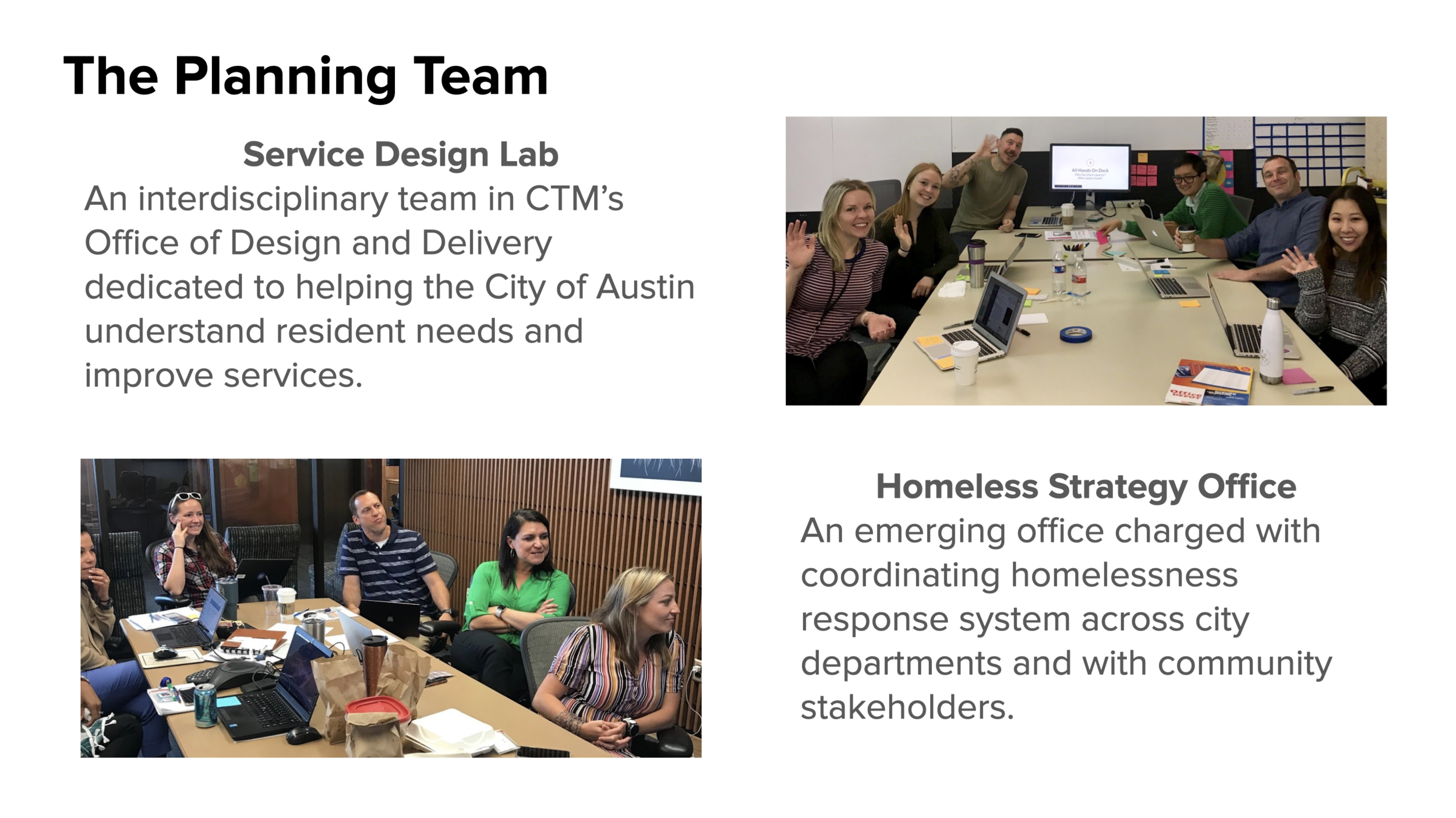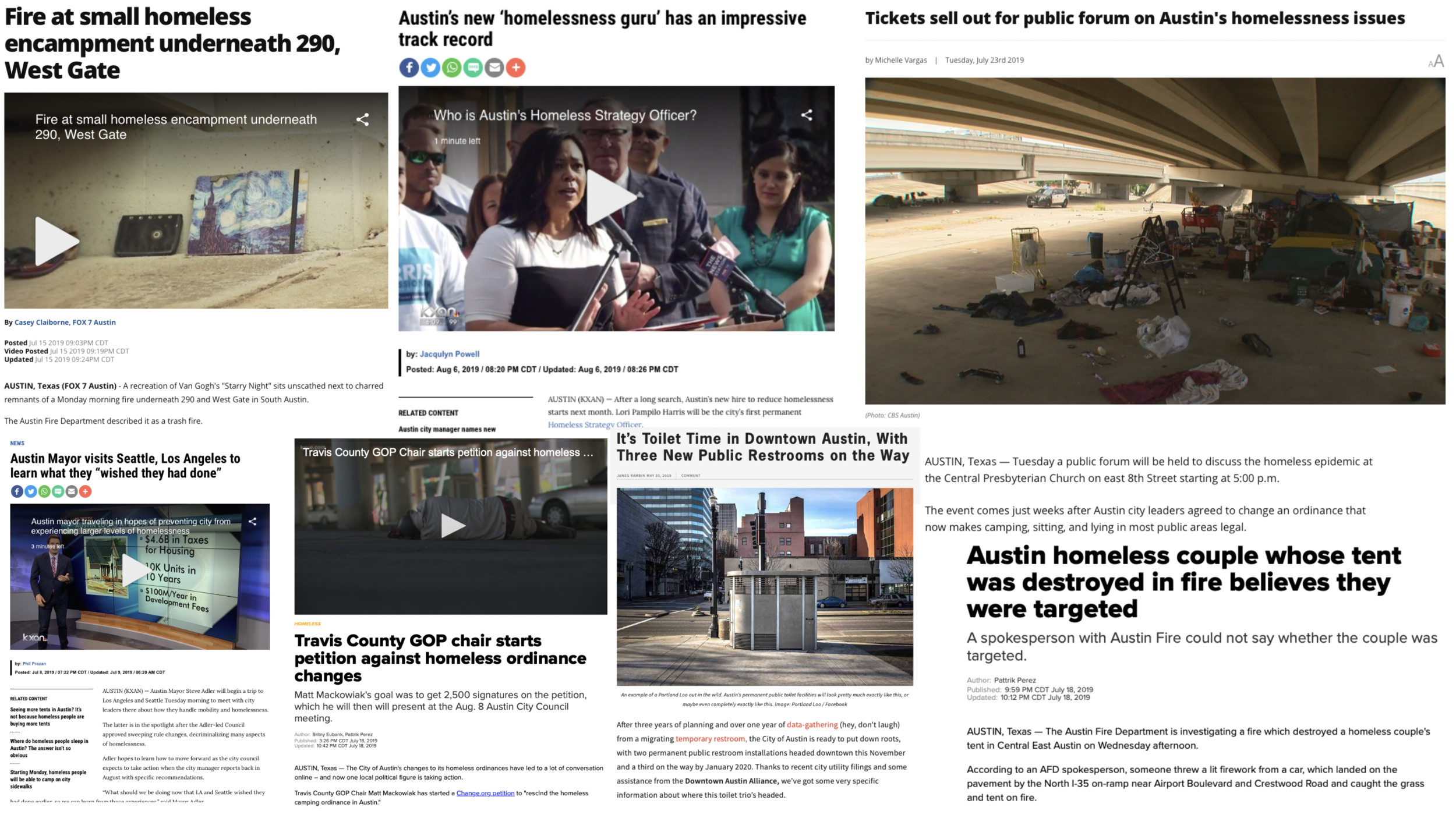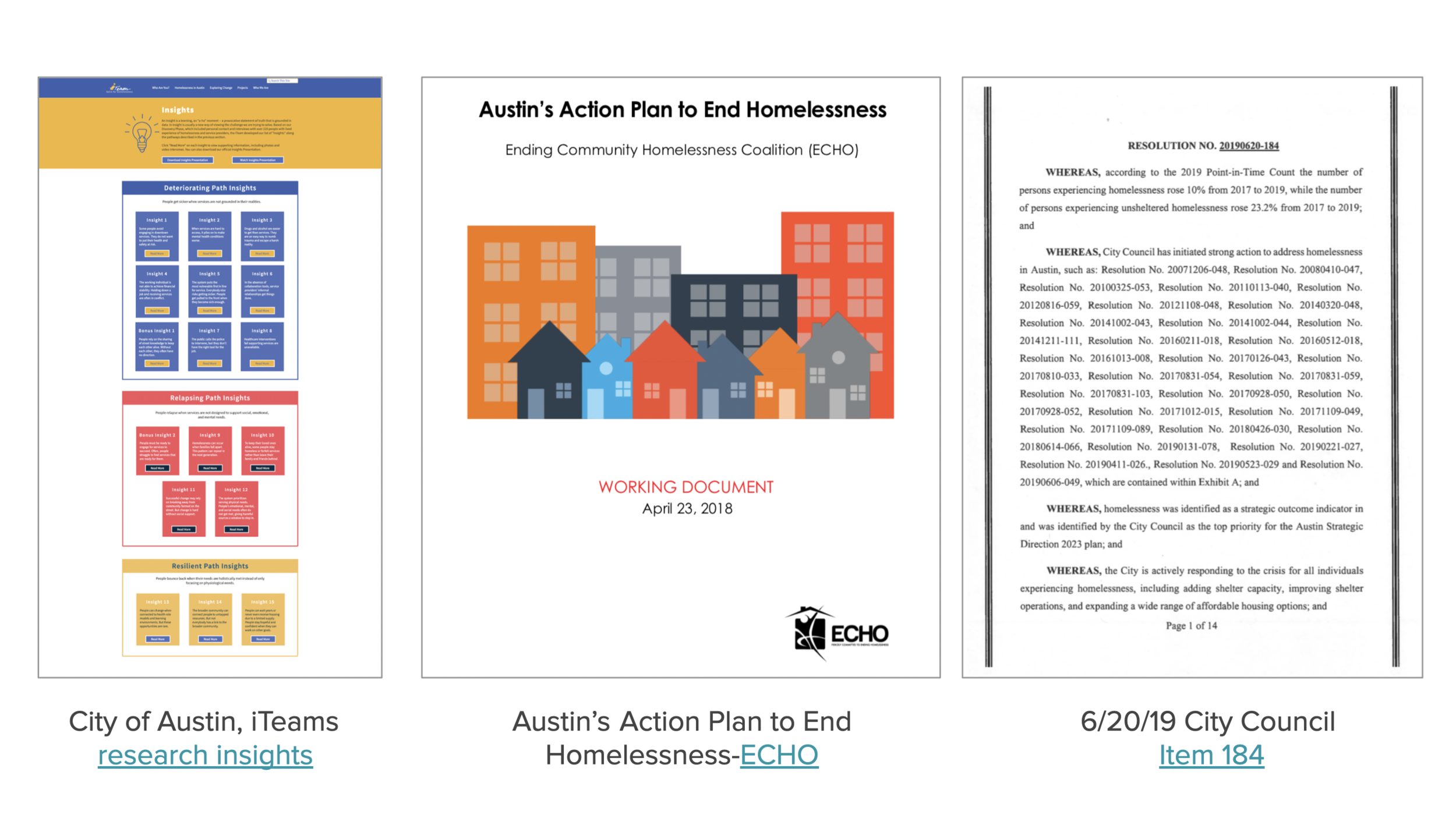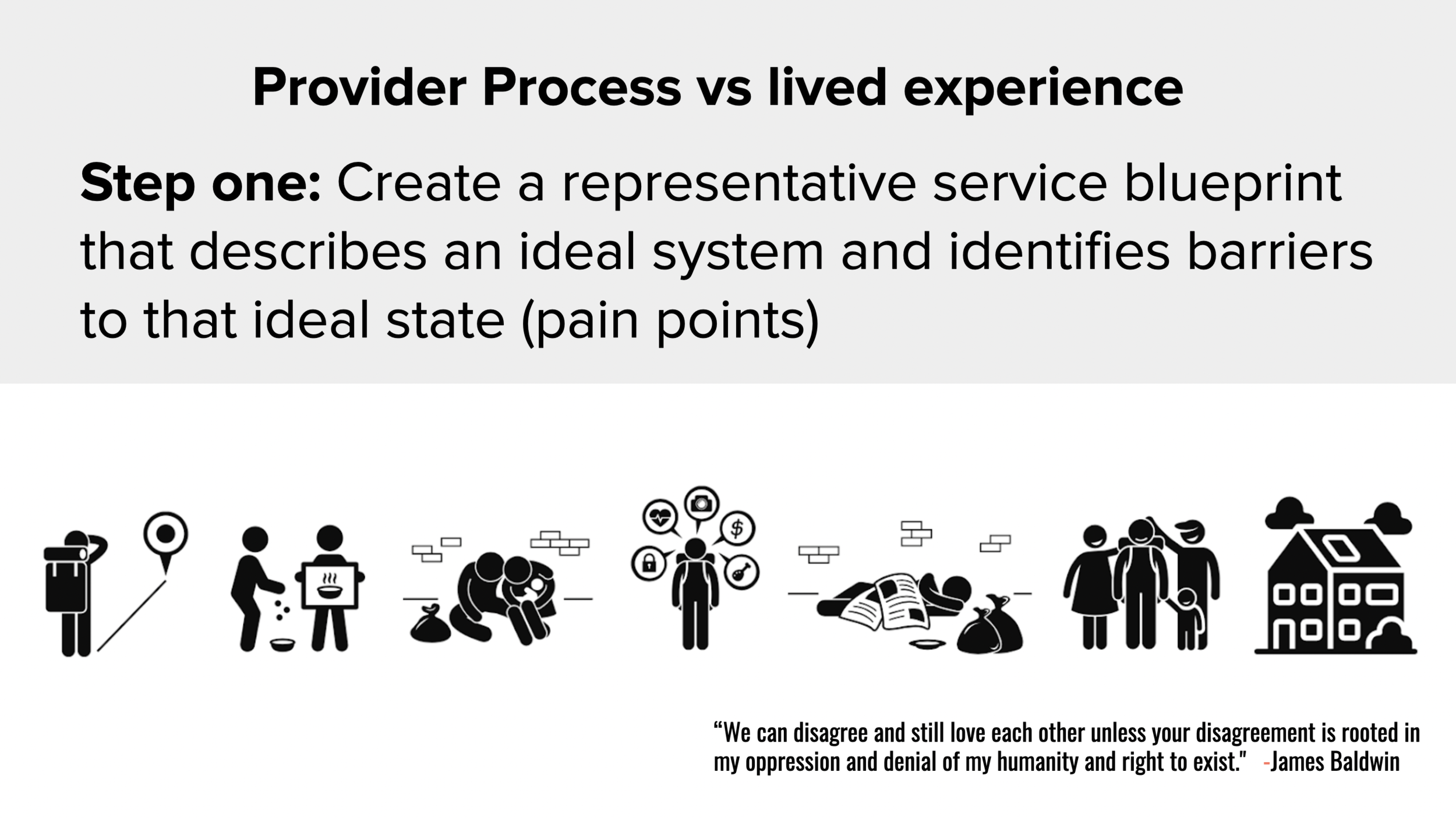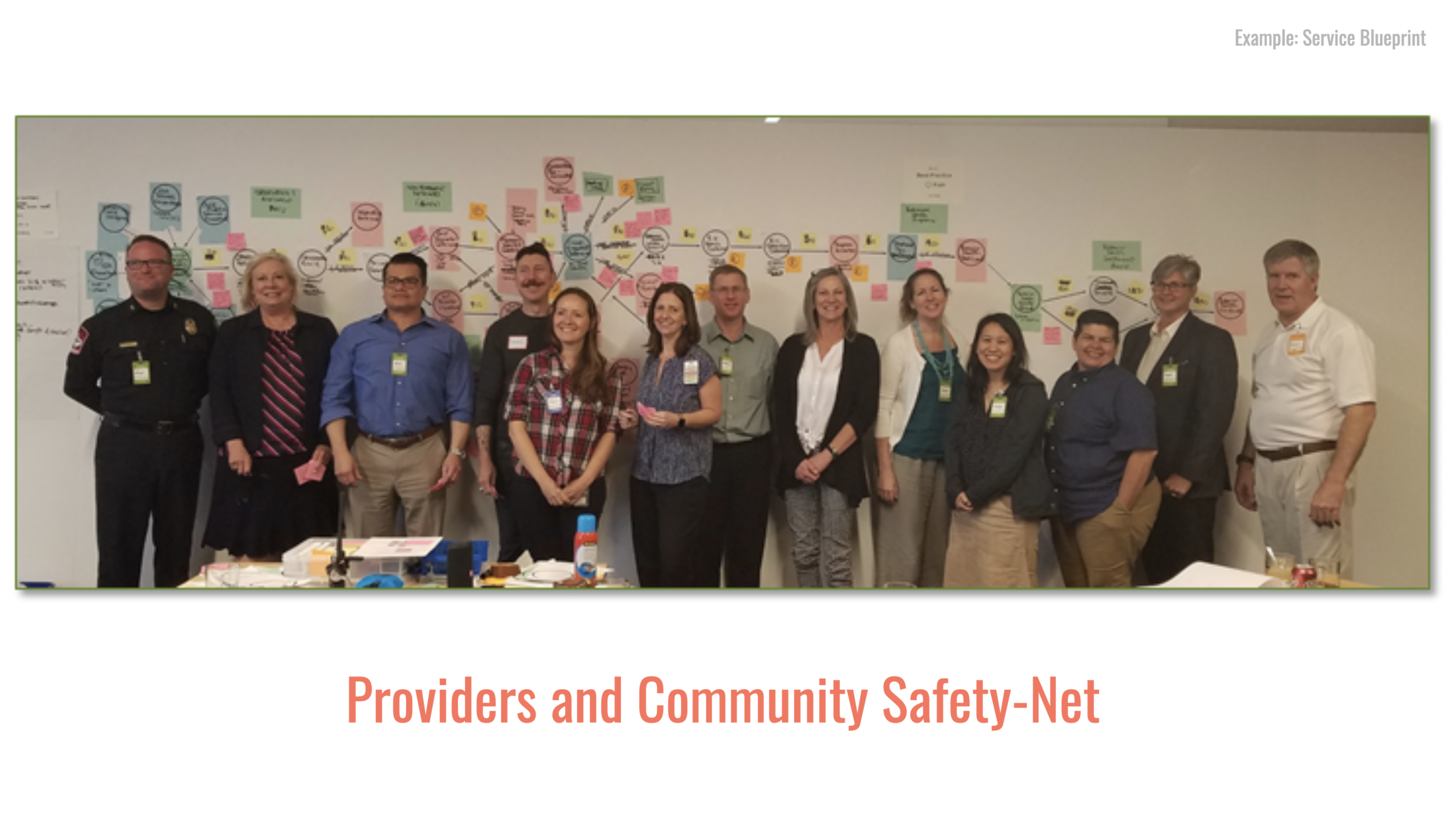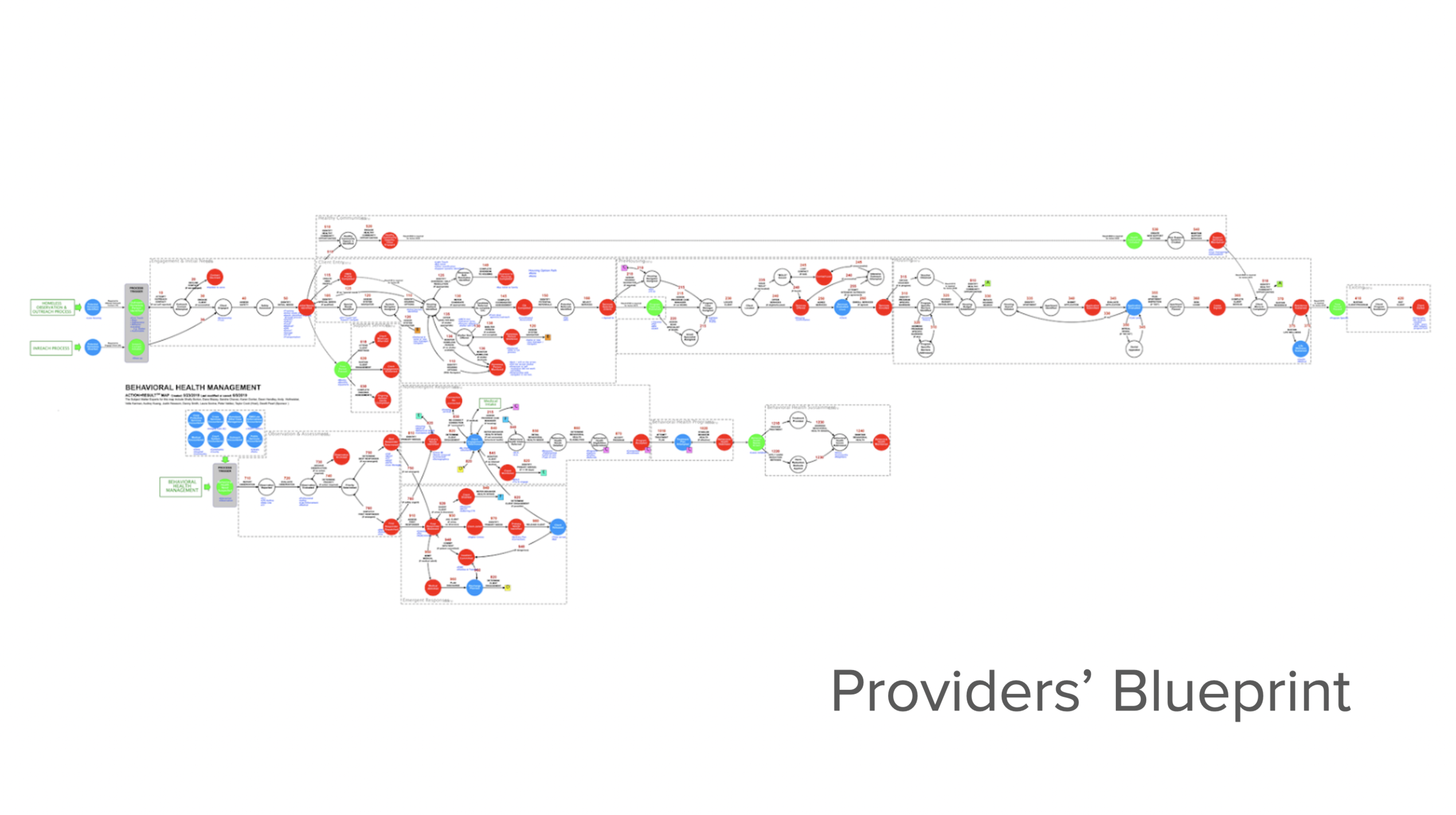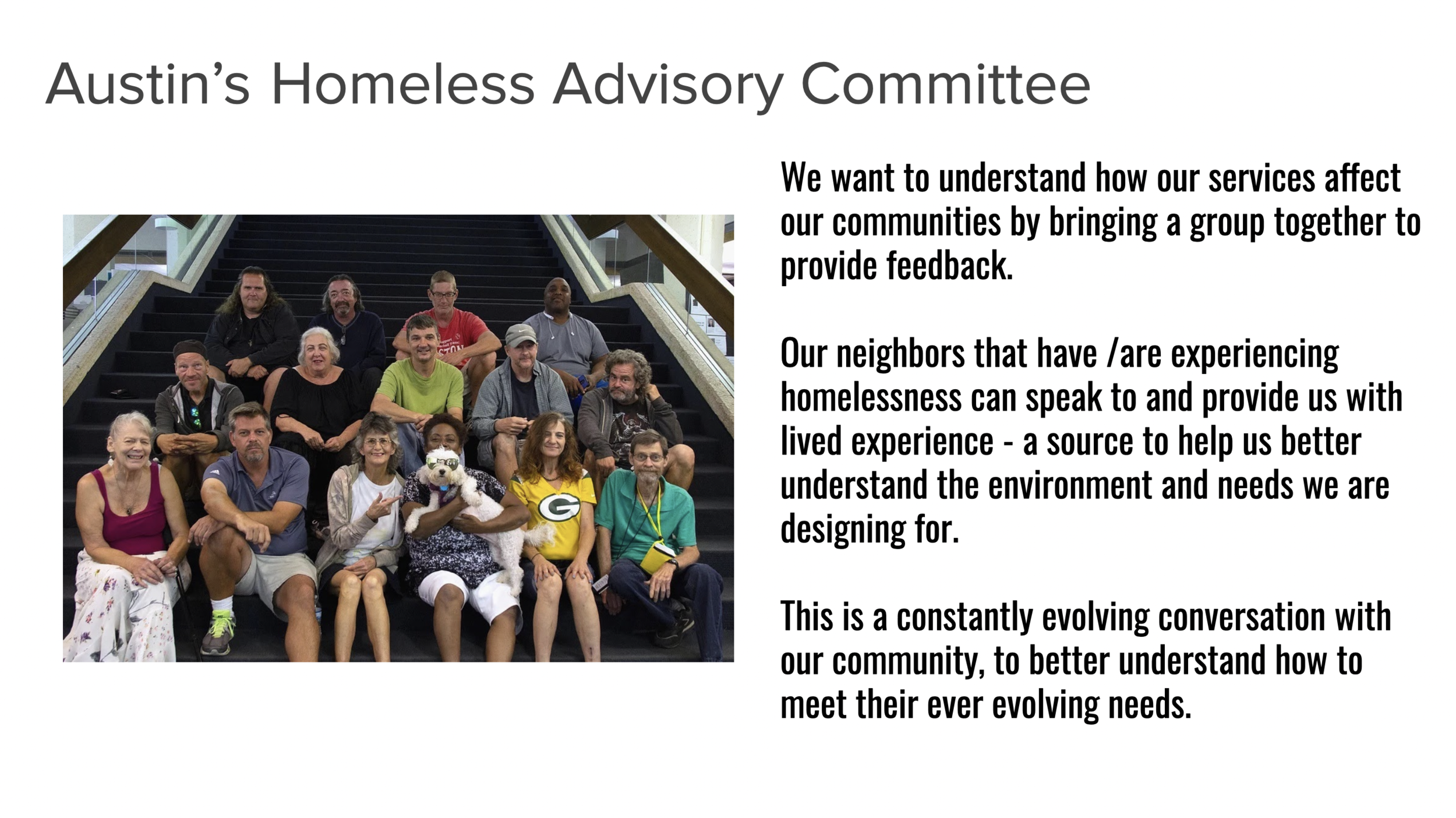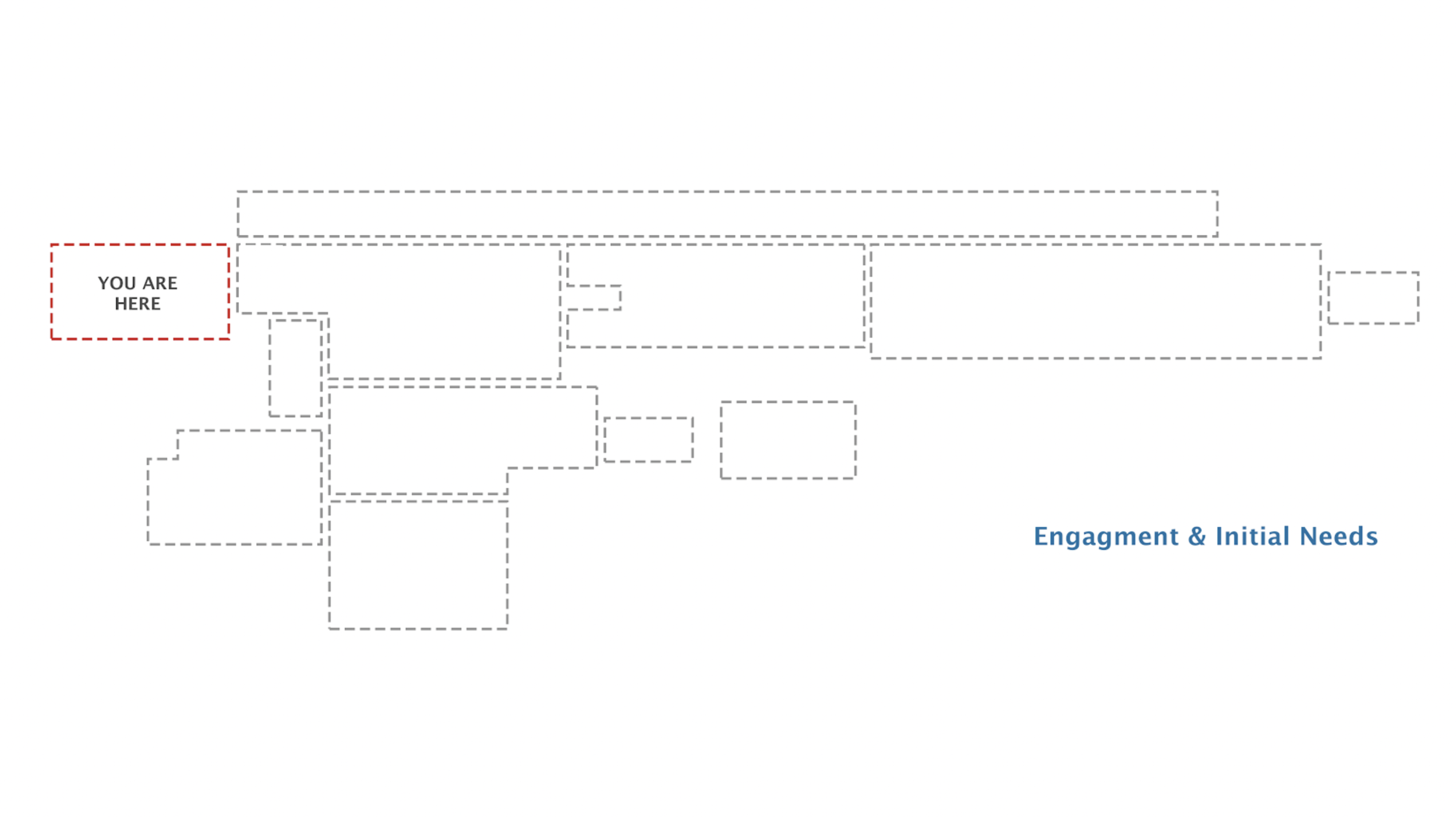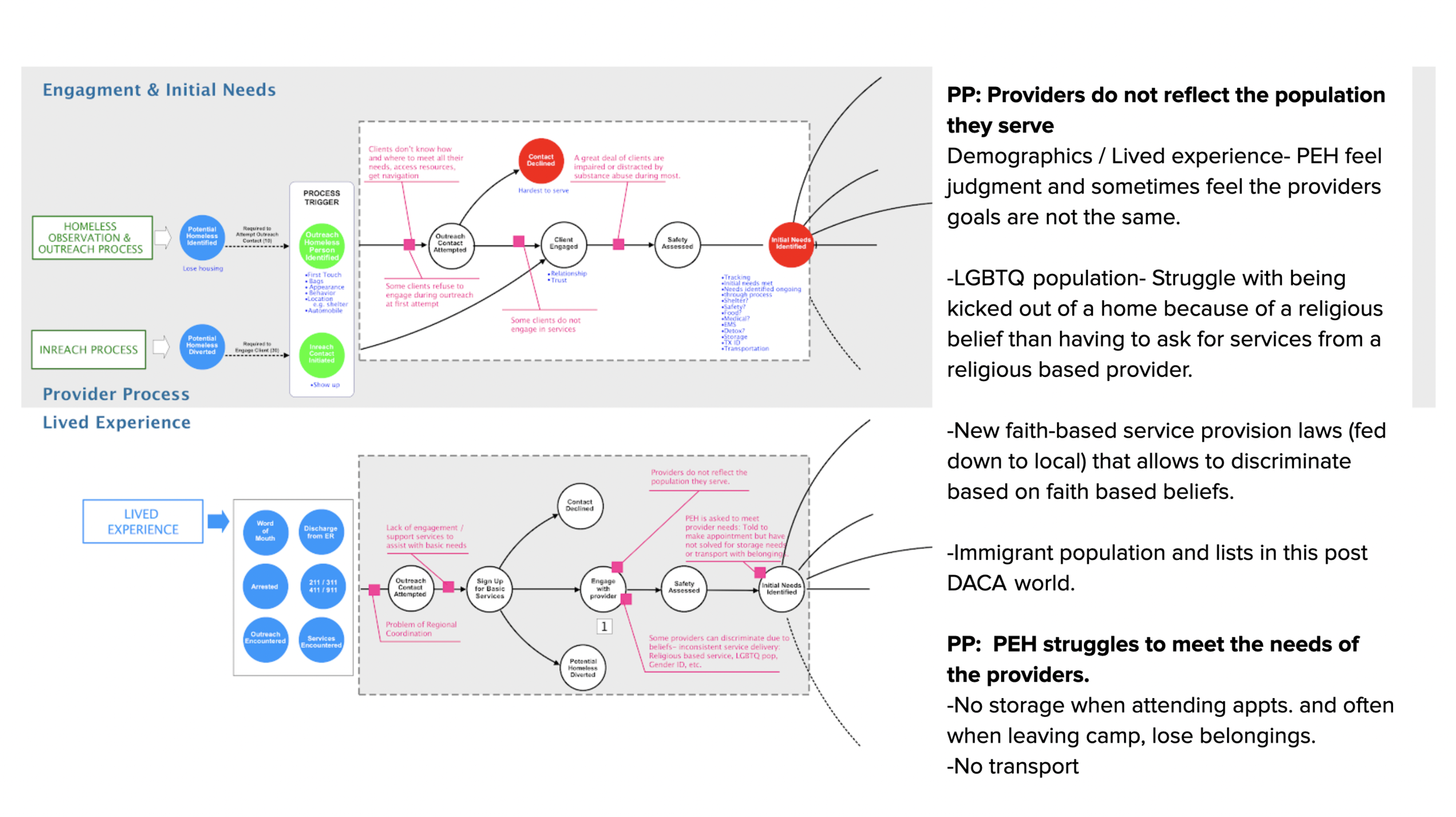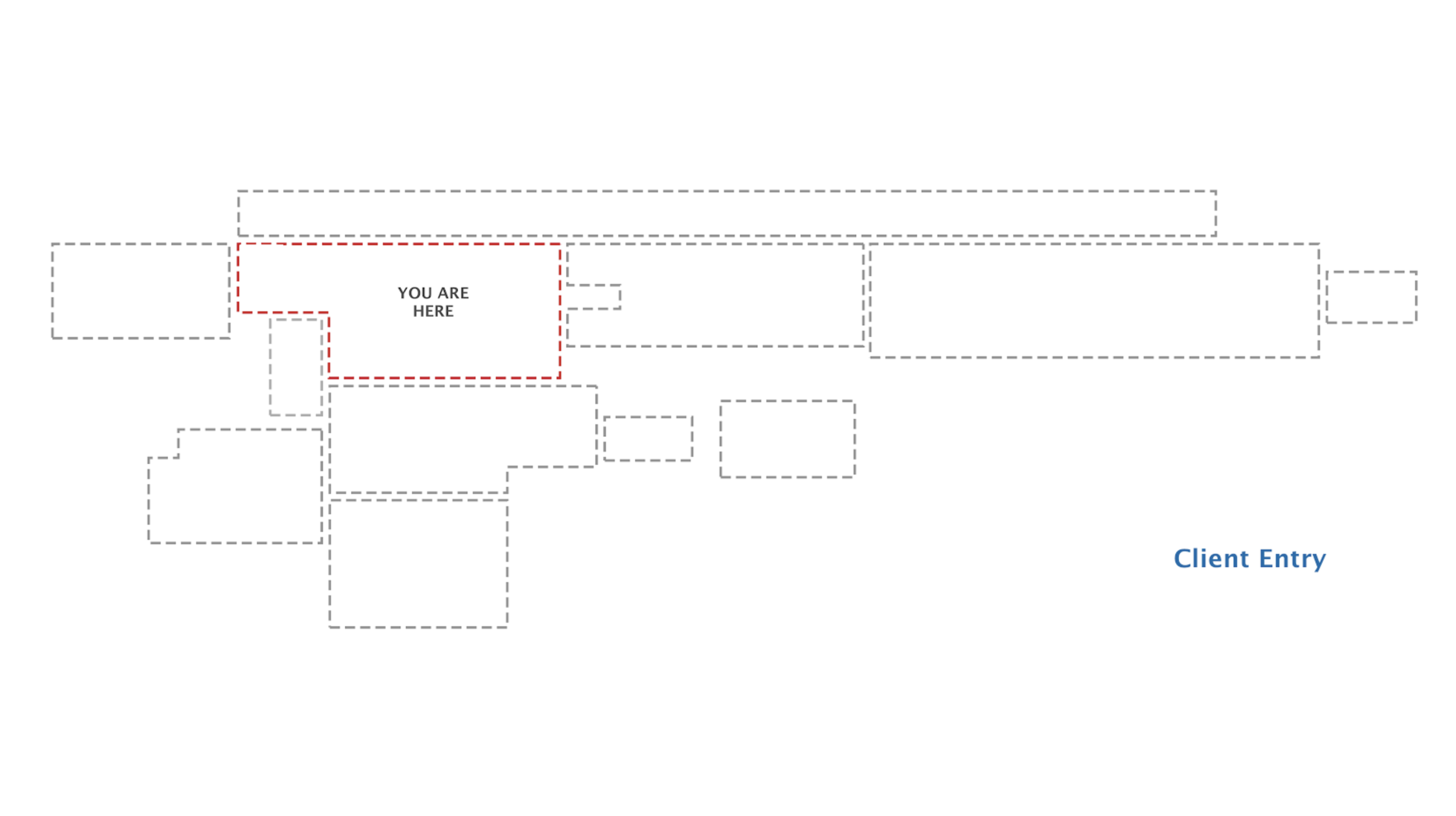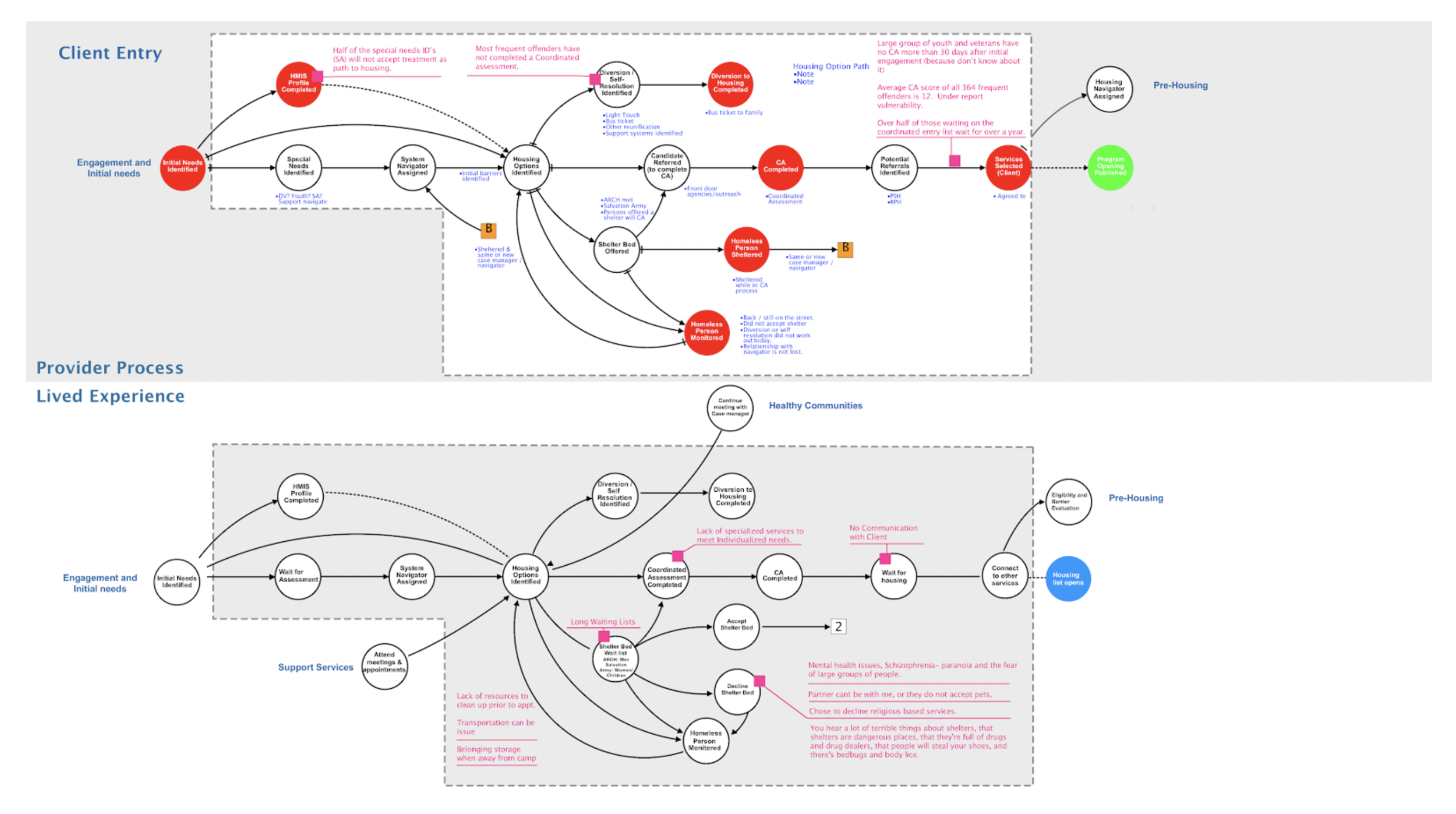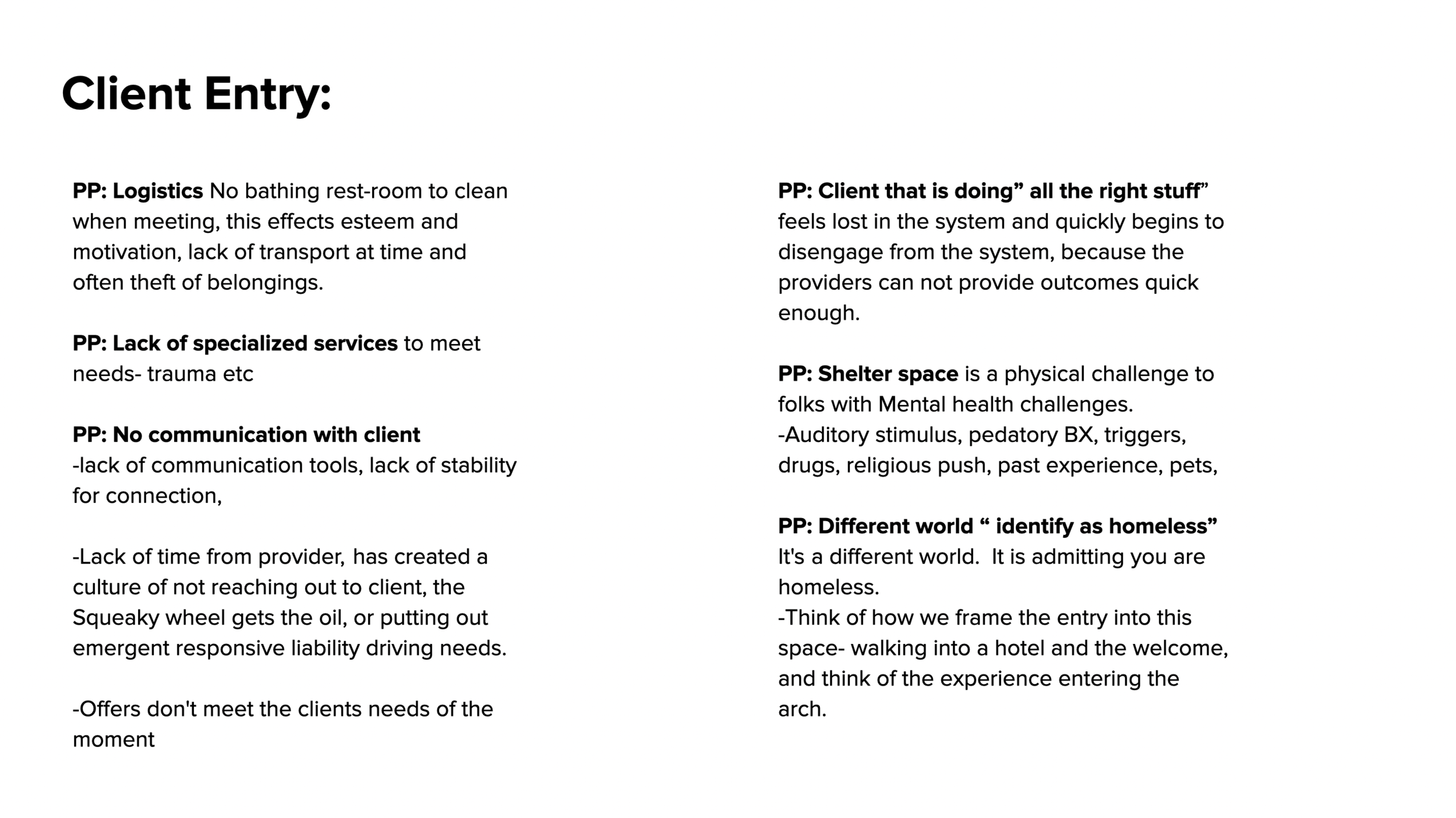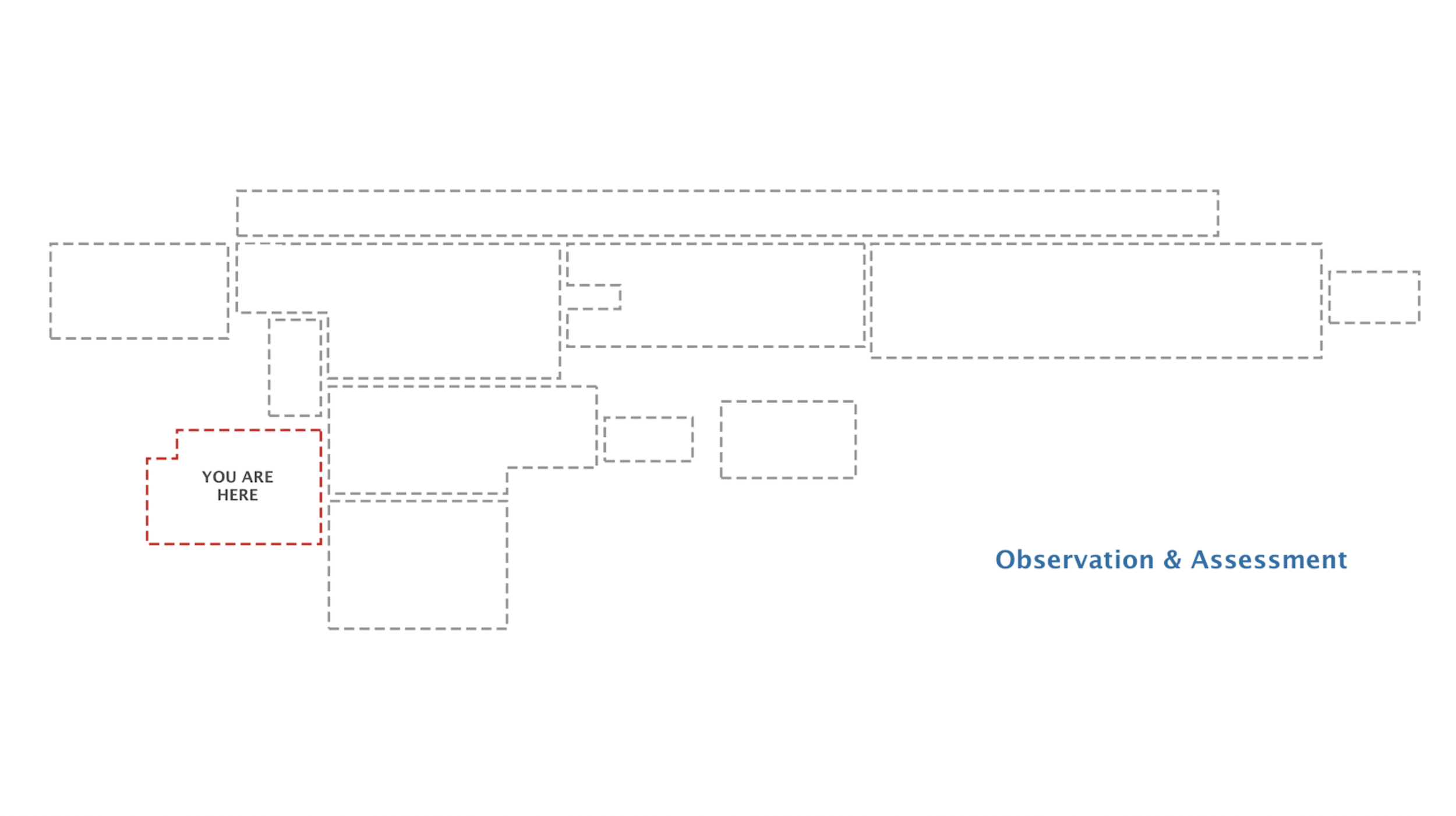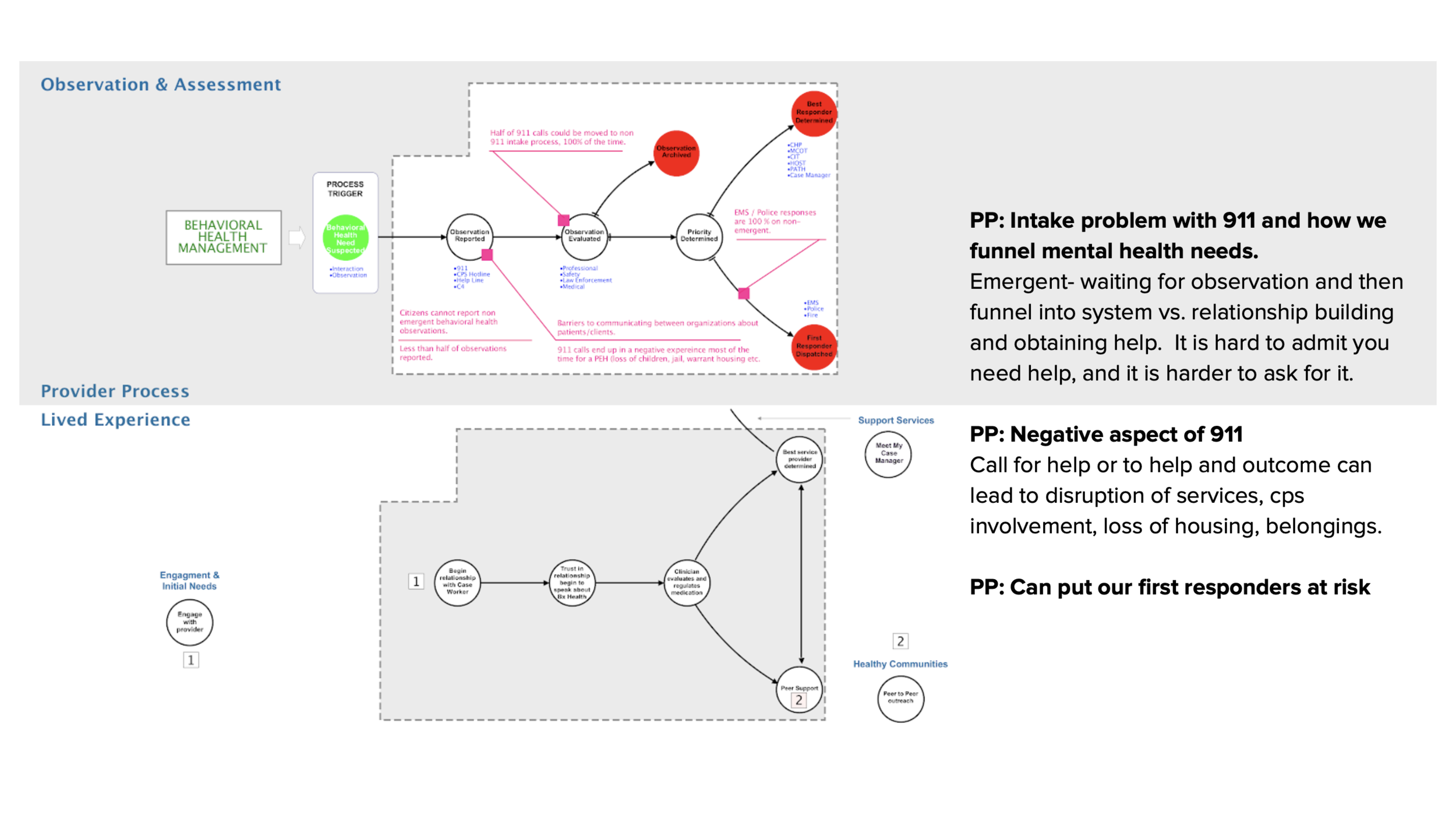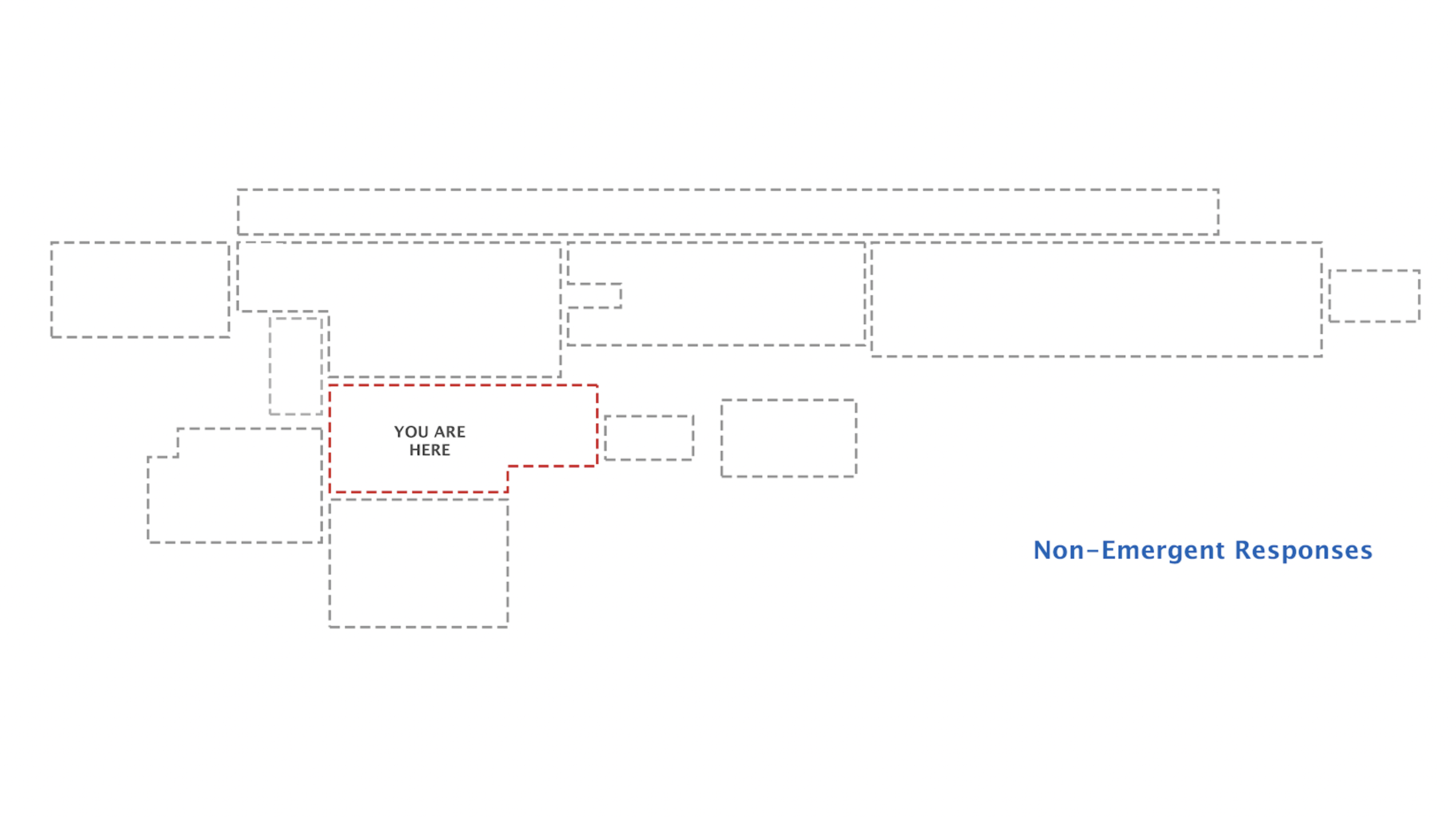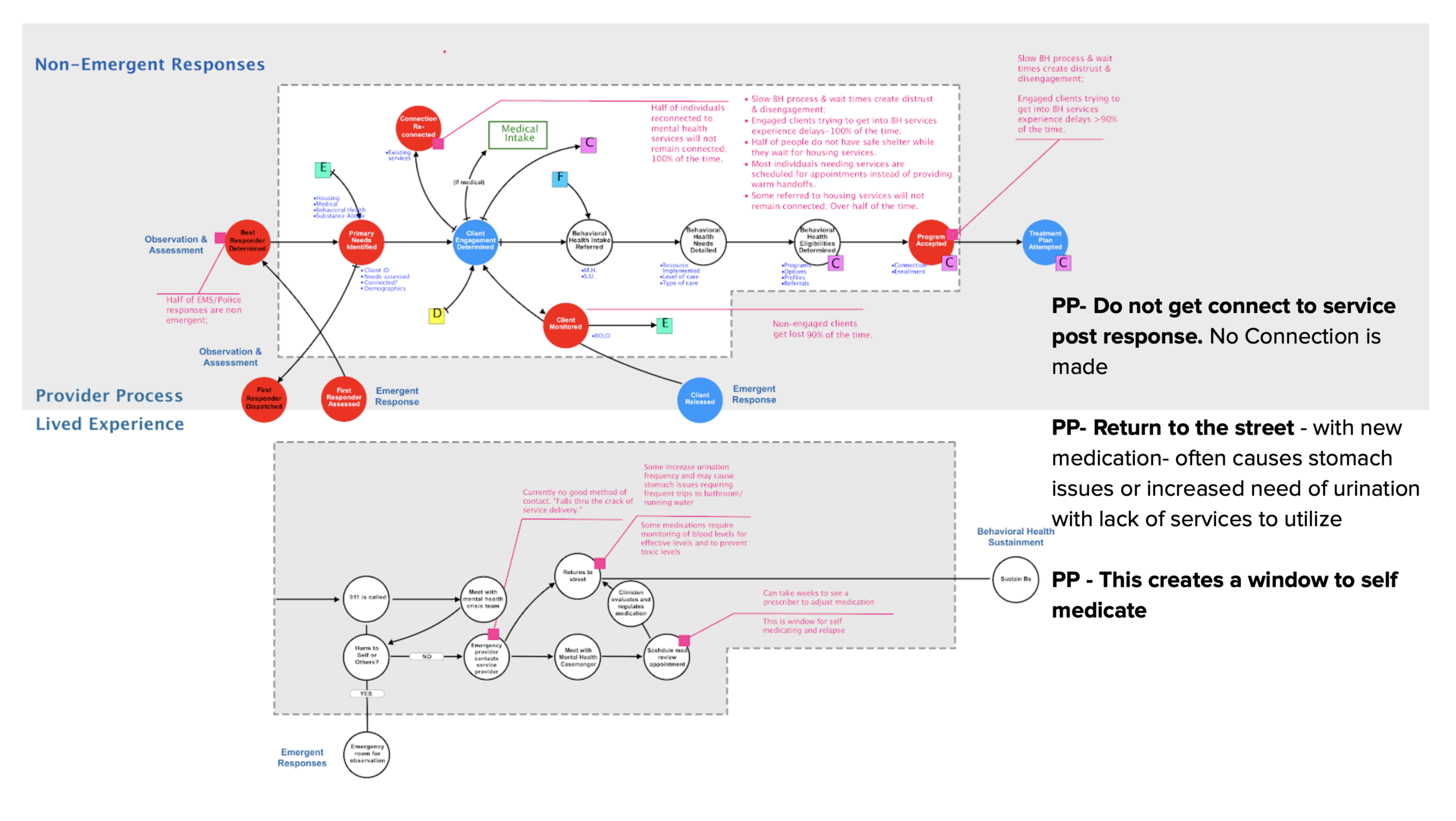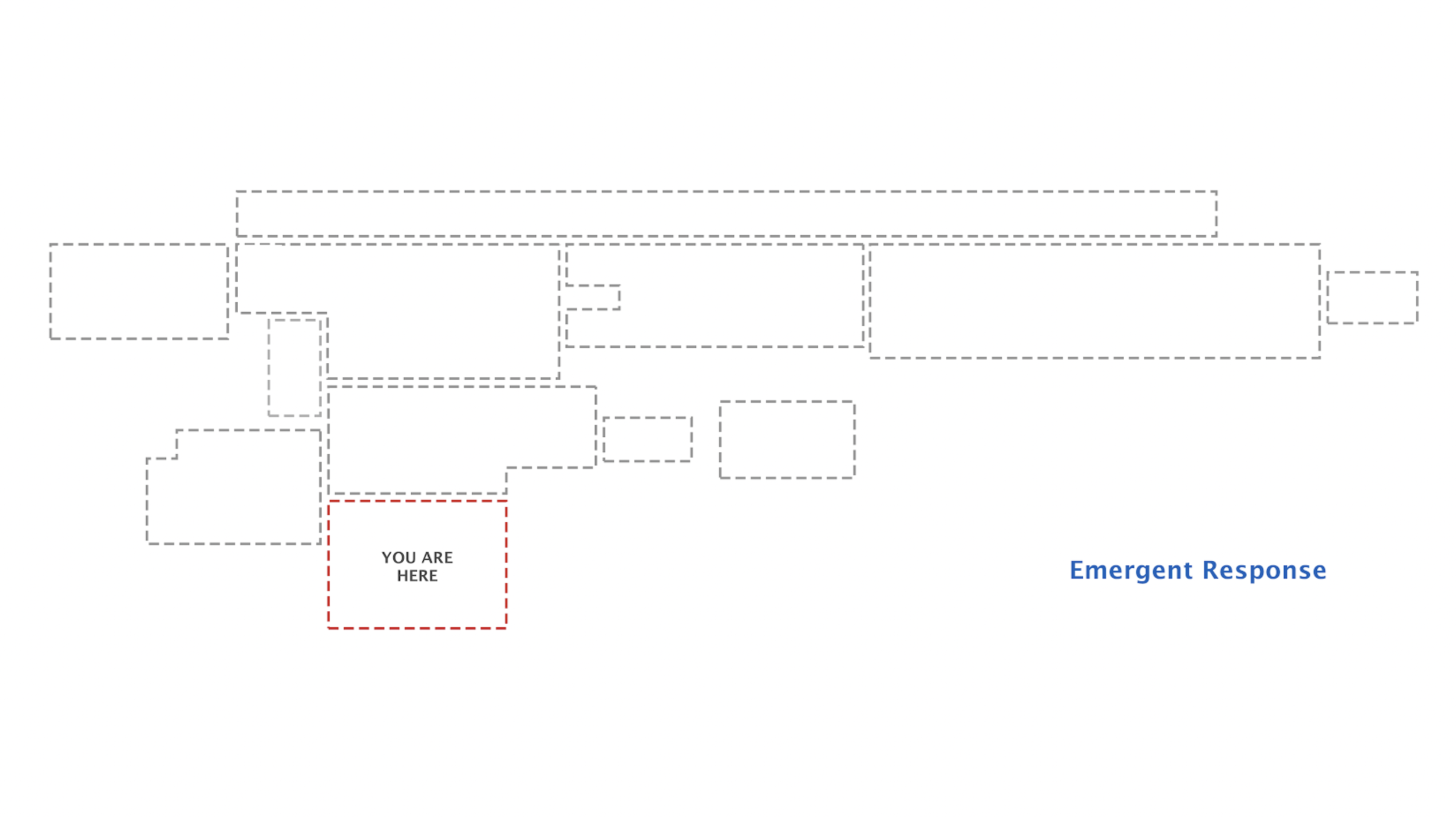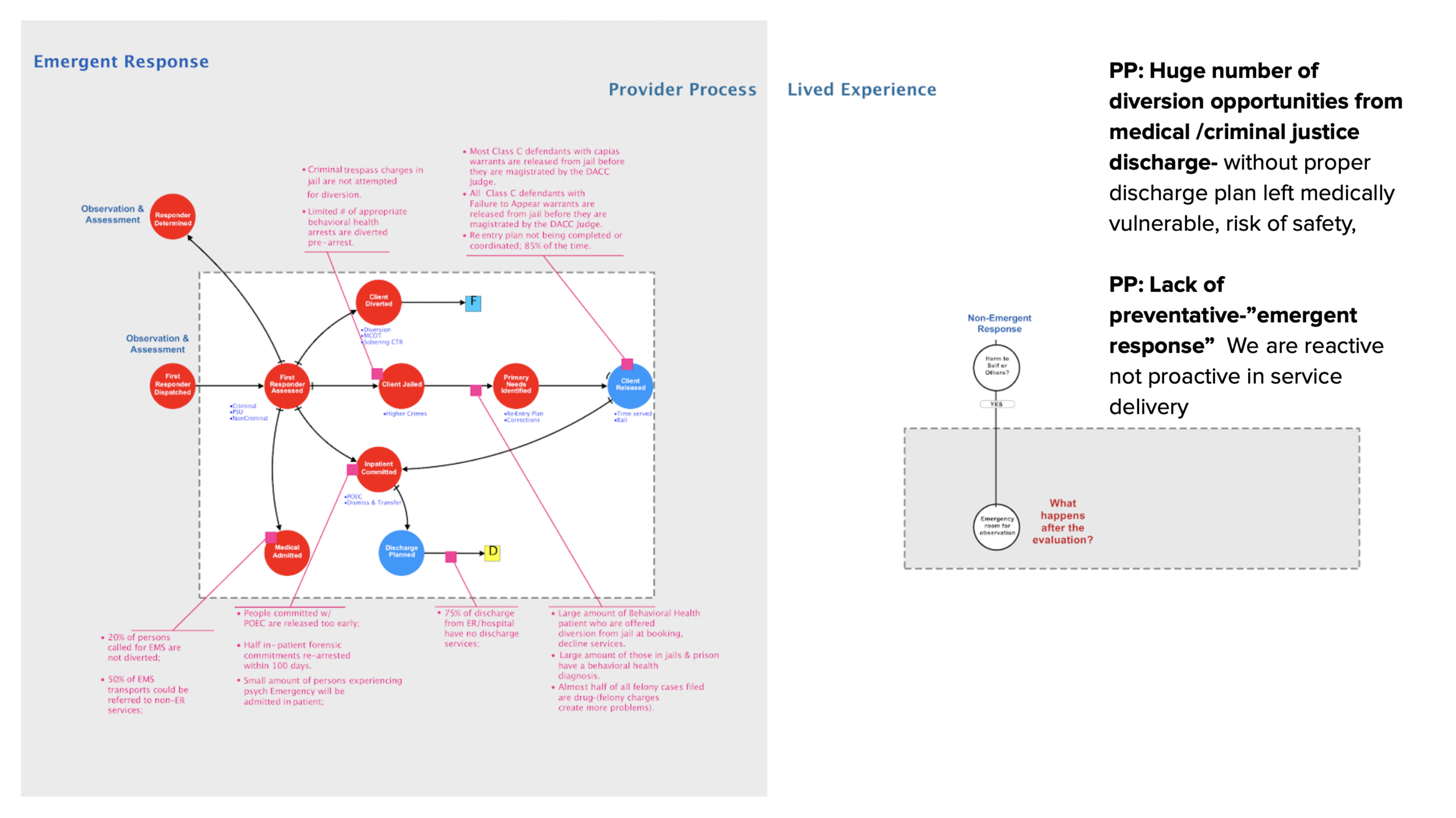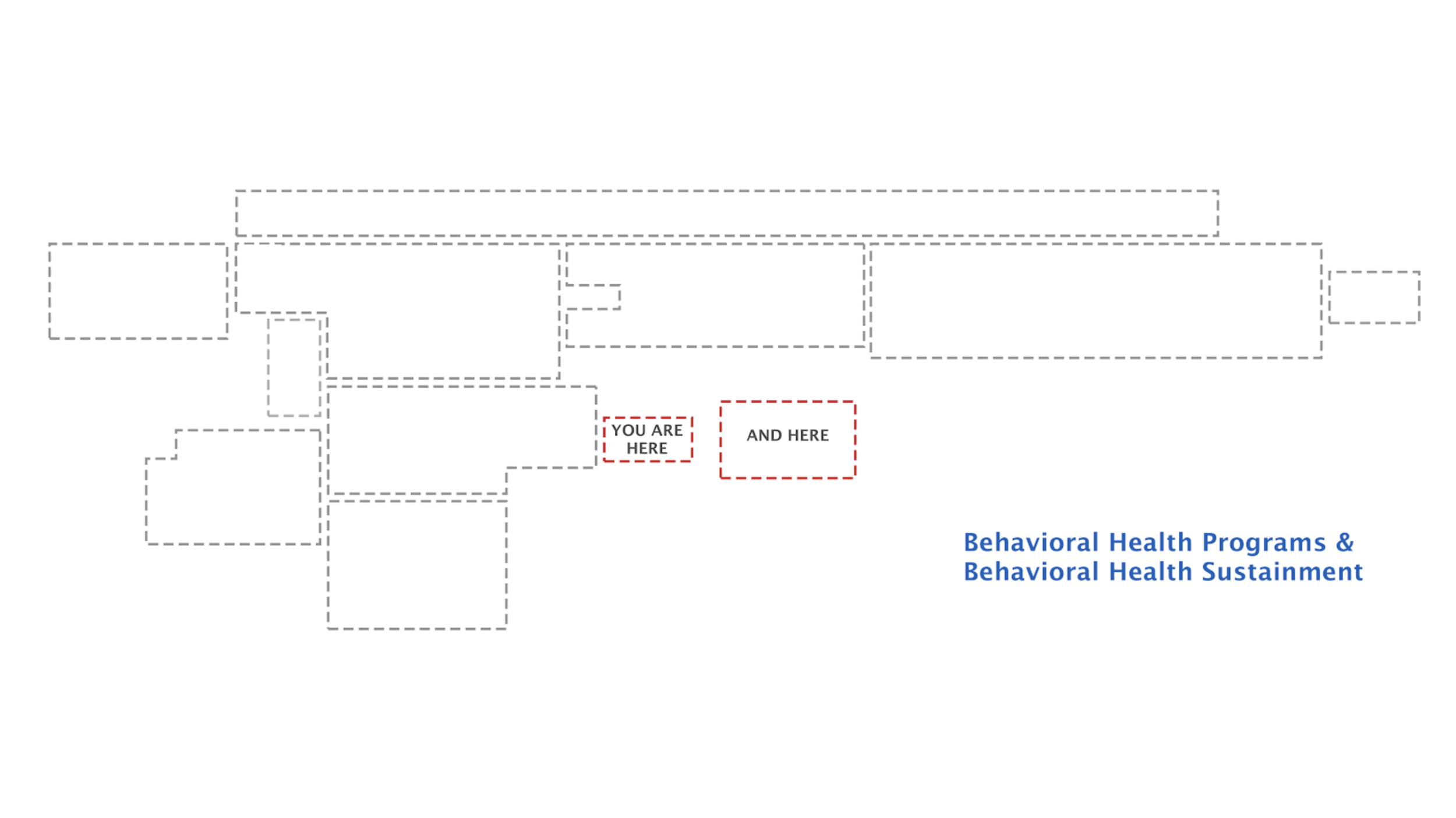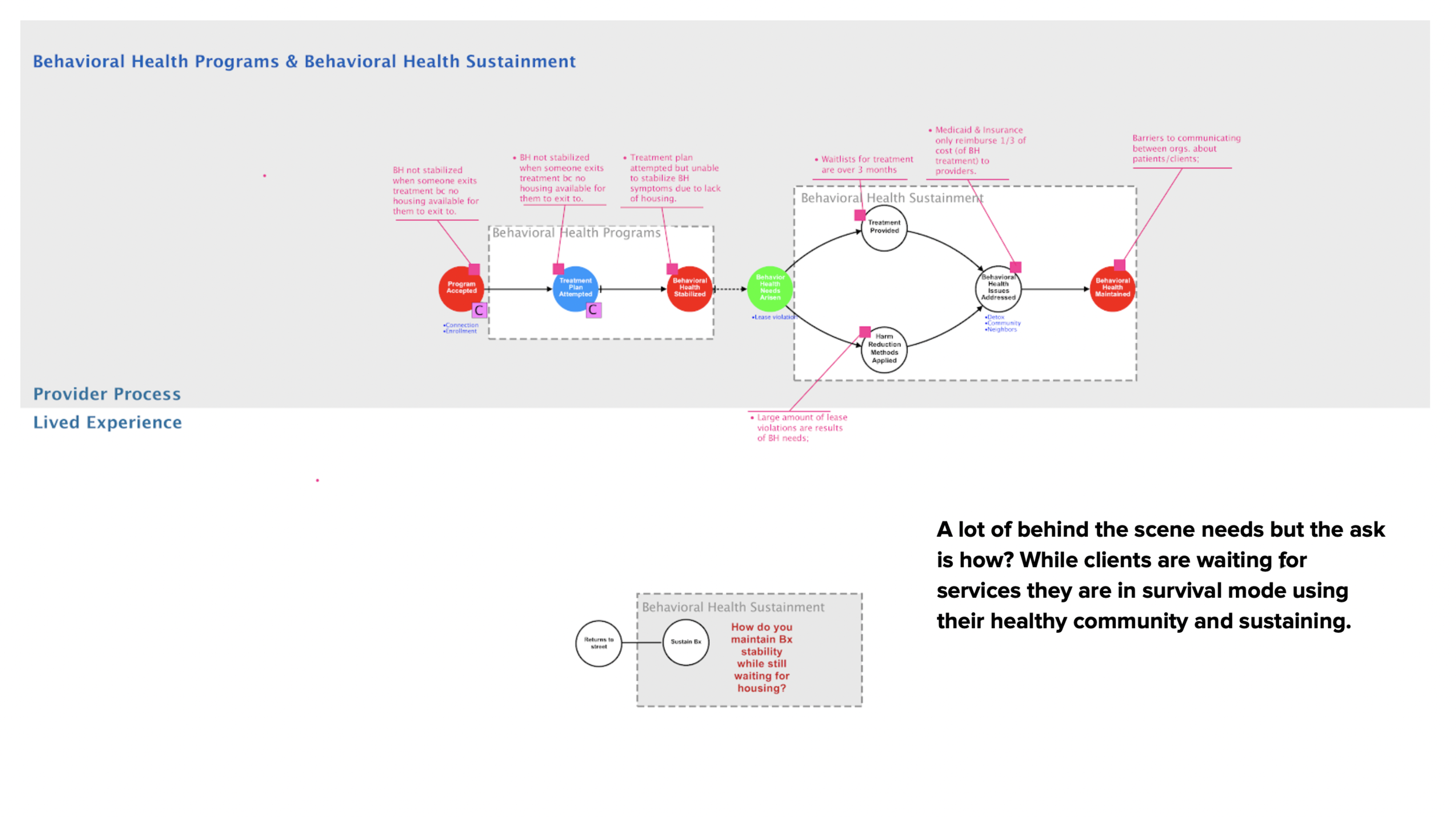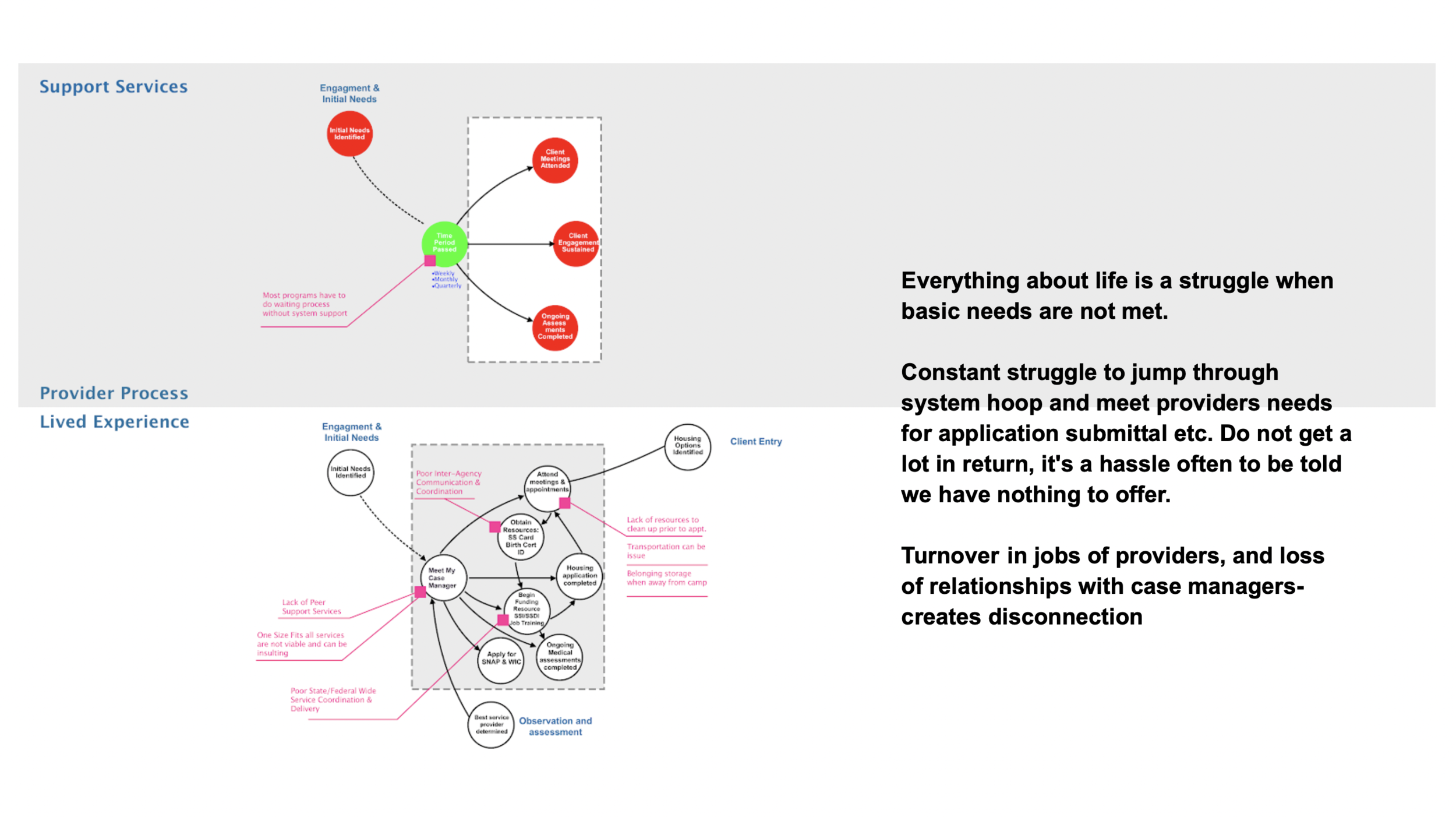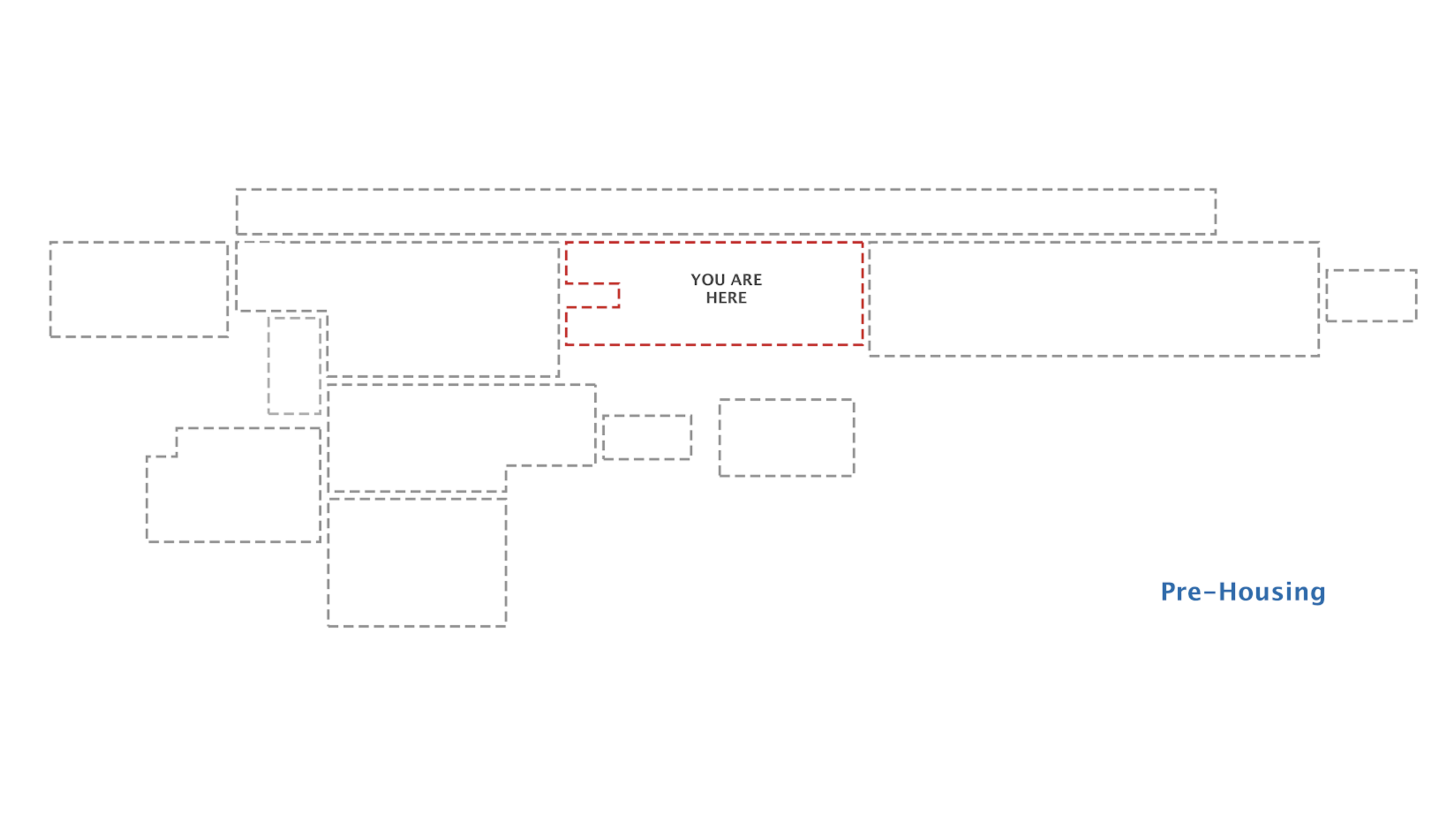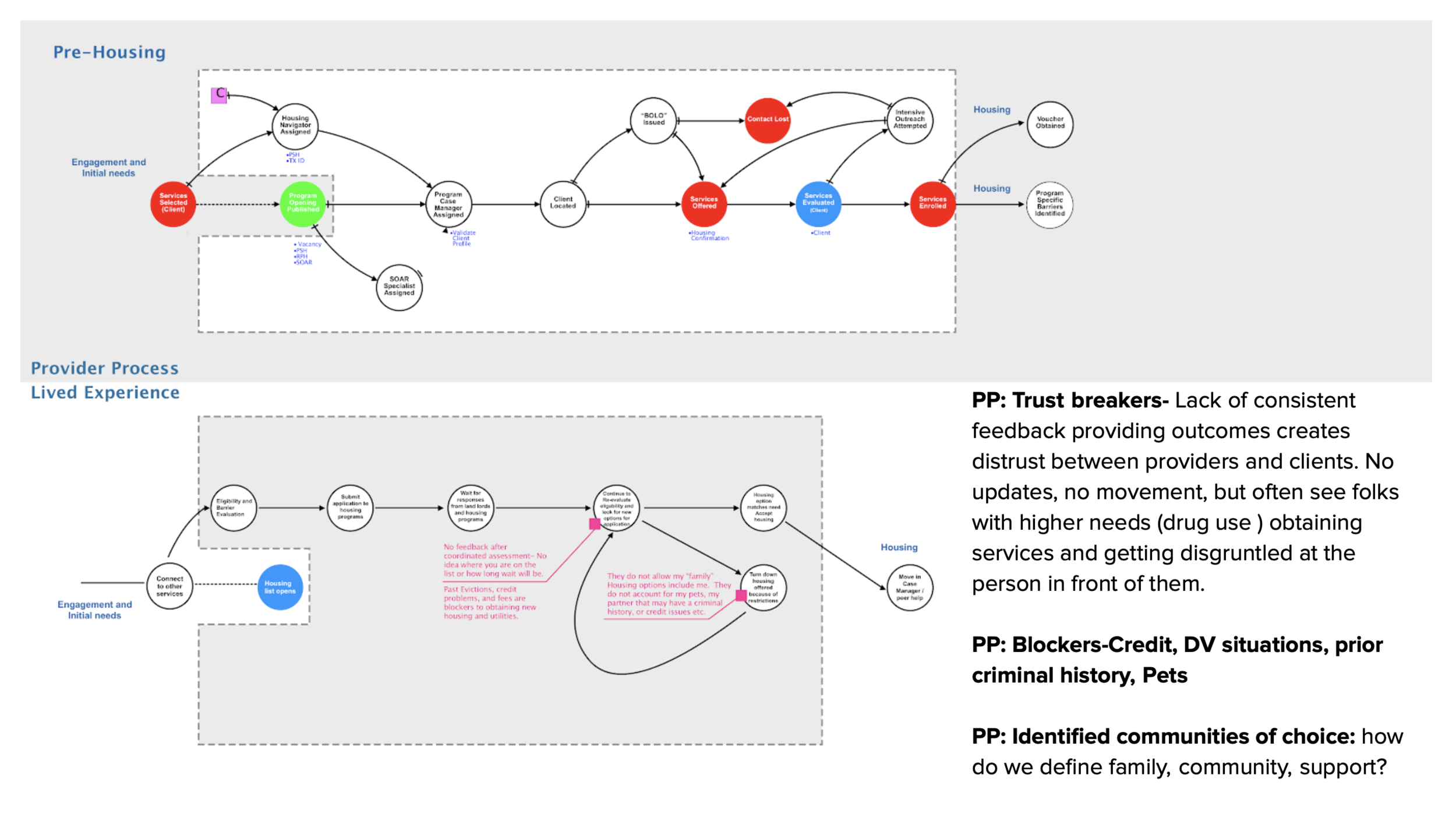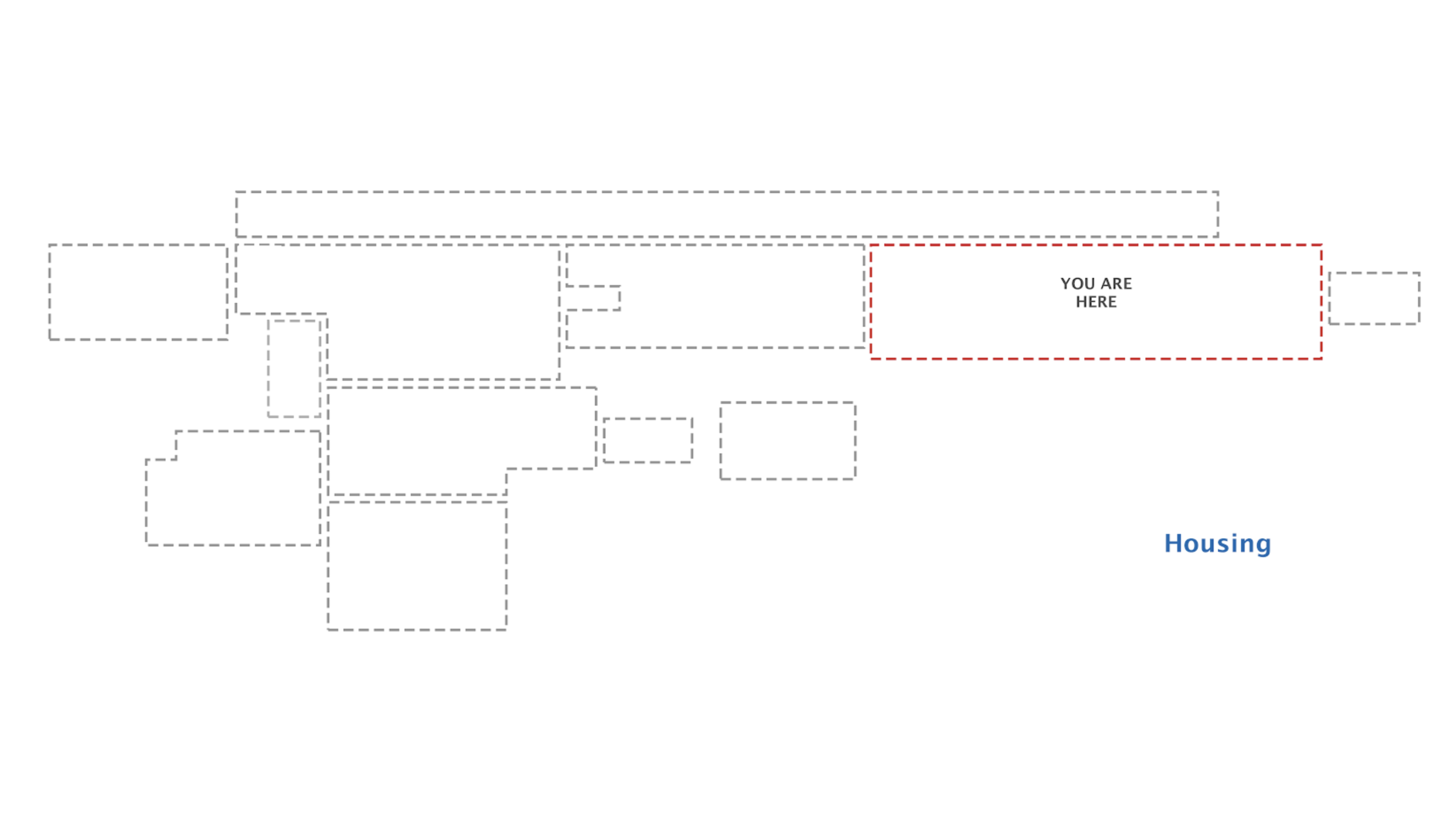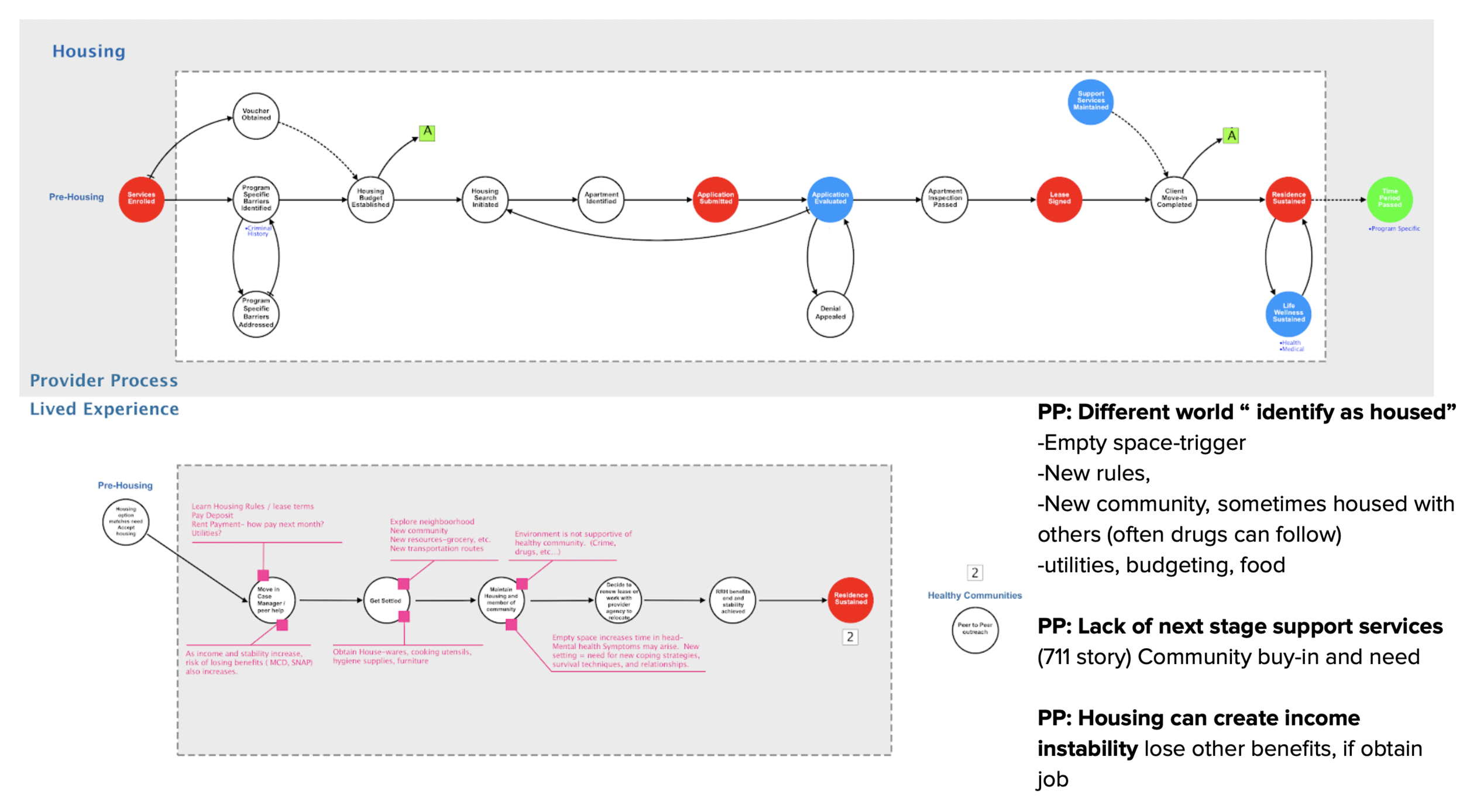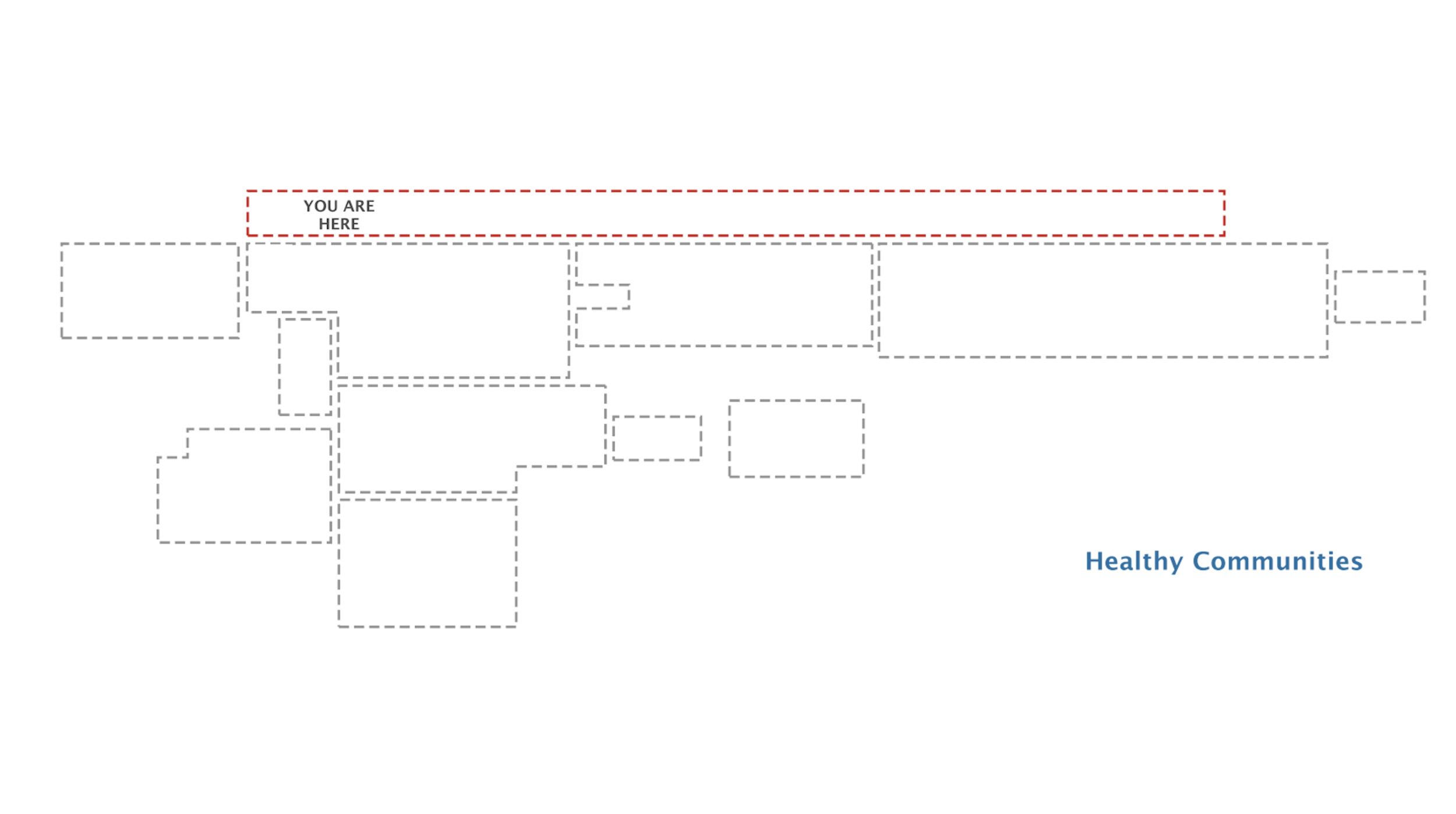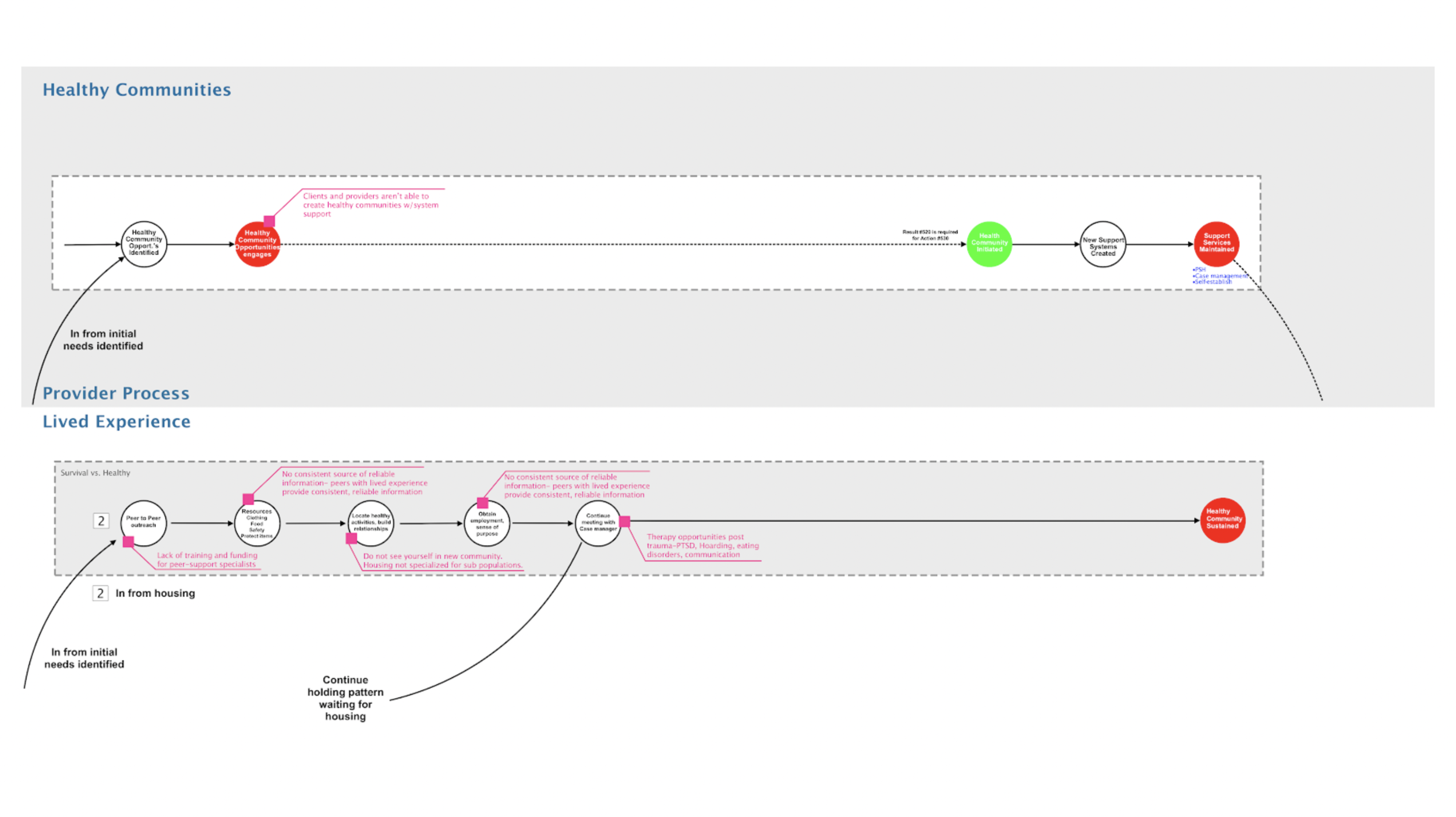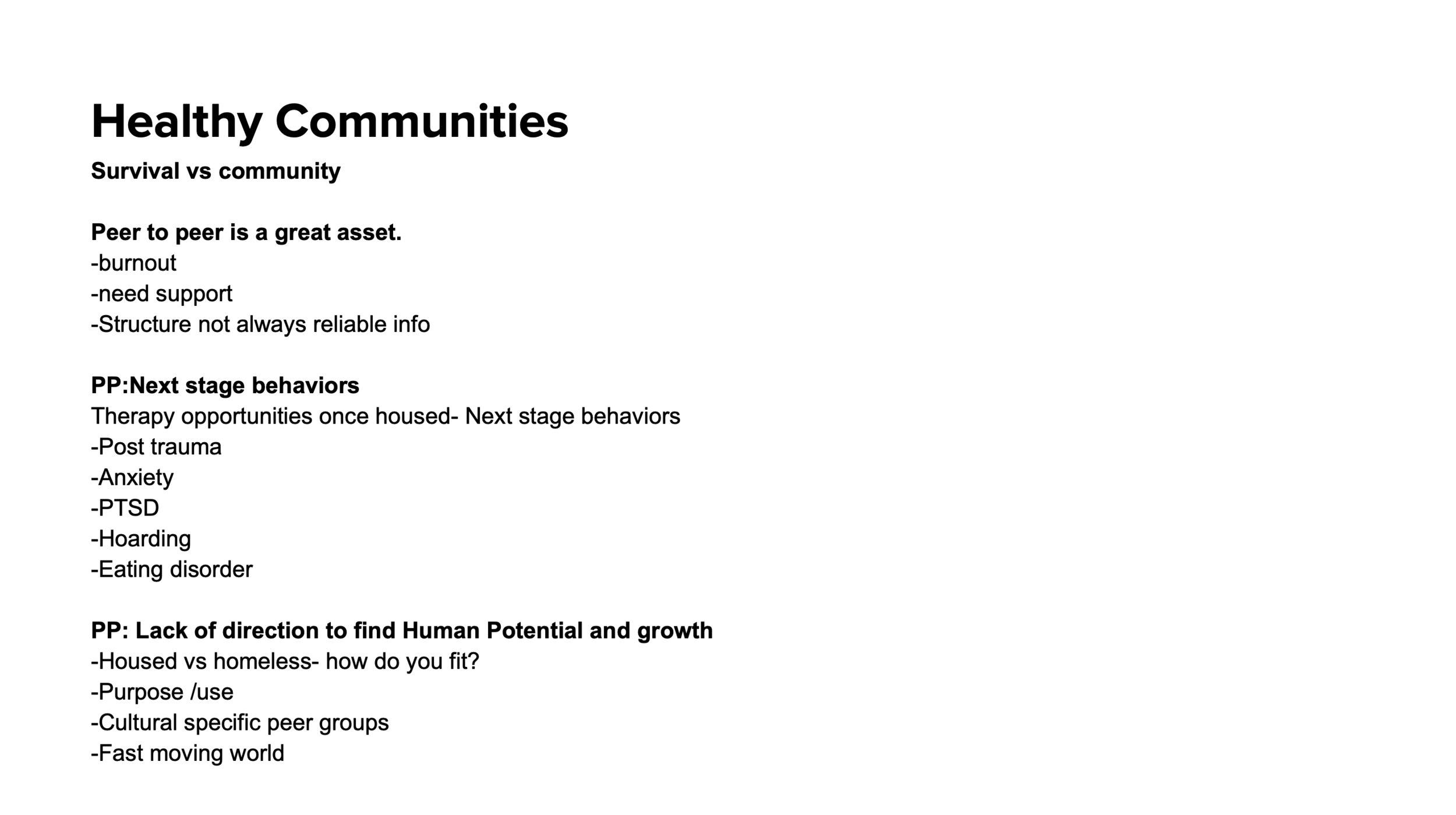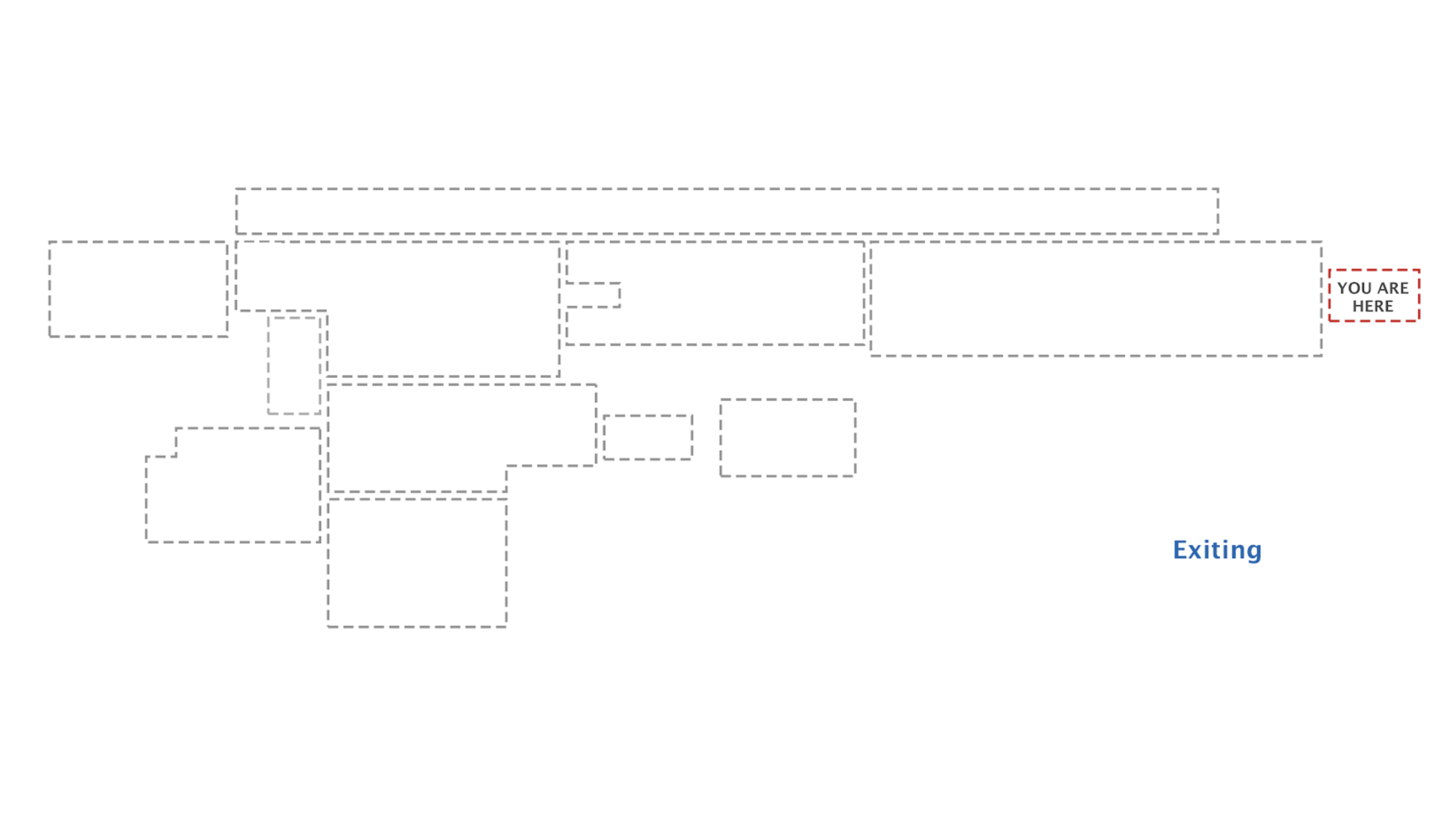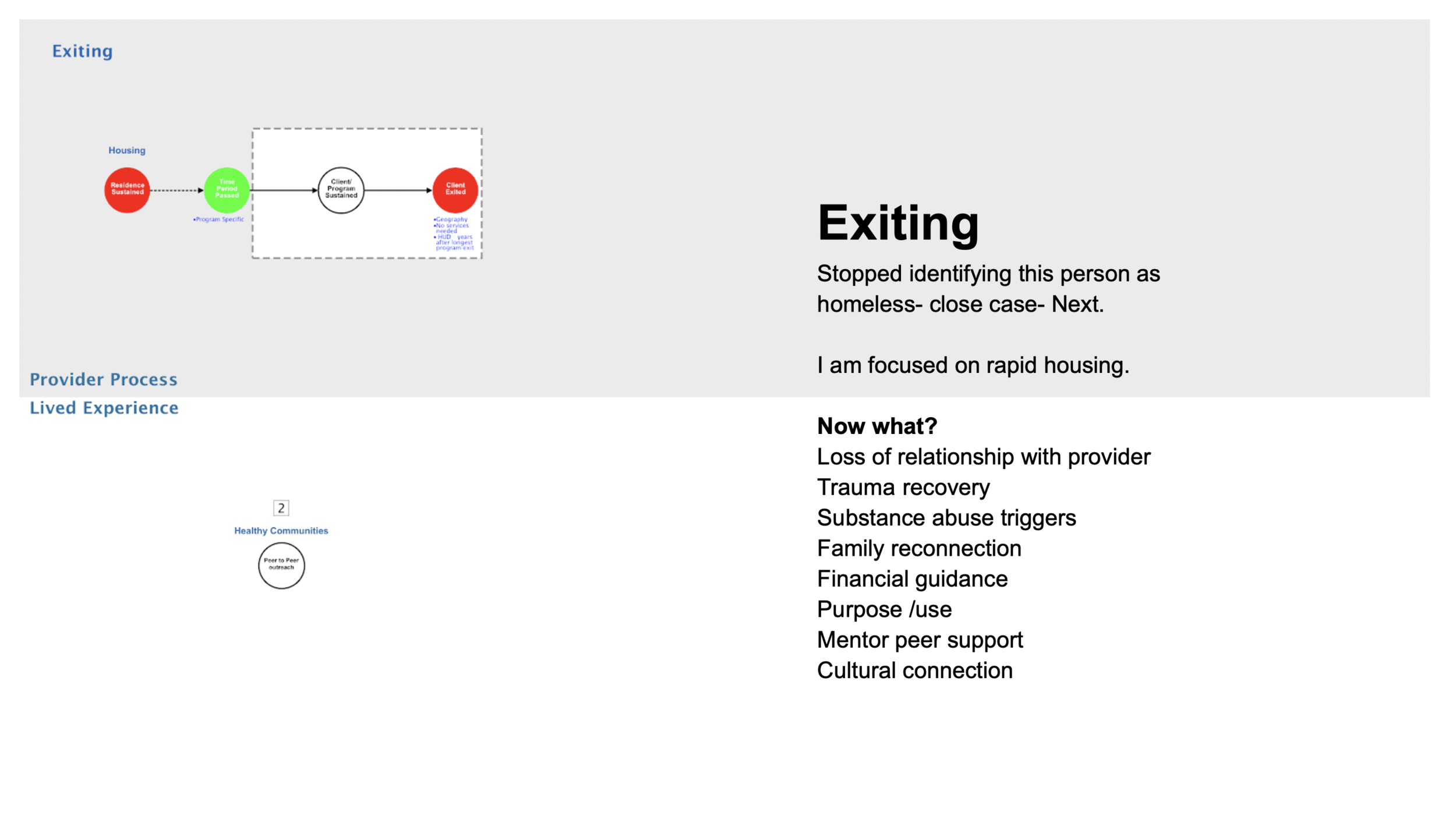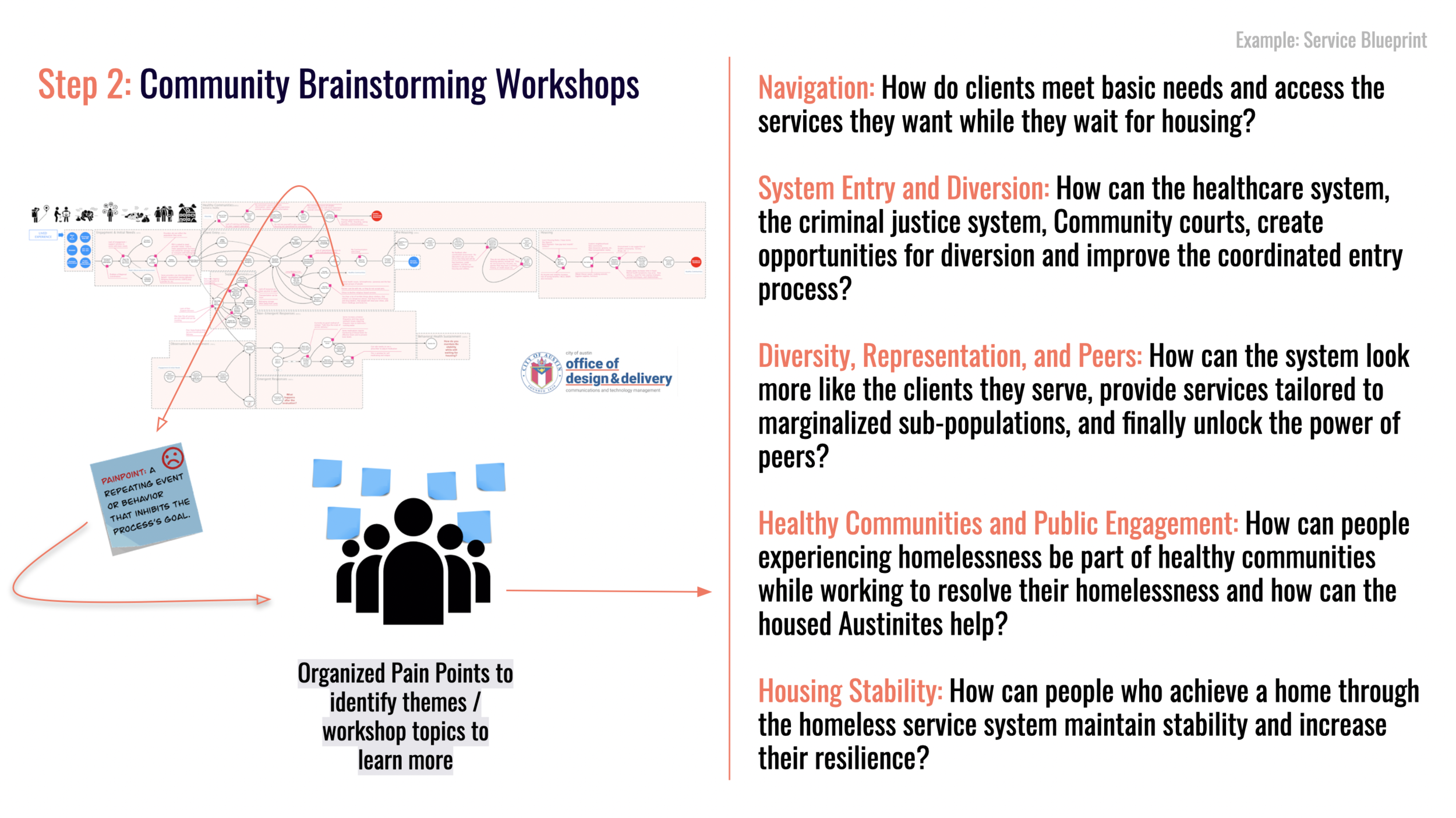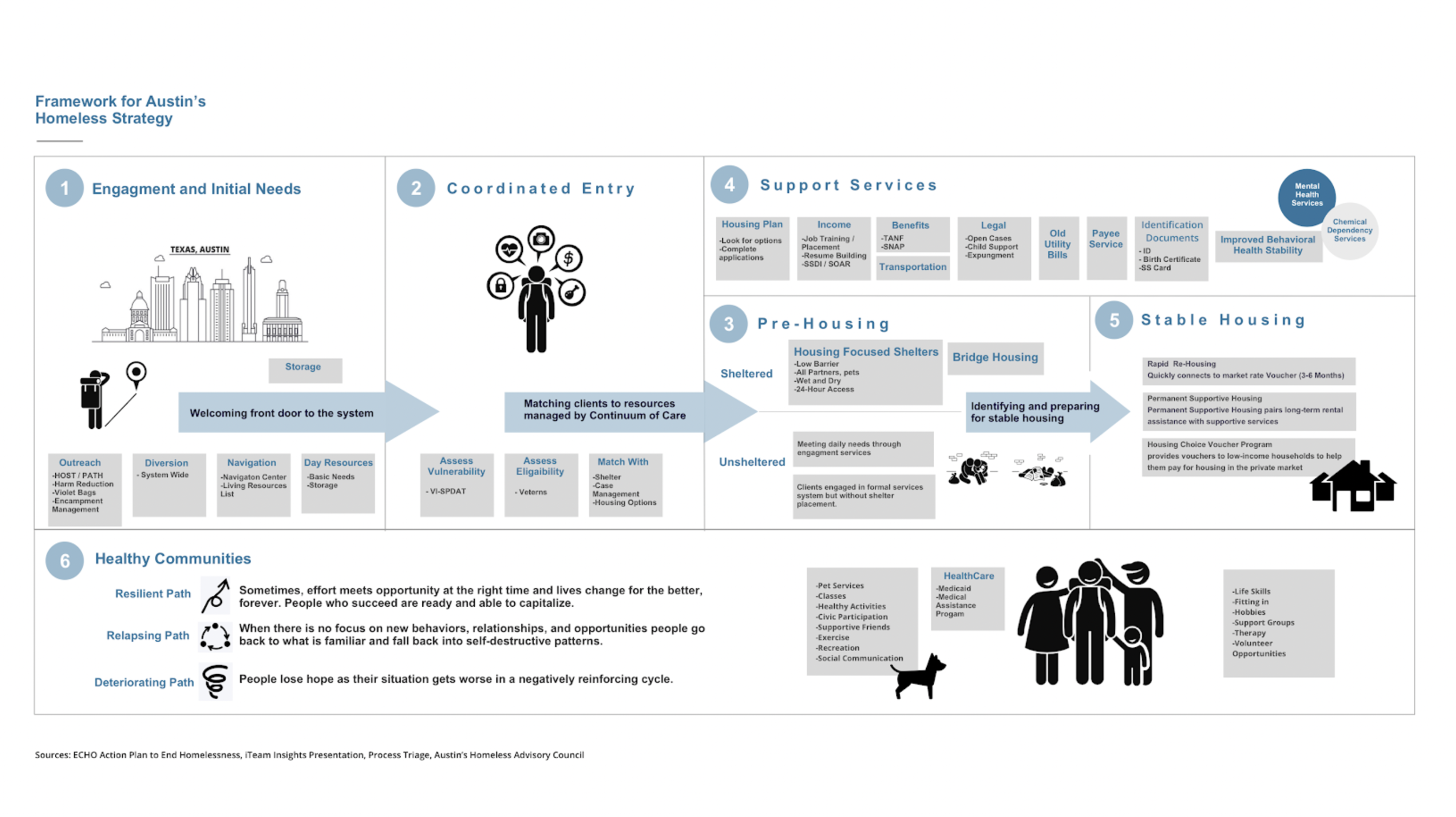My Role
Research: Stakeholder Mapping, Research Plan/Guides, Interviews, Workshop Creation & Facilitation, Synthesis & Ideation of data Design: Digital & Physical Prototypes, Physical Space Design , Service Design (guides, way-finding), Service Blueprint and Mapping Tools: Sketch / Figma / Mural / Google Docs-Sheets / material objects
The Problem
There is a growing population of unsheltered people experiencing homelessness in Austin. For many, the only immediate option is to reside in public spaces, often near creeks and storm-water infrastructure. This can pose a significant hazard to those people and may impact water quality, flooding, and erosion. However, removing an encampment on public land without providing shelter or housing options, which are not readily available in our community, ensures that people will re-encamp despite the potential dangers.
Because of the limited supply of affordable housing, success in quickly housing people is difficult and rare. The 2018 Point in Time count showed that Austin has over 2,100 people experiencing homelessness every night and that there is insufficient shelter and housing to meet their needs. While these individuals await housing, there is opportunity to scaffold community and emotional support to empower and build autonomy. People stay hopeful and confident when they can work towards goals and meet immediate needs. Without hope and resilience, they get sicker while they wait.
The Watershed Protection Department (WPD) partnered with the Office of Design and Delivery (ODD), Austin Police Department (APD), the Parks and Recreation Department (PARD) and Austin Integral Care PATH Team in a six-month pilot to design and test a standardized process for managing encampments on Watershed Protection managed lands. Their willingness to step above their day to day responsibilities and strive to find data-driven, sustainable interventions continues to inspire those who come in contact with their work. Additionally, this group has established itself as nimble and proactive innovators in the face of the evolving considerations of the effects of homelessness encampments while continuing to serve the missions of their specific agencies and to city residents.
History
Austin’s growing population of people experiencing homelessness has put a significant strain on the City’s homeless services infrastructure. An increasing portion of this population has been unable or unwilling to use the downtown shelters, opting instead to camp in open spaces. Many of these spaces are owned by the City of Austin, including sites managed by the Watershed Protection Department and the Parks & Recreation Department. Among other issues, these camps were having a direct impact on the Watershed Protection Department’s mission, particularly in relation to public safety, flood prevention, and improving water quality.
The situation was both frustrating and demoralizing. The belongings of people living at the camp sites could sometimes affect drainage infrastructure or maintenance work. In those cases, WPD maintenance crews were tasked with removing the items so that maintenance work could be performed and/or to restore capacity to drainage infrastructure. Not only did this additional and potentially hazardous work take crews away from their critical maintenance work, it seemed futile. Without alternative places for people to go and without access to services, the people living in removed encampments would often return, starting the cycle again.
WPD and PARD staff joined other city-wide planning and discussions about homelessness to learn more about the issue and to develop a better strategy for the encampments. They were involved in meetings held by TxDot to address similar issues under local highways. Along with other City Departments, they participated in Innovation Office workshops prior to budget recommendations for fiscal year 2019. By then, they had formulated the idea for a collaborative program which received $250,000 in annual funding for four years.
Identified Project Goals
Contract Prioritization
Learn more about contract requirements and coordination efforts .
Reduce additional burden on WPD field crews.
Identify locations where people can be safely provided services in place.
Reduce safety risks to homeless individuals living near creeks or in storm drain infrastructure.
Safety
Effectively engage residents at the prioritized sites in eligible services, minimize the harmful impacts of relocating, and provide supplies that support Leave No Trace principles.
Apply the Leave No Trace principles to de-prioritized encampments to monitor how these guidelines protect and human health and safety at encampments.
Health and Environment
Improve communication with residents who have questions or concerns on Watershed Protection managed land
Reduce safety risk to individuals throughout the city who may be impacted by flooding or water quality issues resulting from homeless encampments
Seek to connect individuals experiencing homelessness with social services
System Improvement
Develop and test a method for prioritizing sites for clean up
Reduce impact of homeless encampments on water quality
Reduce hazards to first responders, and to WPD staff who are exposed to hazardous materials
Minimize complaints about encampments and reduce impact on watershed property by providing collection
The Process taken to achieve those Goals
Understanding The User
User interviews are a crucial technique of the discovery & research phase of the user-centered design process. They help us gain a deeper understanding into people’s behaviors and why they do what they do. These interviews, by helping identify users’ pain points and struggles, beginto answer the problem statement.
During this project, we conducted survey, user diaries and interviews, did short intercepts at an EMS pop-up, and got input on the project from Austin Homeless Advisory Committee (AHAC). Several of the people who were interviewed for that project had lived in encampments and it was very clear from their feedback that there is a poor understanding of the reasoning and perspectives of people who are living in encampments. Some representative examples are captured on the following page.
The first of these vital takeaways was that people get sicker when services are not grounded in their realities. People are living in encampments in Austin for various reasons but our service system fails to meet their client obligations when we insist that they come to locations downtown to receive services. Transportation poses many barriers: expense, understanding of bus schedules and connections, the physical navigation required and prior knowledge necessary to plan In addition, many people don’t want to come downtown because they have warranted concerns about safety and being exposed to unhealthy behaviors. We also know that potential clients are prioritized for many services based on their vulnerability. People surviving in encampments have to be physically resilient and relatively healthy to construct, manage encampments and do the work necessary to meet their daily needs. These individuals are significantly less likely to be prioritized for case management and housing.
We also saw that providers acting in silos don’t have all the tools they need to effectively help people in the field. The police department may be able to provide security, EMS can address some immediate healthcare needs, and Integral Care can support mental health needs and connection to social services but no one organization can be everywhere or holistically support an individual. It is important to invest in collaborative processes and tools that support communication about the individuals we serve in ways that streamline the work being done instead of simply adding to it.
Understandably, people won’t accept services that aren’t designed with their social needs in mind. For example, if a person has to leave behind friends, partners, or pets to access shelter or housing, they will often decline. Day-to-day we witness how the logistics of securing care of pets and personal property can cause people to miss important appointments. If we can consider these justifiable concerns when designing services, individuals will be more comfortable and supported to access those services.
Execution and Testing of Designed Solutions
Through user research, we identified our user needs, generated ideas to meet those needs, and developed a prototype. The next step is to test the prototype to see whether it meets the user’s needs in the best possible way. Then we iterate, taking what we learned from testing and amending the design, perhaps doing so again and again.
Prototypes are low-investment, low-effort ways to test assumptions and ideas. The goal of a prototype is to test products (and product ideas) before sinking lots of time and money into the final product. Prototyping is essential for resolving usability issues before launch. It can also reveal areas that need improvement.
Rural Encampment Contract Needs
Encampment Removal PRIORITIZATION
The forced dispersal of people from encampment settings is not an appropriate solution or strategy, accomplishes nothing toward the goal of linking people to permanent housing opportunities, and can make it more difficult to provide such lasting solutions to people who have been living and sleeping in the encampment.
Providing lasting solutions and ending the homelessness of people living in encampments requires a thoughtful, coordinated, and collaborative plan and process to ensure that people can be linked to appropriate housing options.
City of Austin: Watershed Homeless Program
Goals
Address Public Concerns
Feedback from neighborhood residents and businesses
Reduce 311 call complaints about trash, litter, or the homeless in identified parks
Reduce safety risks to homeless individuals living near creeks or in storm drain infrastructure
Collection
Interview ARR truck operator about their experiences as well as pain points, insights, and recommendations
Distribution: Test the efficacy of bag kiosks vs. Portable
Test pick up at Parks on residential schedule
Engagement
Effectively engage site residents at the piloted sites in collection guidelines and safe disposal practices.
Interview people living at piloted sites and synthesize learnings and recommendations.
We Tested using the Leave No Trace principles in a well established pilot site with the intention of improving and maintaining the health and safety of encampment sites as the city grows. With the goal of avoiding encampment site complaints and resident displacement (clean-up), and facilitate connections between site residents and services.
We provided needed items to residents experiencing homelessness, so we can find a lasting solution that works for them in obtaining their goals, while meeting watersheds needs. Using the Principles we created a prioritizing guideline for Watershed / parks and Austin police can follow when working with a homeless encampment.
Further Project Details
Violet Bag program
There are significant efforts in Austin to provide adequate shelter and housing for all residents. However, there are more than 1,000 Austinites sleeping on the streets every night and many of these individuals are in semi-permanent encampments. In order to preserve human and environmental health and safety, these encampments need access to regular garbage collection. Through the Violet Bag Pilot Program, the City of Austin has developed an adaptive, interdepartmental model that leverages existing resources, collaborates with site residents to meet shared goals, and integrates outreach specialists to ultimately resolve encampments by ending the resident’s homelessness.
Goals
Engagement
Effectively engage site residents at the piloted sites in Violet Bag collection guidelines and safe disposal practices.
Interview individuals living at piloted sites and synthesize learnings and recommendations.
Test harm-reduction engagement and service linkage at specific sites to improve compliance with sharps containers.
Collection
Document the number and pounds of bags collected
Interview ARR truck operator about their experiences as well as pain points, insights, and recommendations
Test the efficacy of bag kiosks vs. distribution during outreach
Address Public Concerns
Feedback from neighborhood residents and businesses
Identify 311 call patterns and reduce call complaints about trash, litter, or the homeless
Reduce safety risks to homeless individuals living near creeks or in storm drain infrastructure
Bag Distribution Kiosks
During the Violet Bag Pilot we started by testing 16-30 gallon, 1.5-millimeter thick violet bags. Approximately 2,000 of these bags were distributed. By offering bags and regular collection, we know that people were able to dispose of more garbage in an appropriate manner.
The pilot sites were initially selected based on the volume of garbage-related complaints located at those sites. As part of the pilot, we wanted to continue using 311 data to gauge our impact and hoped to see complaints decrease in this time frame. ODD and 311 have developed a process to analyze the call notes and look for patterns in the frequence of the terms used in a call.
We consistently found that site residents were very supportive of the project. Managing garbage at encampments is something people have been trying to do without organized support. In the past, some residents piled trash in specific areas for removal from their encampments, an unsightly solution easily disrupted by wind. Encampments also sporadically receive trash bags from neighbors or outreach workers, but encampment residents do not have a consistent, legal way to dispose of the trash that they collect. This pilot solves both of these problems.
Feedback from the site residents was positive and the number of bags collected at the original outreach sites increased. In our field interviews, we found that encampment residents used the supplies appropriately and complied with the expectations of the pilot. In addition, the placement of a kiosk at these two sites allowed the pilot team to more efficiently allocate their time and resources because site residents were consistently using a large amount of bags to pick up trash without having to rely on in-person distribution.
Site residents and Austin Resource Recovery staff made several suggestions to modify and improve future kiosks. Adding sharps containers to all of the kiosks would provide a permanent, safe method to dispose of needles. Similarly, there are dogs present at most sites and adding dog poop bags to the kiosks would encourage residents to pick up after their pets and provide them with the tools to do so.
The kiosks could continue to evolve to help residents meet a number of basic needs that support community health and safety. Some of the ideas from residents and the project team included ways to facilitate communication like adding a message board and an emergency call box. At many of the kiosk locations it may also be possible to add outlets to help residents charge phones and water taps so residents have a clean, reliable source of drinking water.
Site Garbage Collection
To inform site residents about the pilot and restrictions on what is and is not approved for collection with household waste, we created information cards and posted signs at the collection sites.
After the first phase of the pilot, ARR made some adjustments to the collection schedule and began experimenting with collection containers at some of the sites. The collections at each site have increased to twice a week to help keep bag volumes low. ARR staff is also checking and filling the kiosks at each site.
The maximum one-time volume of garbage recorded at each site during collections ranged from 60 bags at Cameron Road to a maximum of six bags at Ohlen. With these figures, we estimate that 50-80% of the bags distributed were collected by ARR or PWD Contractors. PWD staff also reported that the time spent at each of these sites during the monthly clean-up was reduced significantly which has cost saving implications for the City.
Outreach
As part of their work, the PATH team visits encampments around Travis County on a regular basis, including the pilot sites. At all sites, outreach is crucial in developing trust and communicating about the project, as well as connecting site residents to services. Over the course of the pilot we met several site residents who use needles and were enthusiastic about safe disposal options.
Data Collection
With the heightened attention and public awareness of homelessness this summer, it is not possible to attribute variation in call volumes in four sites to the Violet Bag Pilot. Google Trends show that searches for “homeless Austin” peaked in July with a strong association to searches for “ordinance” and “shelter.”
Between May 2018 and April 2019, the average monthly 311 call frequency of the word “garbage” in homelessness-related calls was 180, with a standard deviation of 28. At no time during the two months preceding the pilot did the frequency fall into this “normal” range. During the pilot the frequency peaked at 312 in July before returning to pre-pilot levels in September.
Public Feedback
We also collected public feedback about the pilot through a dedicated email address. We received numerous emails directly from members of the public, all of which supported the pilot. Their messages included inquiries about trash receptacles, recycling and composting in the project, and requesting collection locations in their neighborhoods.
People were also very interested in finding a way to be involved, donate, or otherwise support the project. Over the last few months there have been a number of anecdotal incidents of resident-initiated garbage collection projects or cleanups in neighborhoods around the city. In an interview with a resident who has organized multiple cleanups, we found that proactive programs like the Violet Bag Project are necessary to sustain Austin spaces and to bridge the gap between policies and action. Additionally, the resident mentioned that many people would be interested in getting involved and recommended gathering volunteers through word of mouth. Going forward, certain sites may present good opportunities to include volunteers.
Further Project Details
Service Navigation
The Office of Design and Delivery (ODD) partnered with Downtown Austin Community Court (DACC) and Austin Public Health (APH) on a six-week pilot to prototype and test a service navigation center for people experiencing homelessness. Overwhelmingly, staff and service providers recognize that there is a lack of resource navigation for homelessness services. The funding for this pilot came from former Assistant City Manager Sarah Hensley’s direction to pilot a navigation center with a portion of the discretionary funds that were allocated to the City Manager to address homelessness in Fiscal Year 2019.
Service Navigation Center Website
Further Project Details
In this pilot, we sought to test the idea that a drop-in service navigation center could offer a front door to services for individuals experiencing homelessness or at risk of homelessness. Non-case carrying social workers were available to provide a lightweight version of case management to help individuals experiencing homelessness put together a plan of action and refer them to the appropriate services.
We believed that with one-on-one planning and accurate information about resources people experiencing homelessness would be able to complete enrollment for eligible services and improve their own self-sufficiency. System-wide, the navigation center will give our community a physical entry point for and direction to homelessness services, diversion for those in crisis situations, better day-to-day knowledge of the available services, and ultimately improve an individual’s ability to access the services that will enable them to resolve their homelessness.
Lived Experience Mapping
Provider Service Mapping
Over the last two years, the City has started actively engaging people experiencing homelessness in creating solutions, with the goal of revolutionizing our service delivery model to meet the needs of the people we are trying to serve and not the needs of the system we have created.
We looked at the identified users of the Homeless service system and created a representative service blueprint that describes an ideal system and identifies barriers to that ideal state (pain points). We then layered on top the same “backend” blueprint, with the service providers current system and pinpoints. This allowed us to get a full system snapshot of front end and back end homeless services delivery in the City of Austin.
Further Project Details
